Up for a 5:30 breakfast before shoving off for a final market, then continuing the five-hour drive to Vishakhpatnam airport and my flight to Delhi. After a layover of eight hours during which I’ll have a room at a Marriott, I continue on my non-stop flight to Chicago. Fro, the time I depart for the market to the time I land at O’Hare will be thirty-six hours. Fun, huh?
I love driving through my home village. Somebody is working on a mandala outside her front door to welcome the goddess. Mandalas will be done each day for a month during the holy month of kartikha, named for kartik, eldest son of shiva, that is being celebrated now.
The market is at kunduli, and is only on Fridays. Peroga and Mali and Jaria and Perenga tribes come to this market. While the market has the typical fruit and vegetable sellers, like the other market we visited, they also have a large goat, sheep and cow sale area. 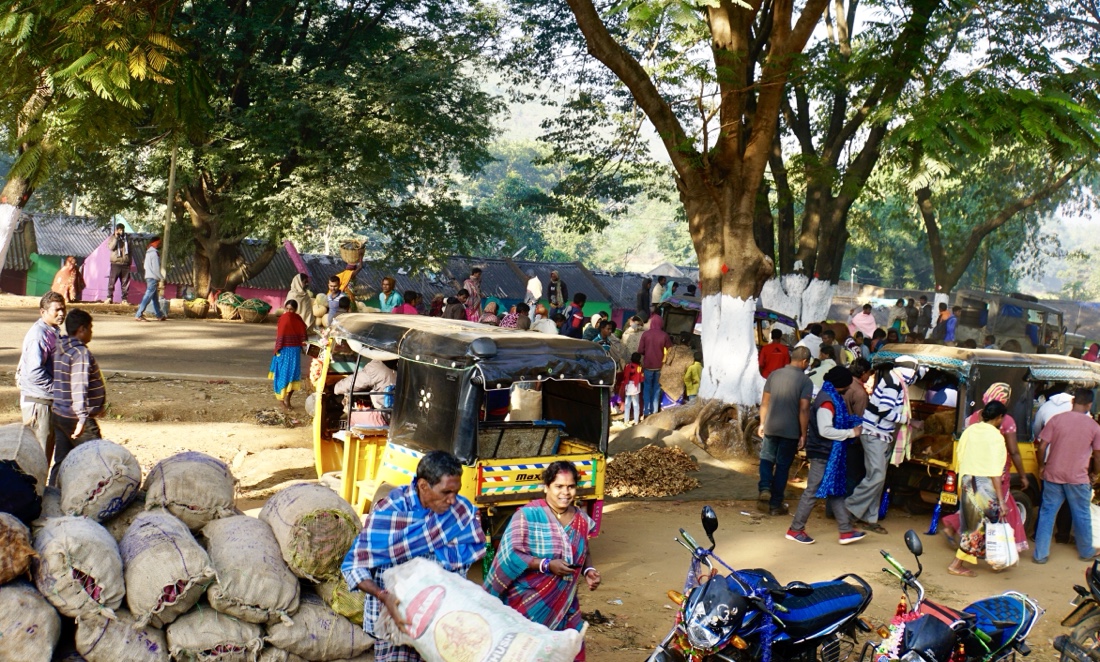 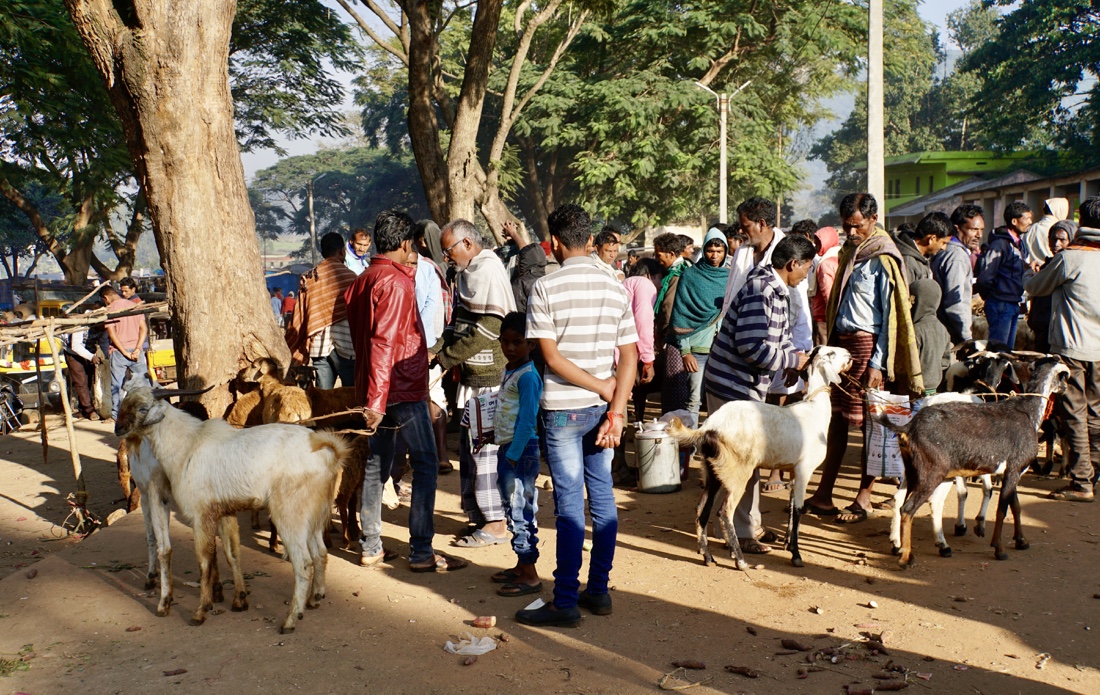 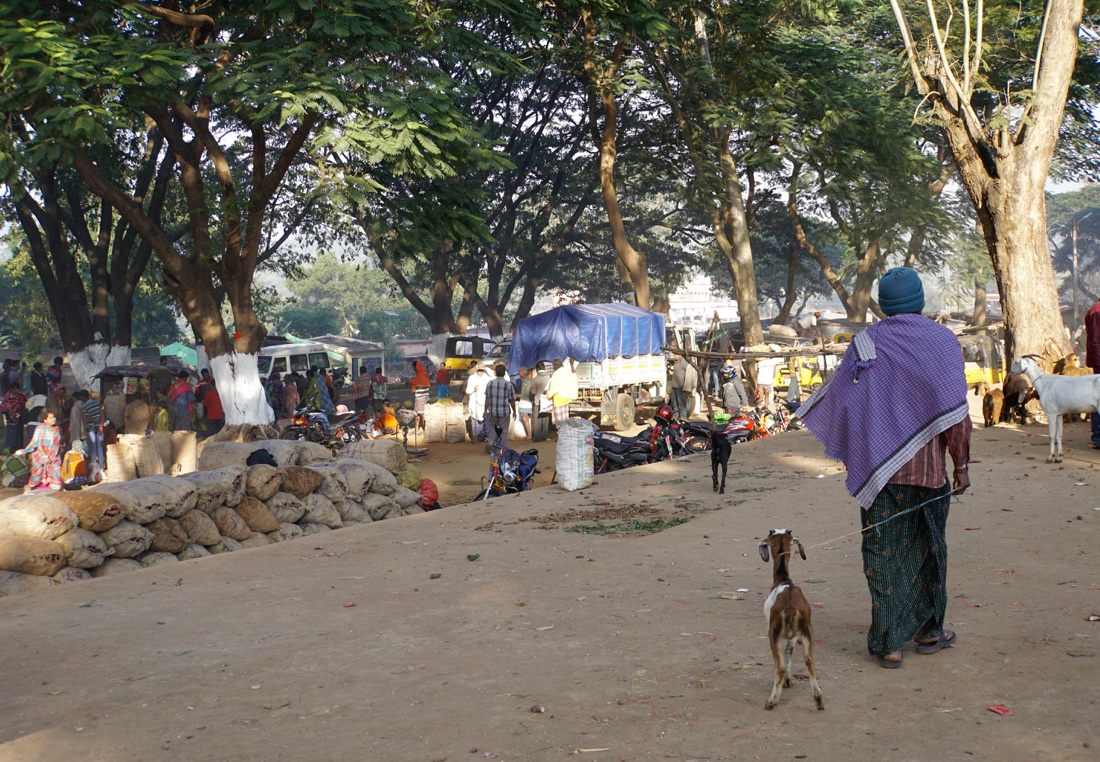 We spend our time in the goat and sheep area, and it is very interesting and fun to watch the negotiations as they take place. It’s a far more active and lively market than the more staid fruit and vegetable markets. Both the seller and the buyer hold their money out in their hands to make offers, and bicker back and forth, sometimes heatedly. We spend our time in the goat and sheep area, and it is very interesting and fun to watch the negotiations as they take place. It’s a far more active and lively market than the more staid fruit and vegetable markets. Both the seller and the buyer hold their money out in their hands to make offers, and bicker back and forth, sometimes heatedly. 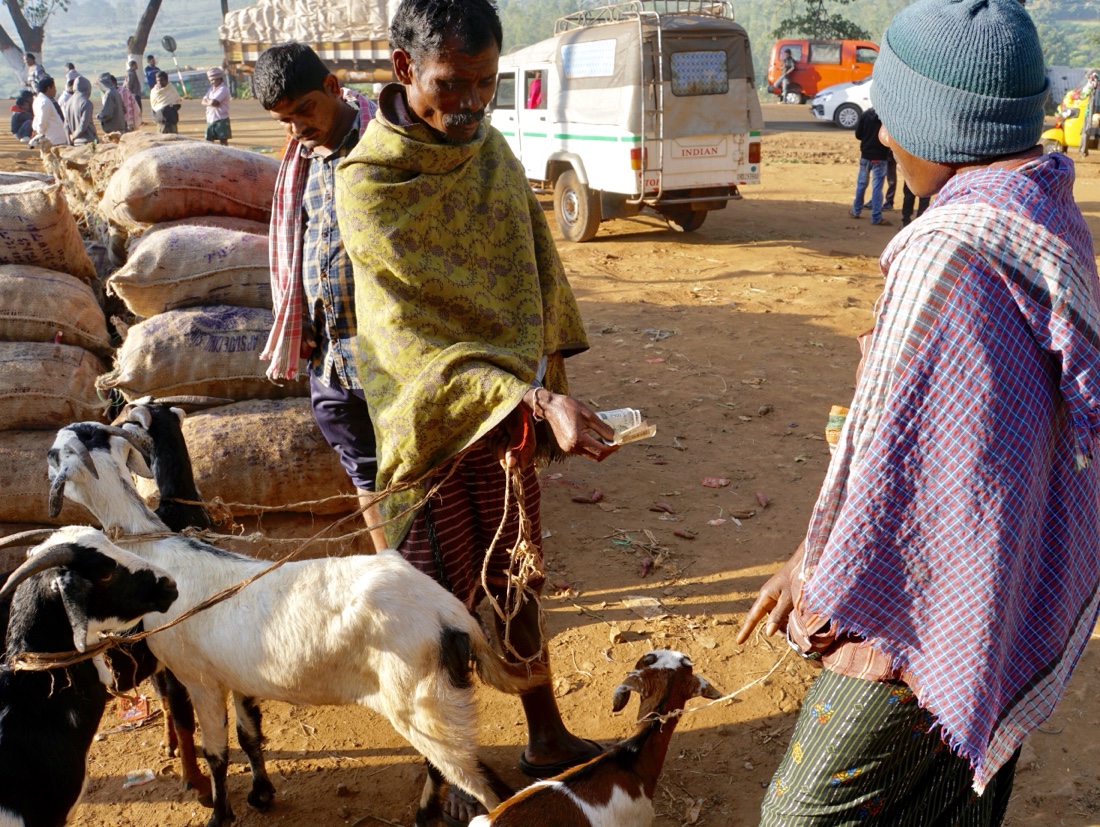 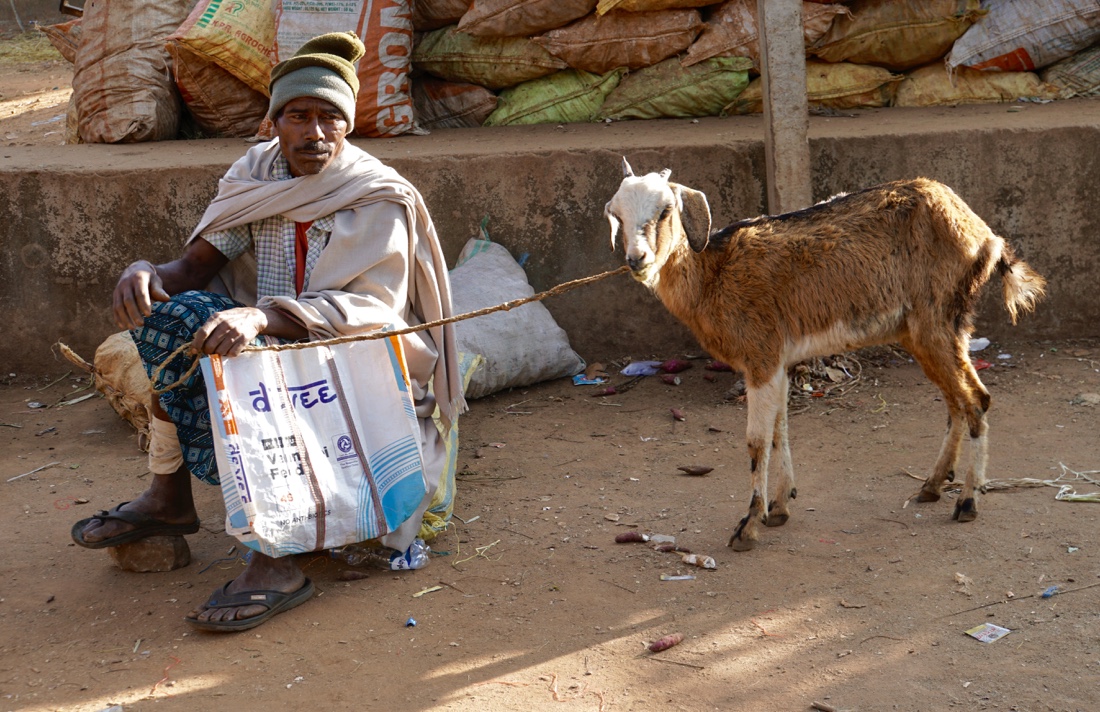 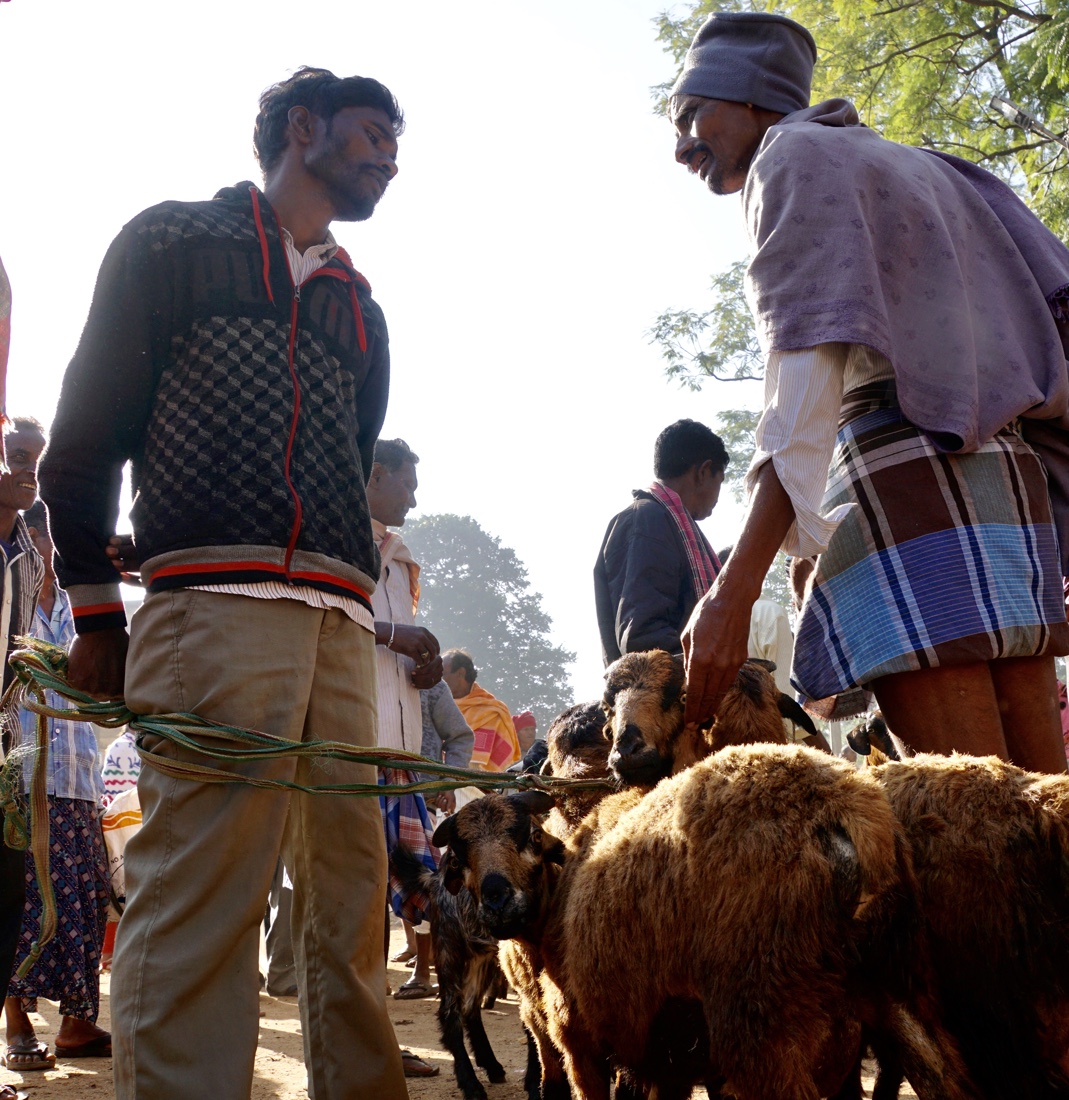 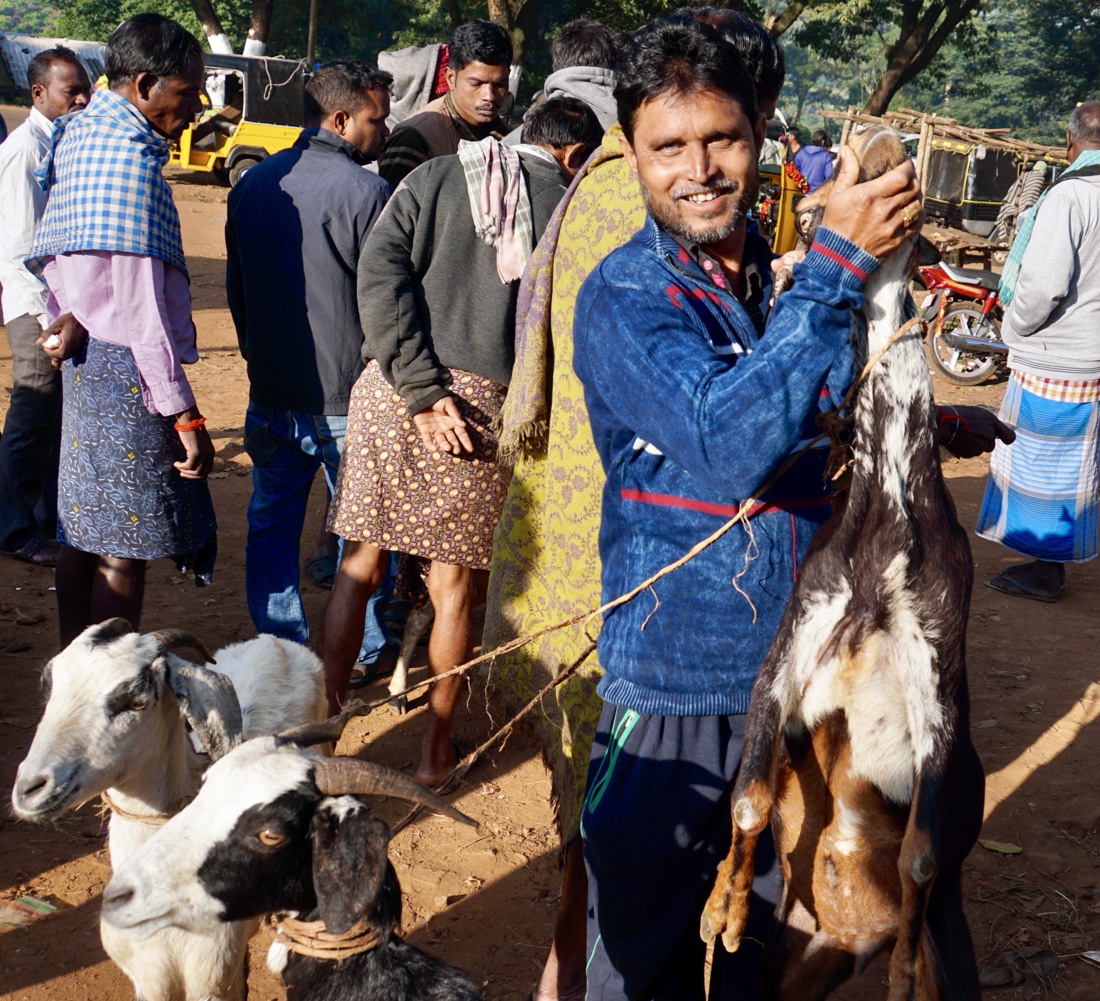 In many cases, there is a middleman present who speaks the local dialect of the seller as well as the general language. He attempts to get the parties to reach agreement. Many men wear colorful lungi that look like pajama bottoms. In many cases, there is a middleman present who speaks the local dialect of the seller as well as the general language. He attempts to get the parties to reach agreement. Many men wear colorful lungi that look like pajama bottoms. 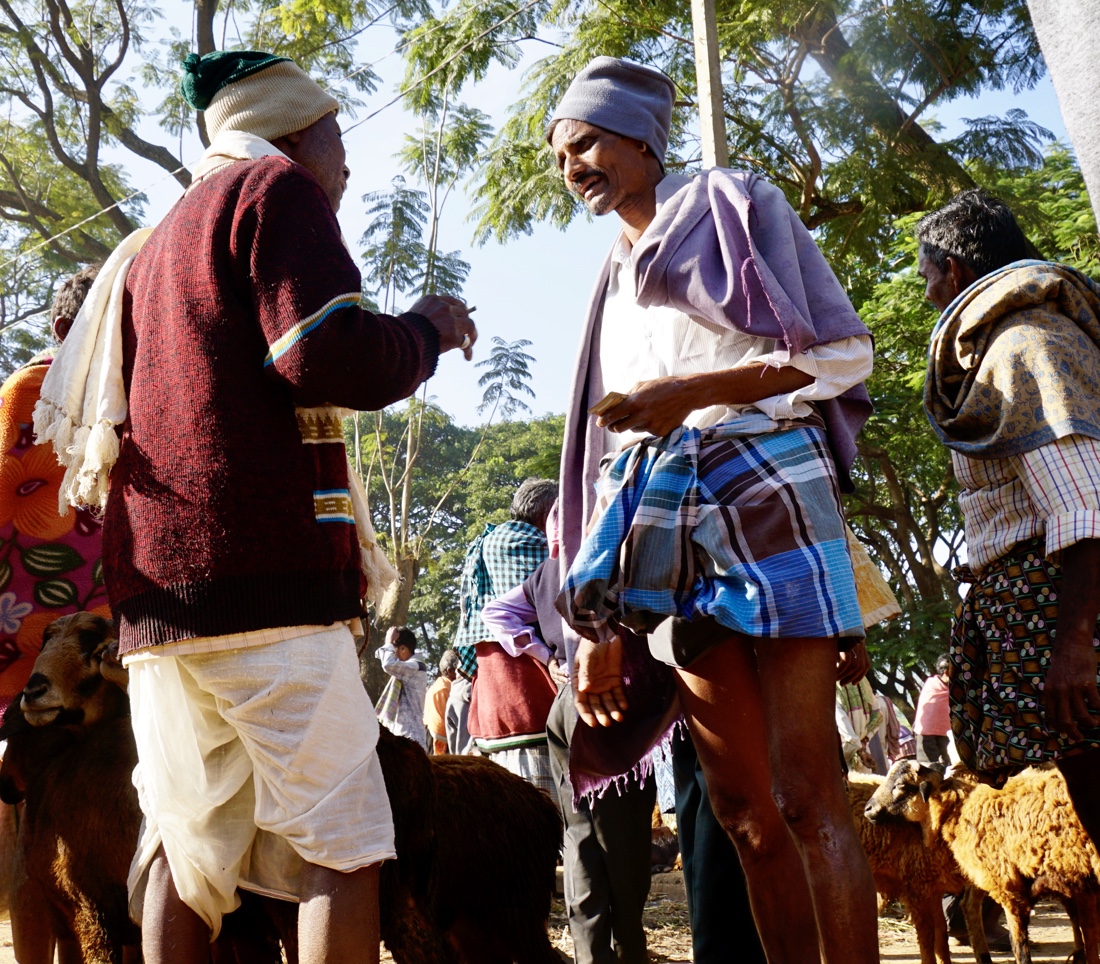 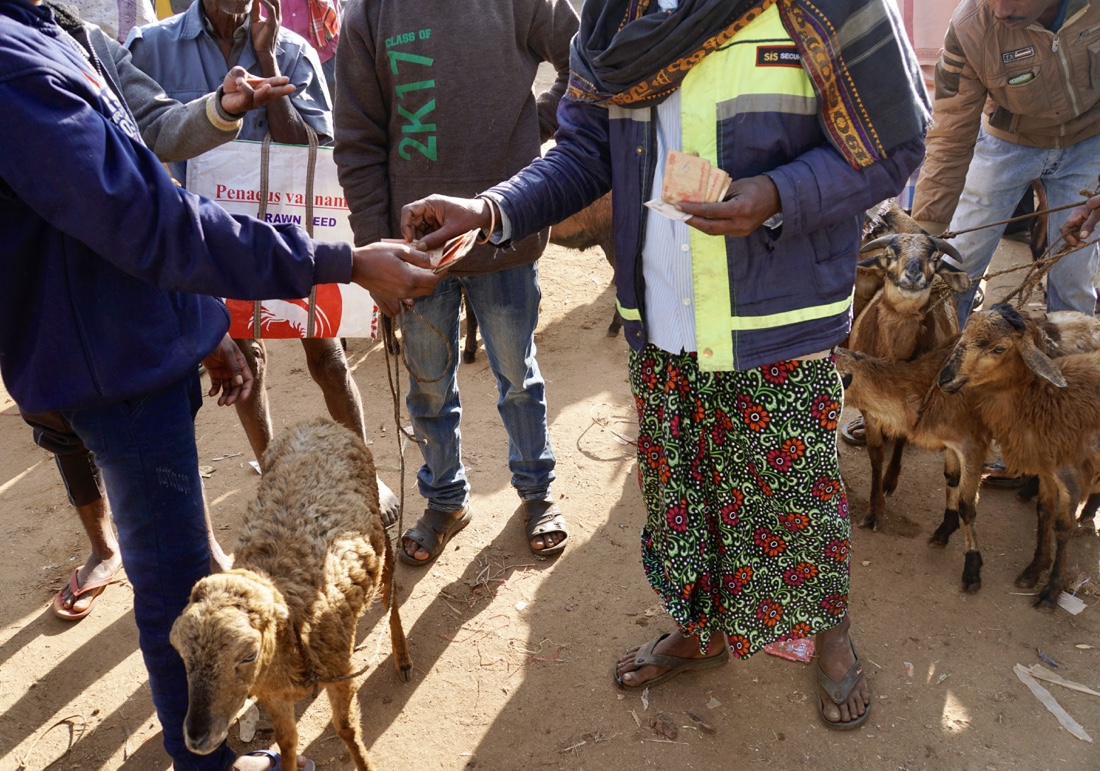 Though the goat prices seem quite reasonable to me, I resist the temptation. So, I guess you could say that I let somebody else get my goat. Though the goat prices seem quite reasonable to me, I resist the temptation. So, I guess you could say that I let somebody else get my goat.
We pass into the state of Andrapradesh, which used to include Telegana, which was split off some five years ago. Hyderabad is the capital of both states. We are headed for Vishakhpatnam, which has a population of more than three million people. Stop for lunch near airport, then proceed to check in. Took an hour to get my Delhi-Chicago boarding pass and was beginning to think Air India had scored me up again. Fortunately, it apparently was only good old-fashioned incompetence.
My flight to Delhi arrived early and I was met and driven to the J.W. Marriott, five minutes away, actually twenty-five in the heavy traffic. I have a comfortable room for five hours and then will be picked up and driven to the airport for the long flight home.
I’m going to post this now, and try to write some reflections on the trip, en route home.
October 25
We set off at 6 AM for the Bonda market, in Onkudelli, a drive of some three hours. The market happens every Thursday., and also attracts gaddaba,didaye,Mali and Raina tribes. On the road, we pass four men toting heavy double loads of firewood.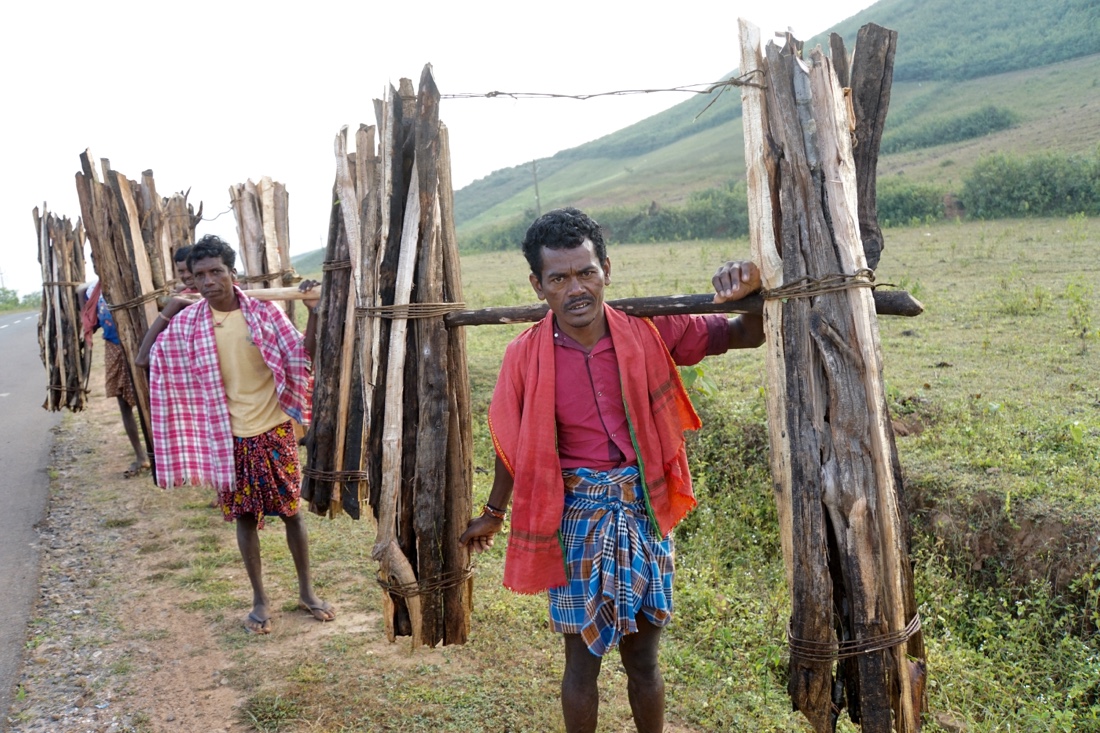
There are approximately 6000 members of the Bonda Tribes–one of the most fascinating tribes of India. They live in the remote hills and keep themselves totally isolated. They grow rice by shifting cultivation and keep domesticated cows and goats. They can only be seen when they come to trade at the local weekly Thursday market.
In Bonda society, the women enjoy a privileged position. They are the primary workers and providers of food for the community. Bonda girls largely marry boys who are at least five to ten years younger than them. Thus the girl looks after her husband as he grows up and in turn he cares for his elder wife. In contrast with many other populations in India, the number of women among the Bondas greatly exceeds the number of men.
The Bonda are generally semi-clothed, the women wear thick silver neck bands. The Bonda attire is explained in a legend relating to the Ramayana. According to it, some Bonda women chanced upon Sita who was bathing at a pond in the Bonda hills and, seeing her naked, they sniggered. Enraged, Sita cursed them to a life where they would be condemned to remaining naked and having their heads shaven. When the Bonda women pleaded forgiveness, Sita gave them a piece of cloth she tore off her Sari.
Bonda women have their heads shaved and adorned with two types of headbands, called turuba and lobeda. The turuba is made of grass and the lobeda made of beads.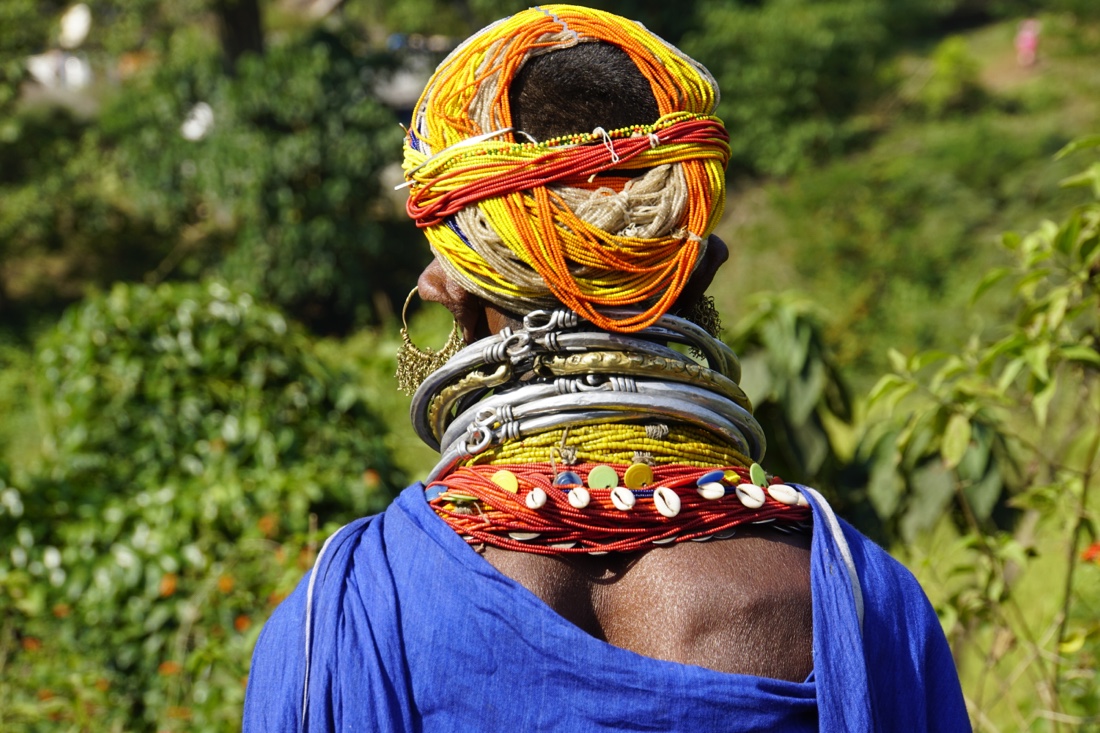 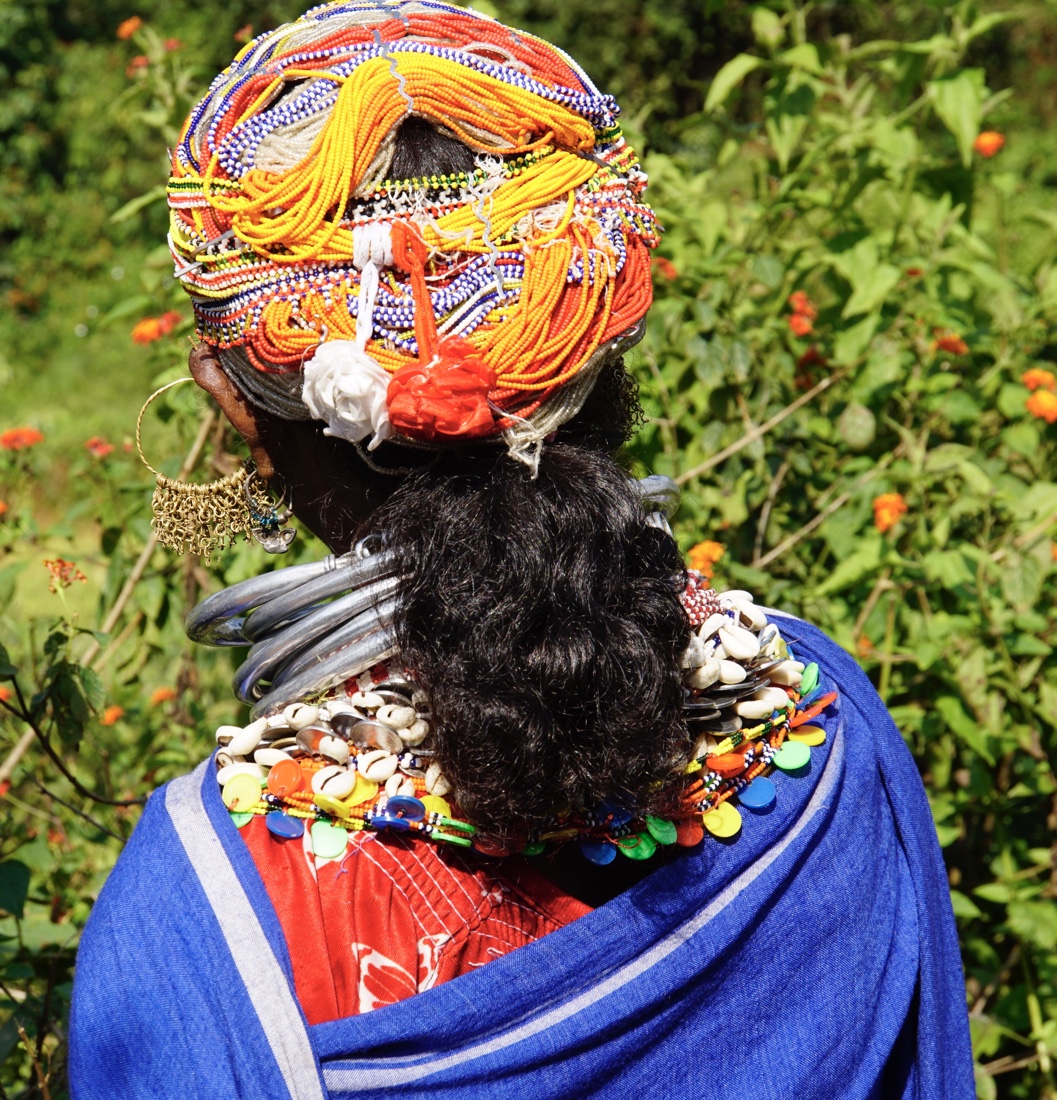
They wear only a ringa, a length of cloth that covers the waist. Their torsos are covered in strings of colourful beads. Bonda women also wear metal rings that cover their necks, which are called khagla and are made from aluminum, and bangles on their arms. 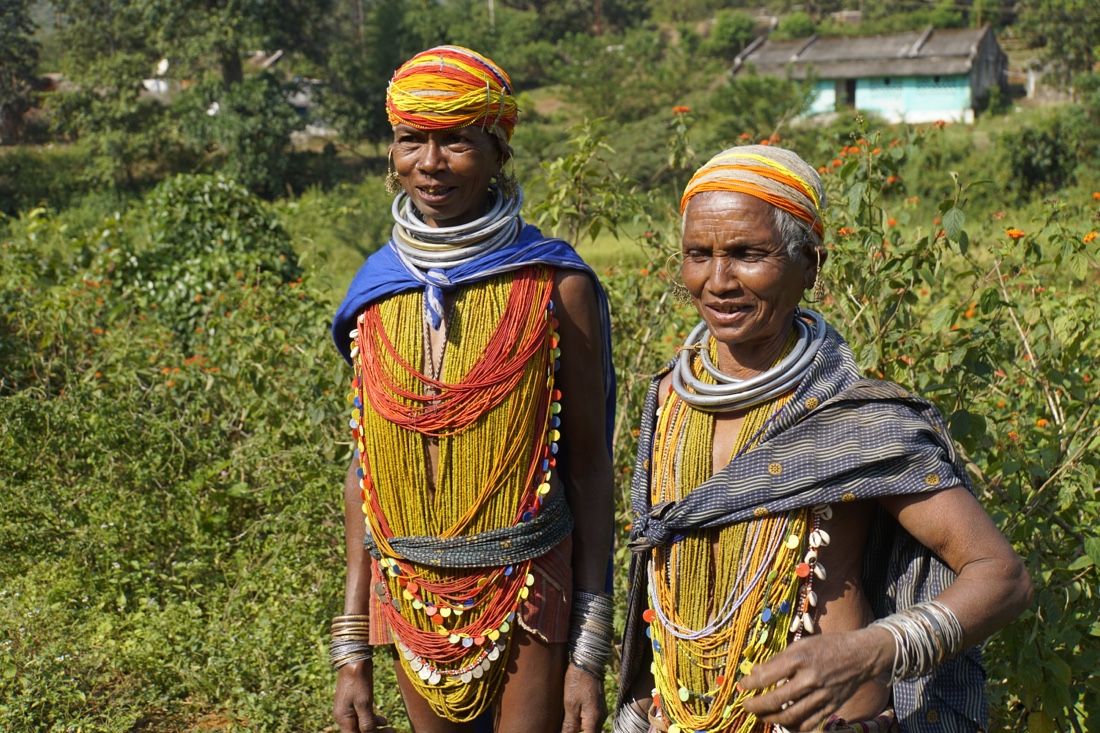 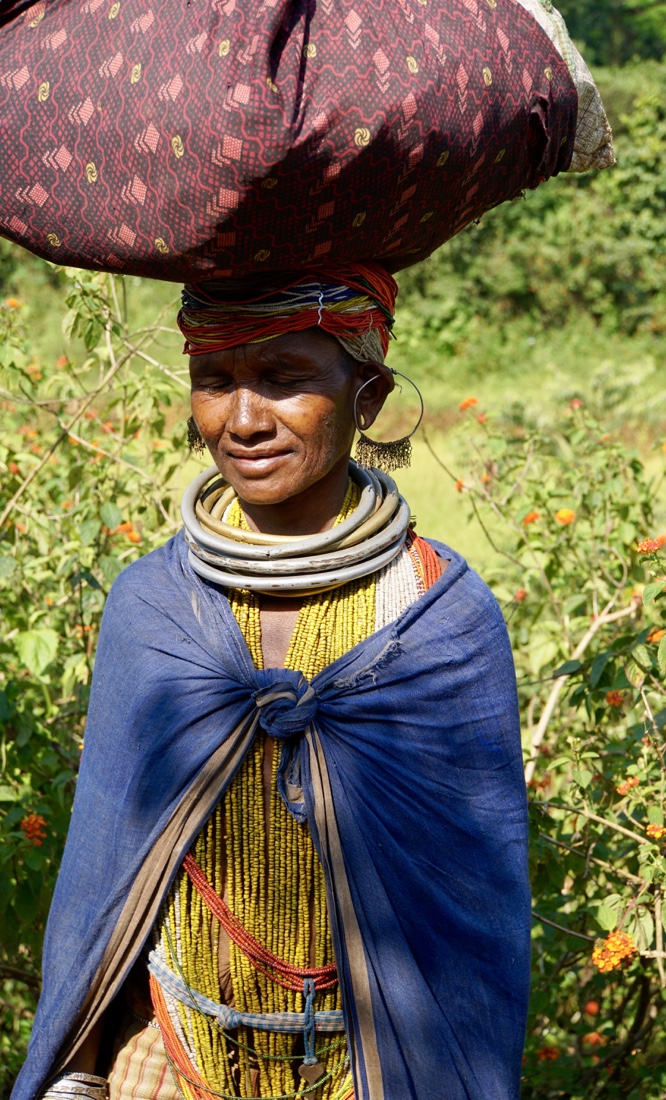 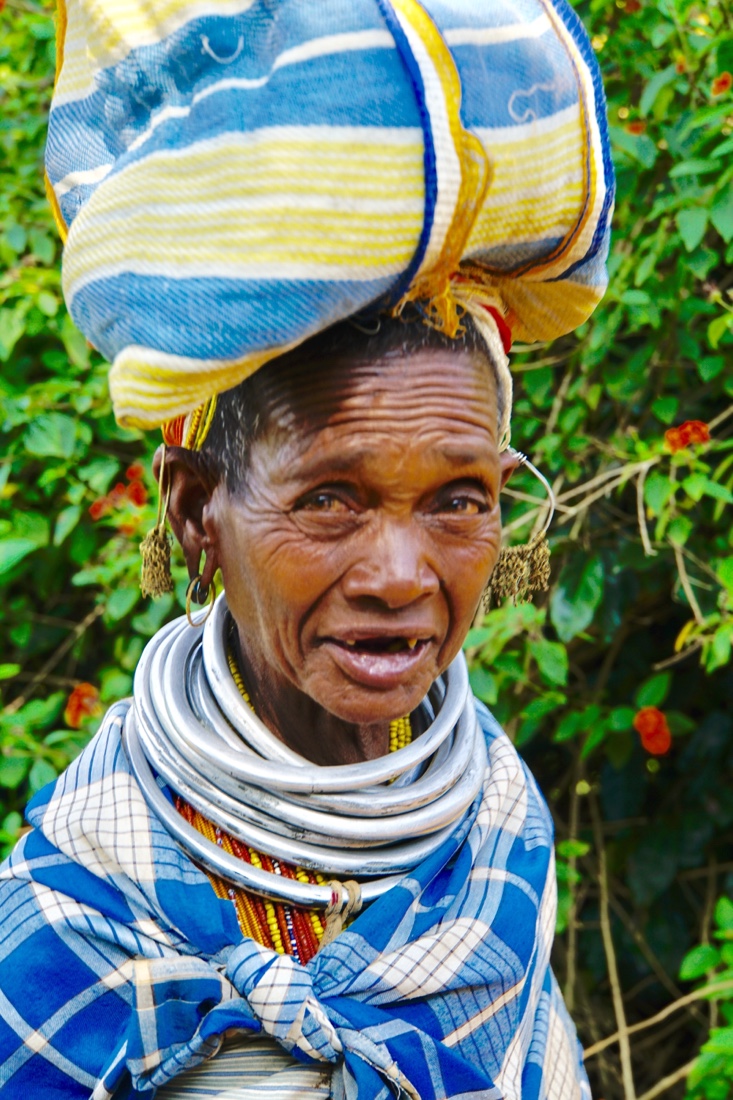 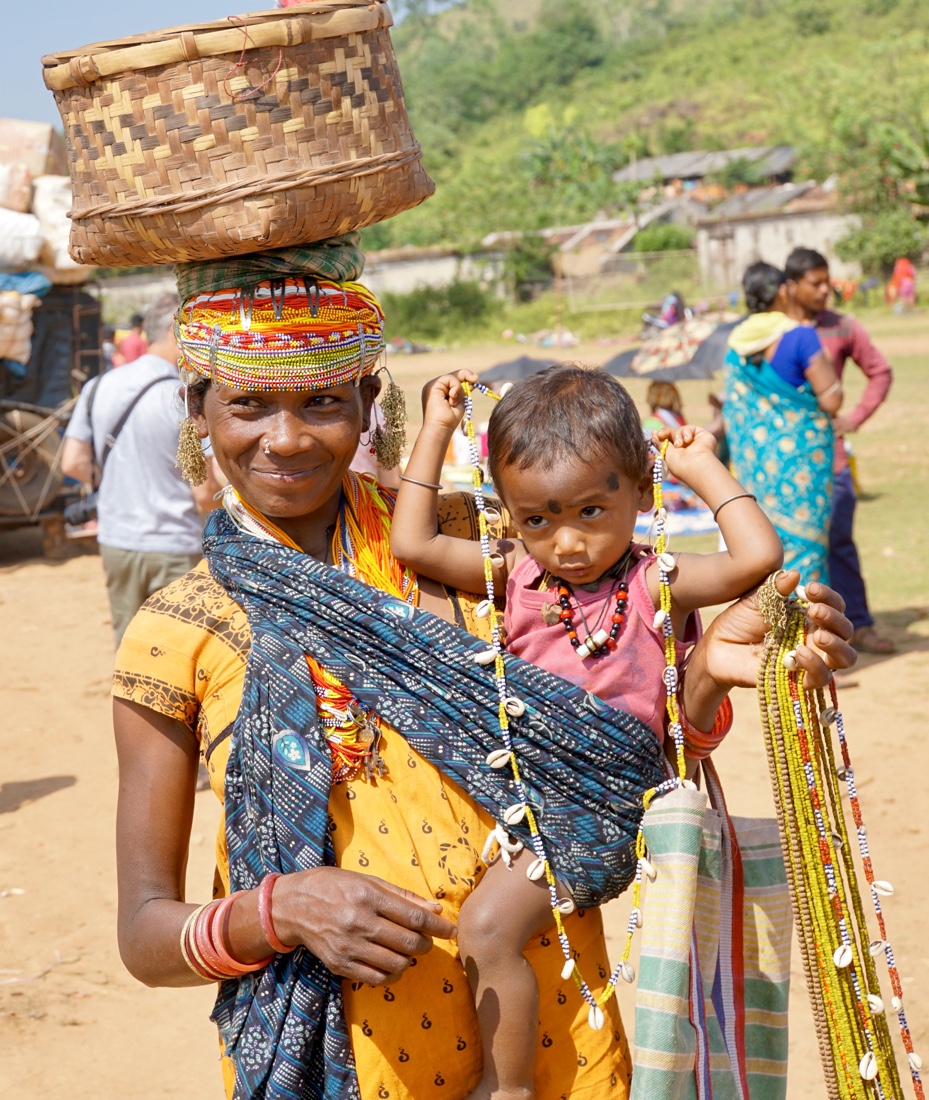 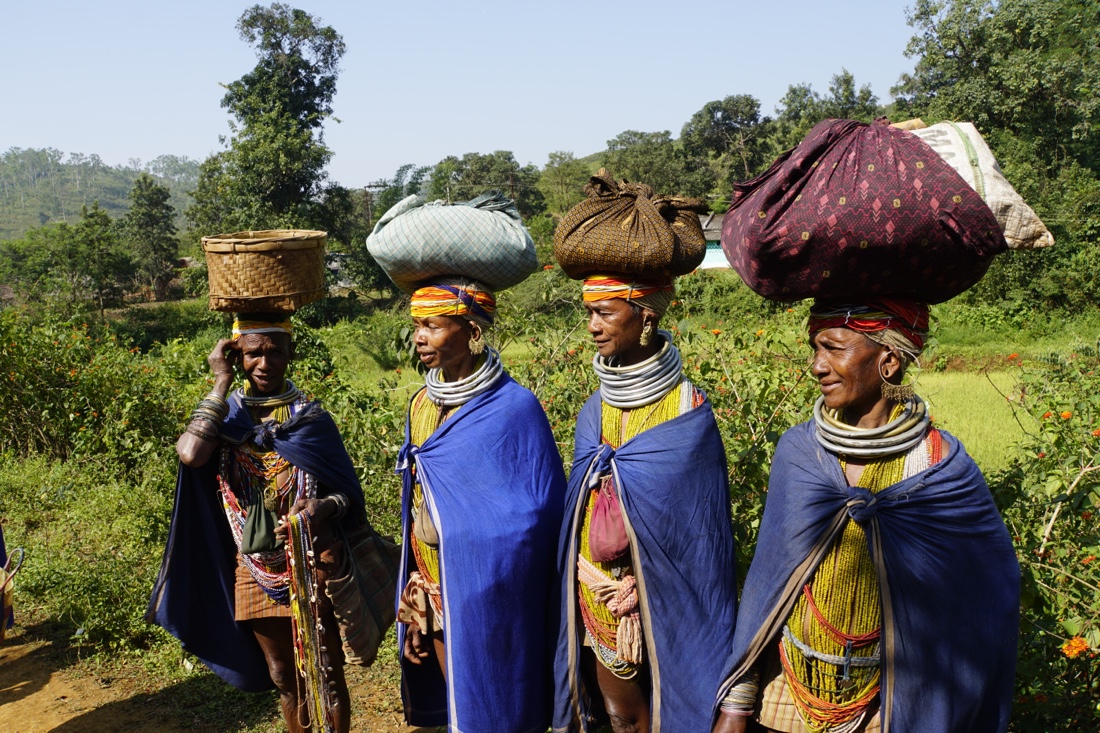 Since Bonda women hunt and forage for food in the forest, it is thought that these ornaments have a function of protecting them from injuries and attacks by wild animals. Necklaces made of beads are also worn, these are called Mali. Due to the culture surrounding their ringa cloth which covers the waist down, the khagla and Mali act as a sort of clothing for the upper body of the women. Since Bonda women hunt and forage for food in the forest, it is thought that these ornaments have a function of protecting them from injuries and attacks by wild animals. Necklaces made of beads are also worn, these are called Mali. Due to the culture surrounding their ringa cloth which covers the waist down, the khagla and Mali act as a sort of clothing for the upper body of the women.
For bachelors or newly married men, it is customary to wear their own set of ornaments. Beginning at the ages of eight or nine, males will adorn their bodies with headbands, bangles ,necklaces ,earrings. Once married, men typically do not continue to adorn their bodies. The men are a good deal less interesting and photogenic.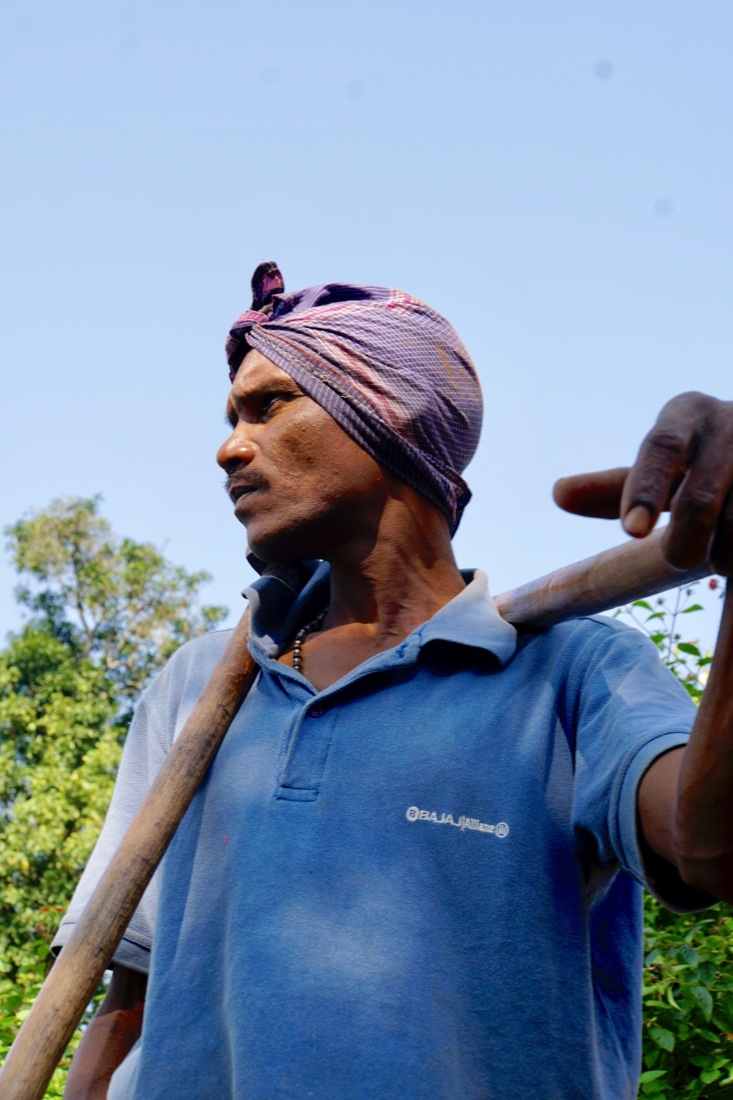 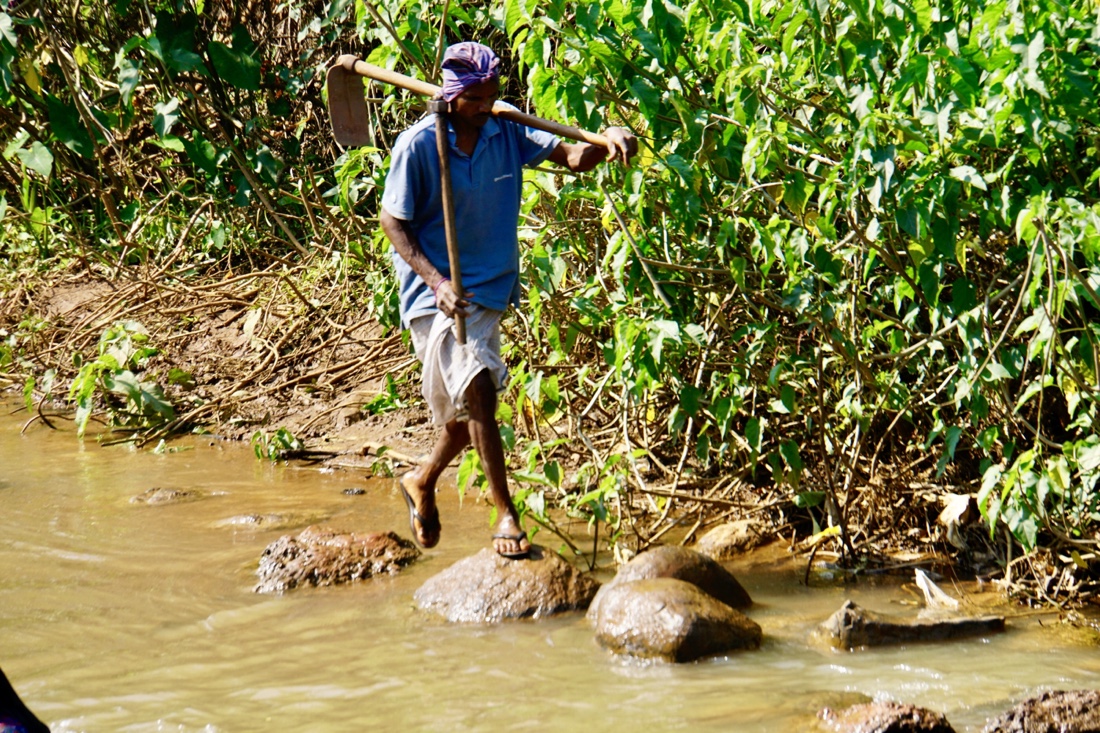
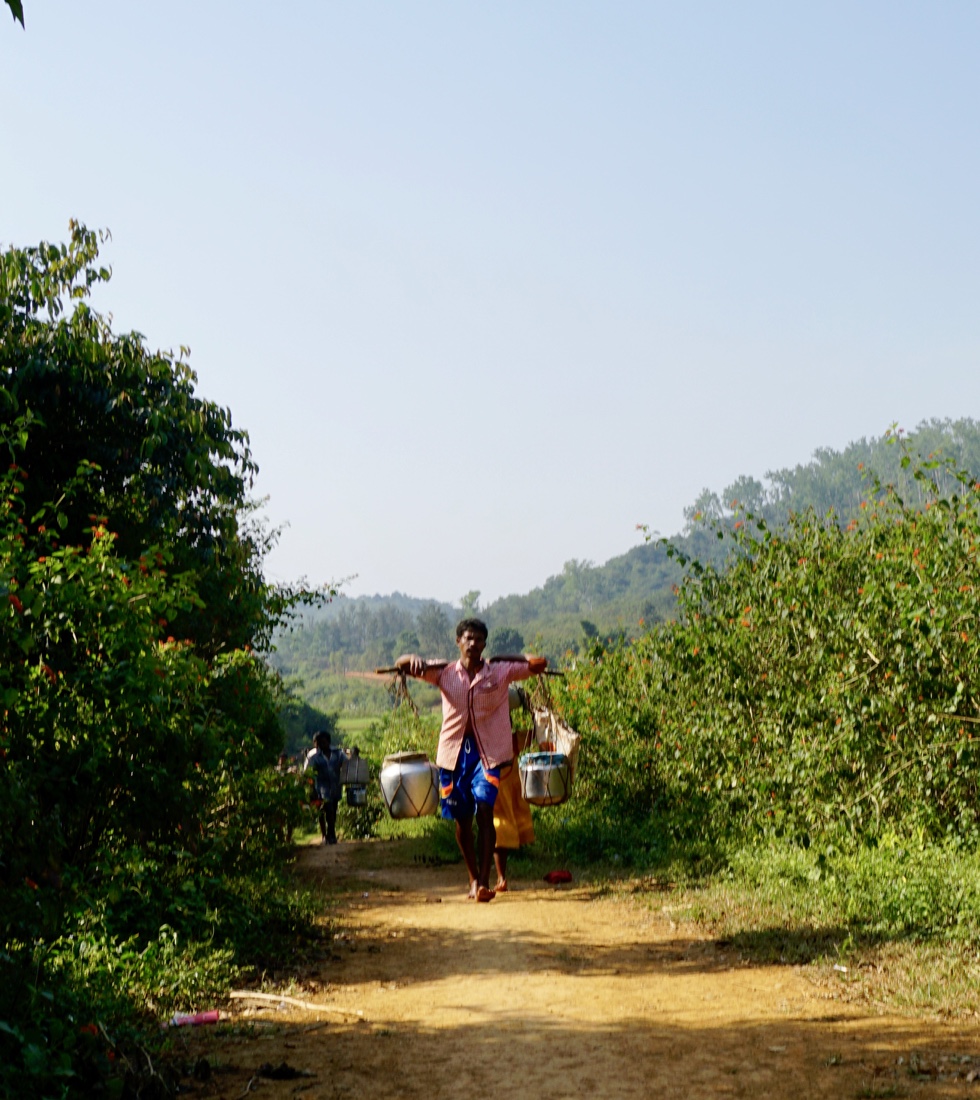 It is fascinating to see the Bonda women, who are very friendly and quite willing to pose, especially whe Prasant slips them a few rupees. Best is to see them walking down to the market from the hills. It is fascinating to see the Bonda women, who are very friendly and quite willing to pose, especially whe Prasant slips them a few rupees. Best is to see them walking down to the market from the hills. 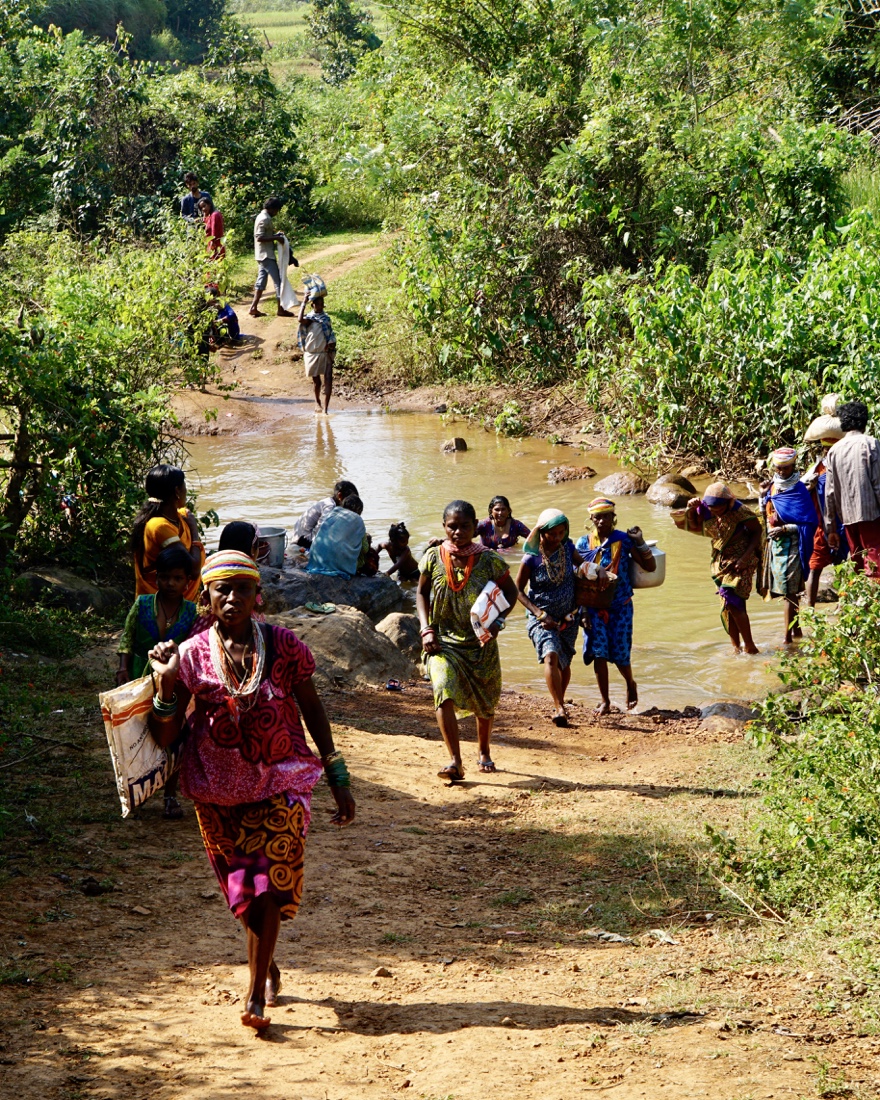 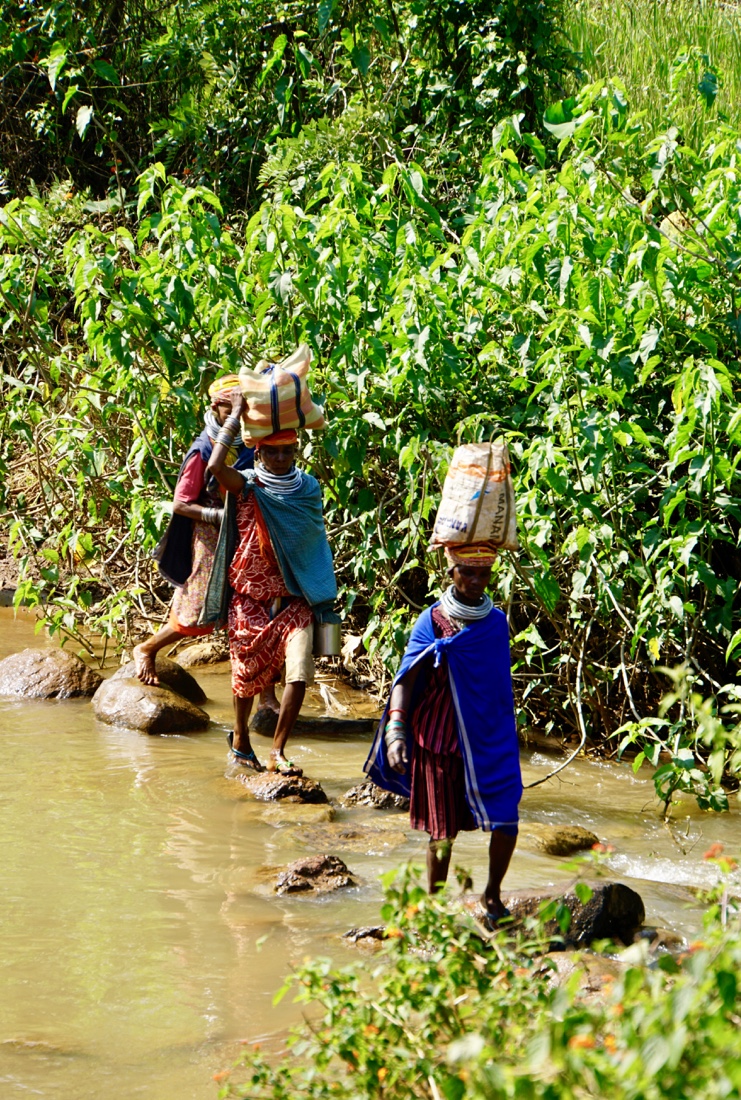 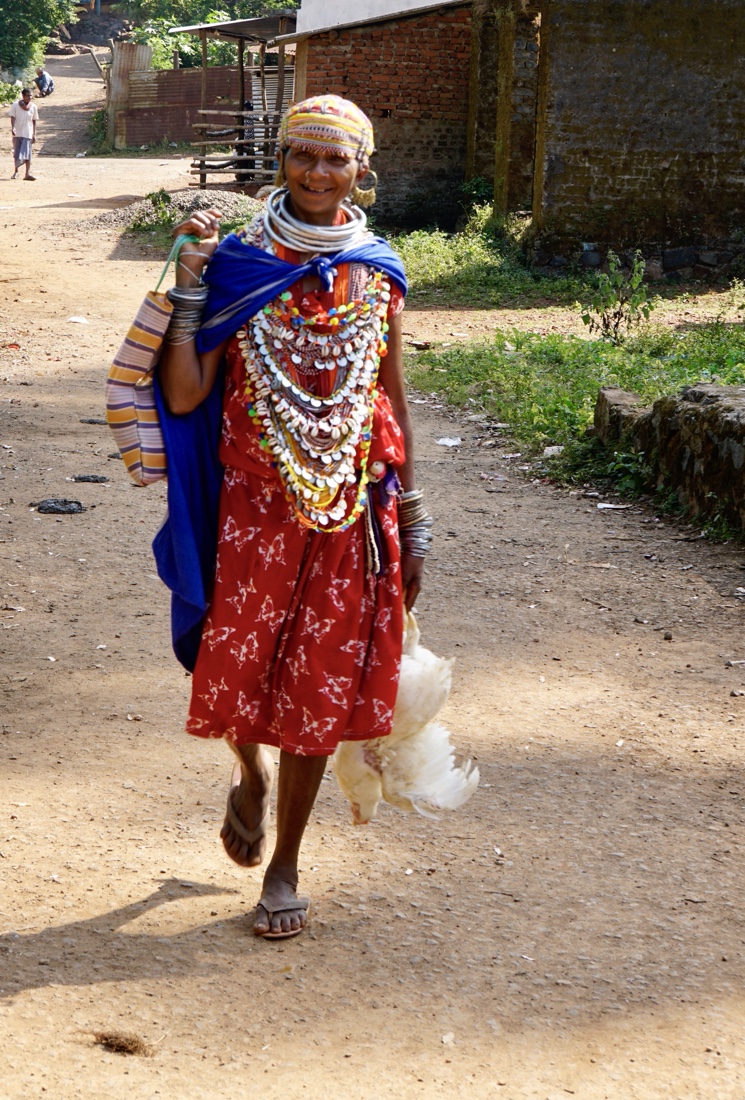 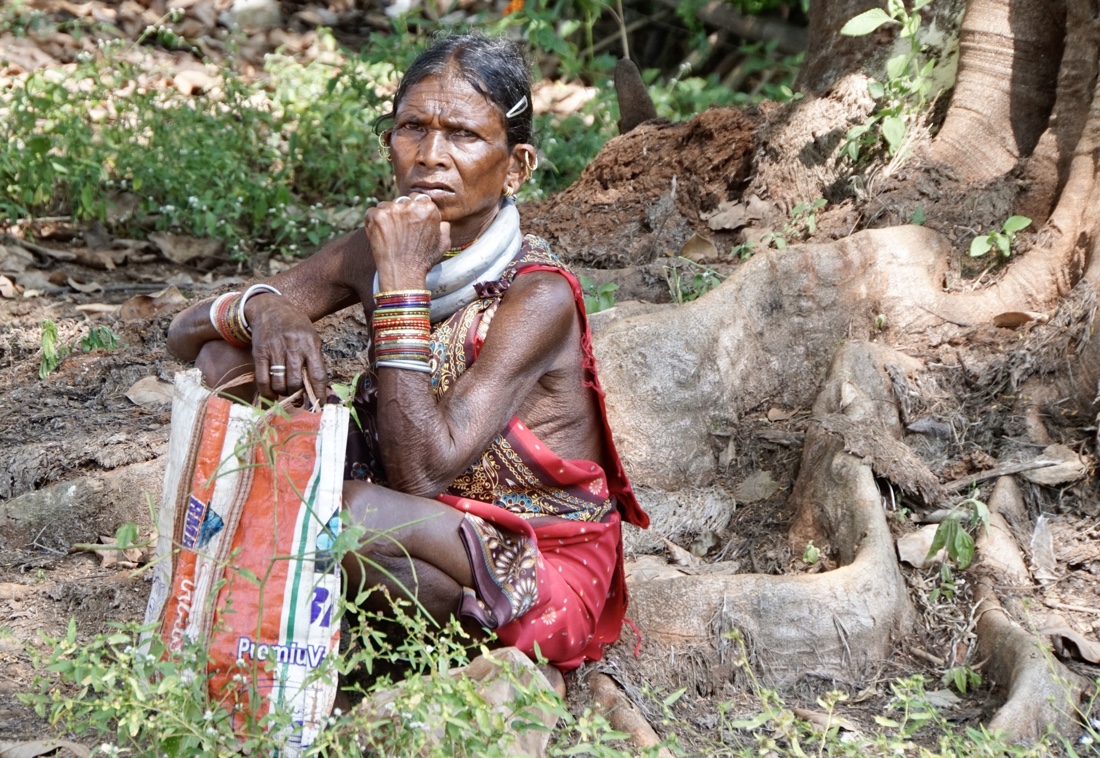 The market itself is, well, a market, and not markedly different from many other markets I’ve seen. The market itself is, well, a market, and not markedly different from many other markets I’ve seen.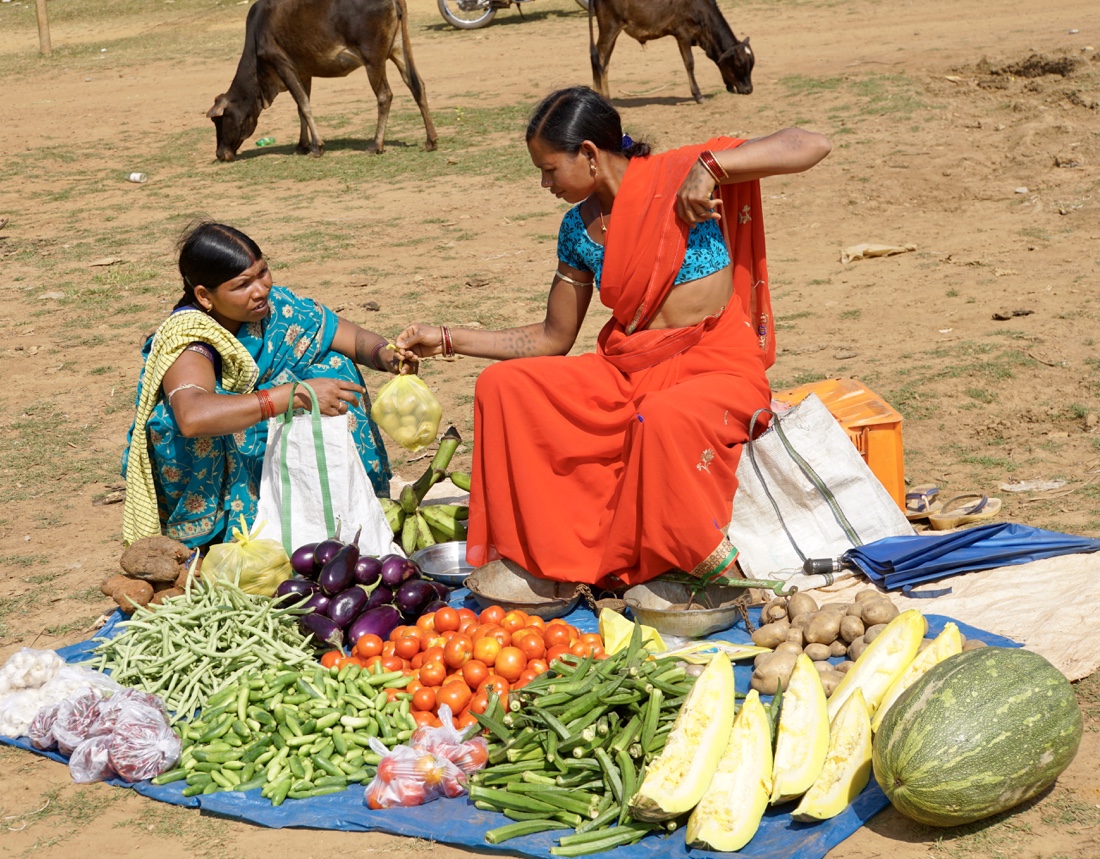 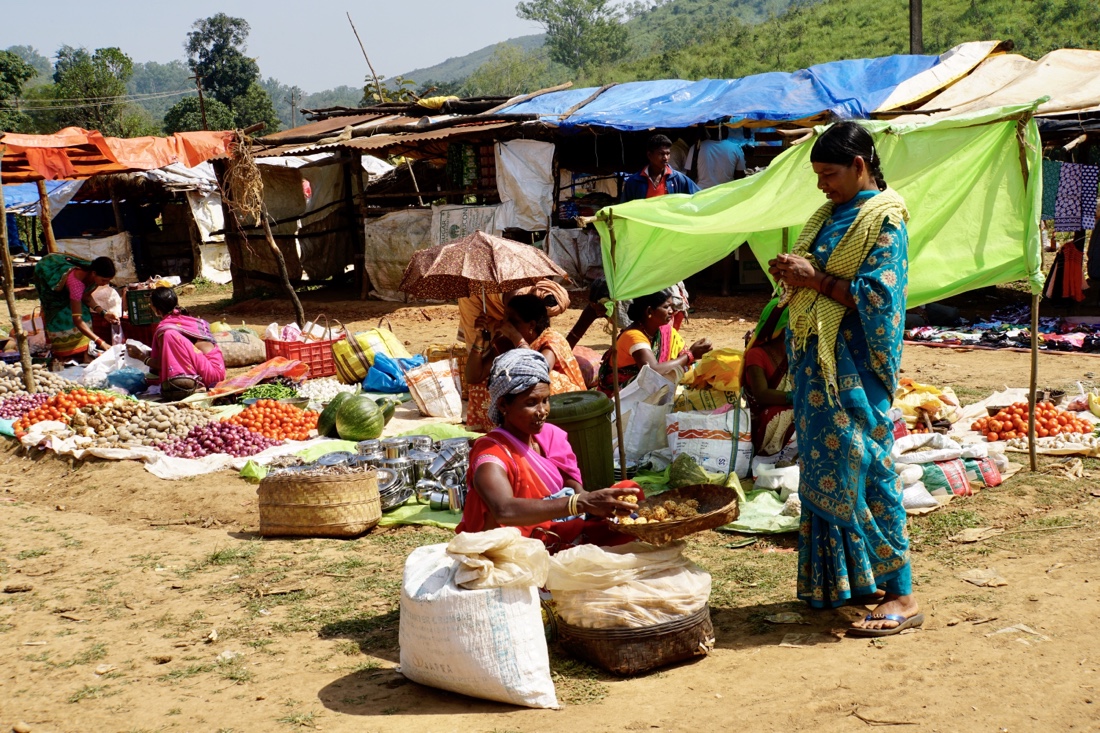
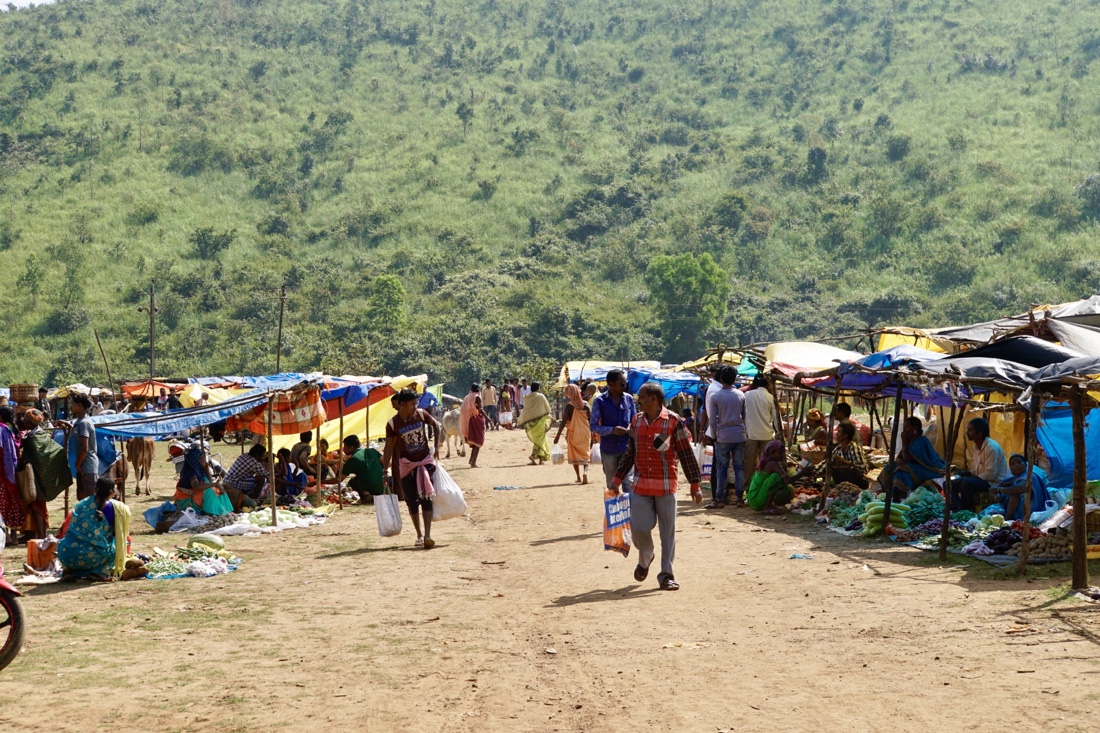 From the market we go a village of the boro gaddaba tribe in bahiripada. At the entrance to the village is a shrine to the goddess, represented by rocks in keeping with their animist beliefs. From the market we go a village of the boro gaddaba tribe in bahiripada. At the entrance to the village is a shrine to the goddess, represented by rocks in keeping with their animist beliefs.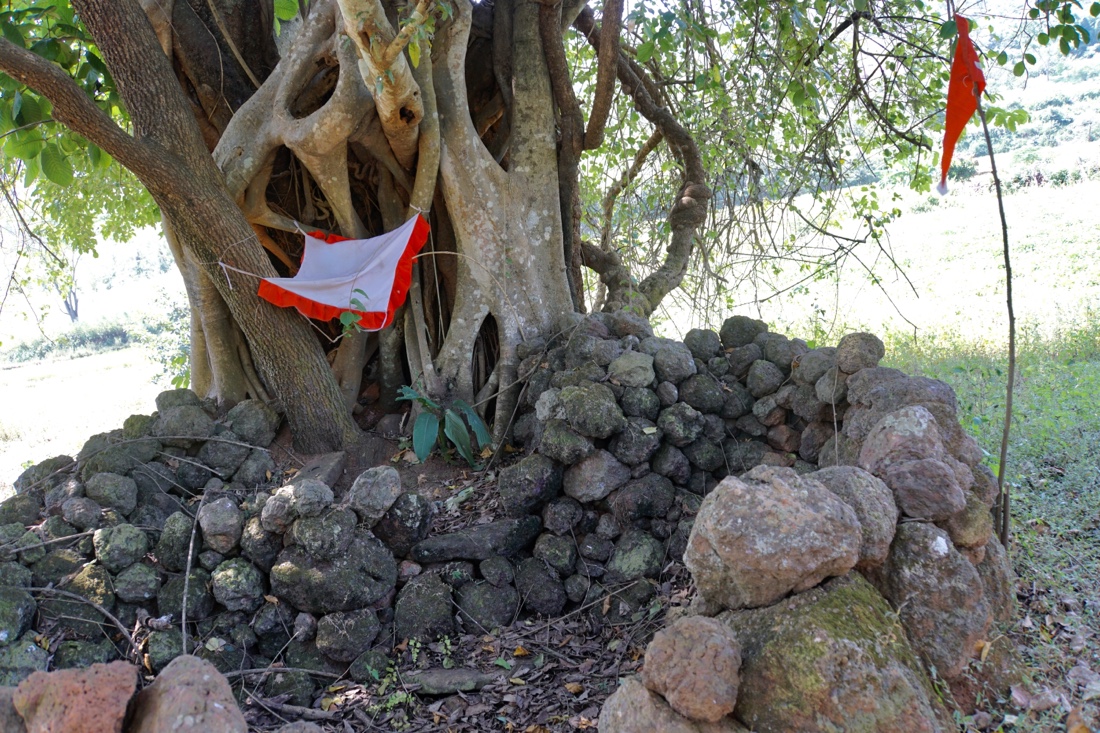 Even in the smallest villages, color abounds. Even in the smallest villages, color abounds.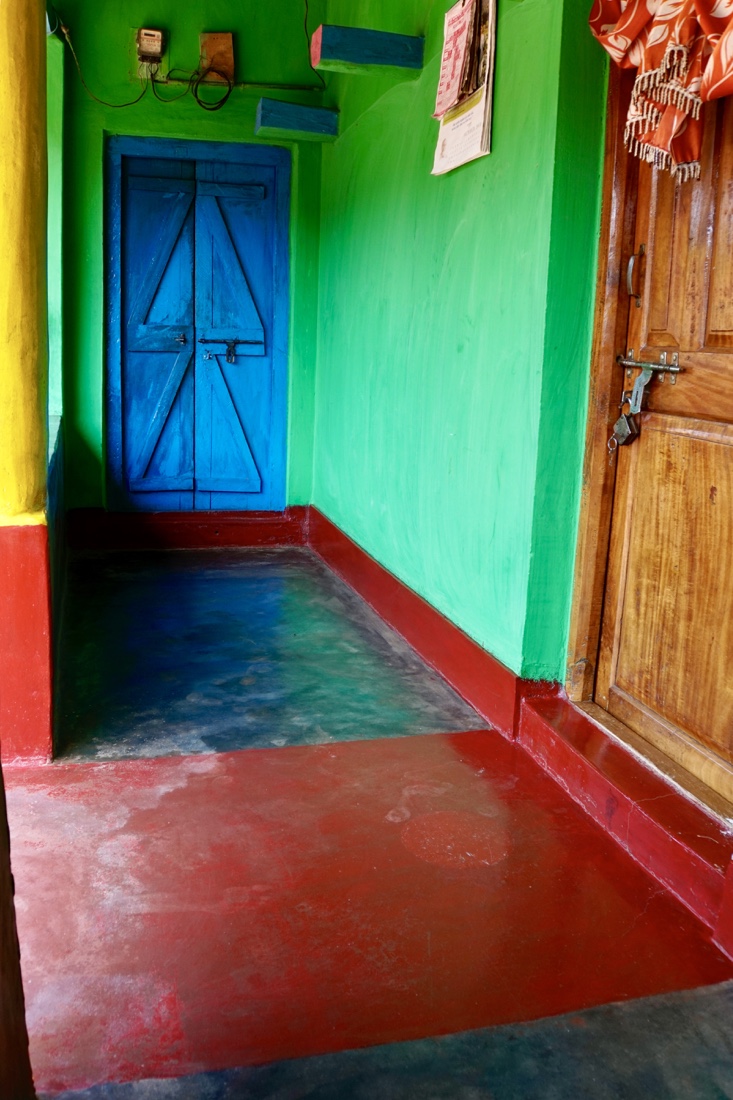 Though I’ve now been to many of these villages, I still love to walk through them, observe the lifestyle and photograph people. Though I’ve now been to many of these villages, I still love to walk through them, observe the lifestyle and photograph people.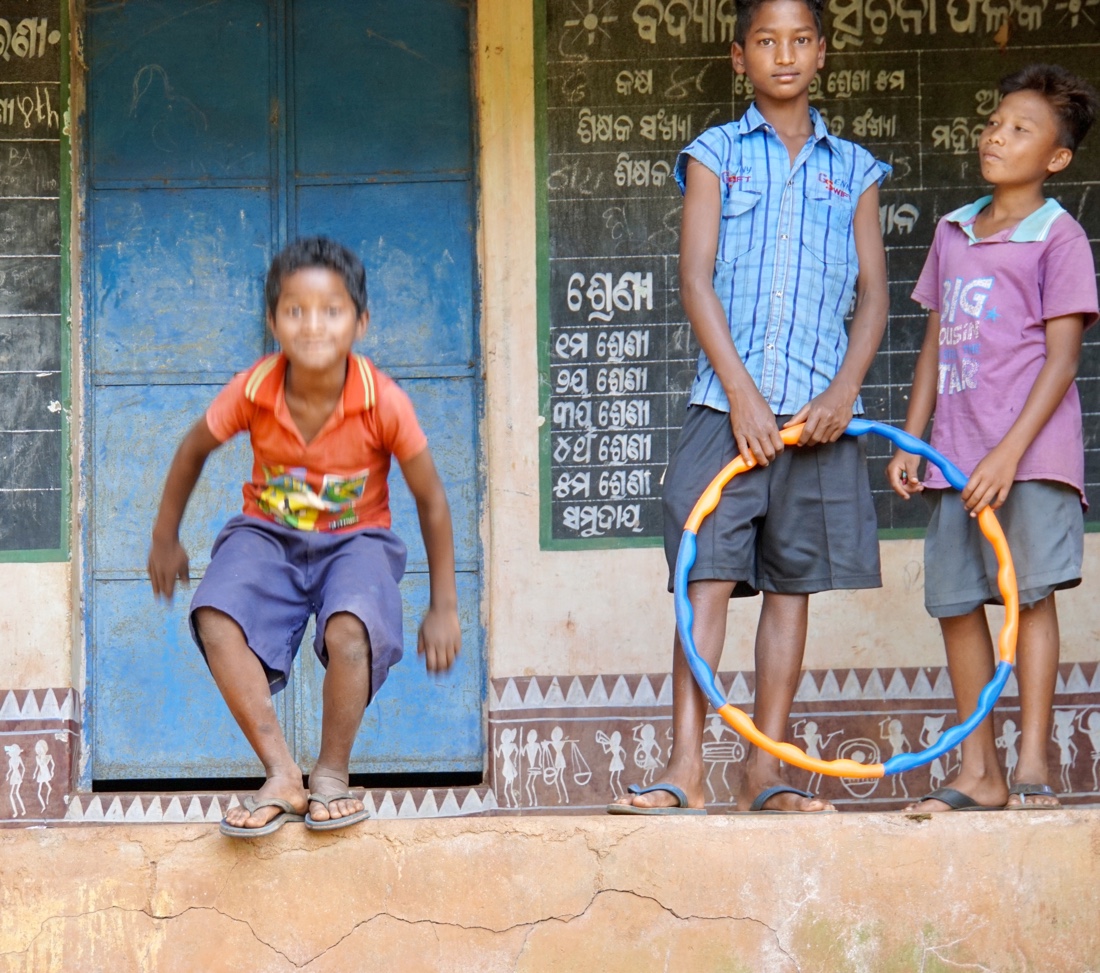 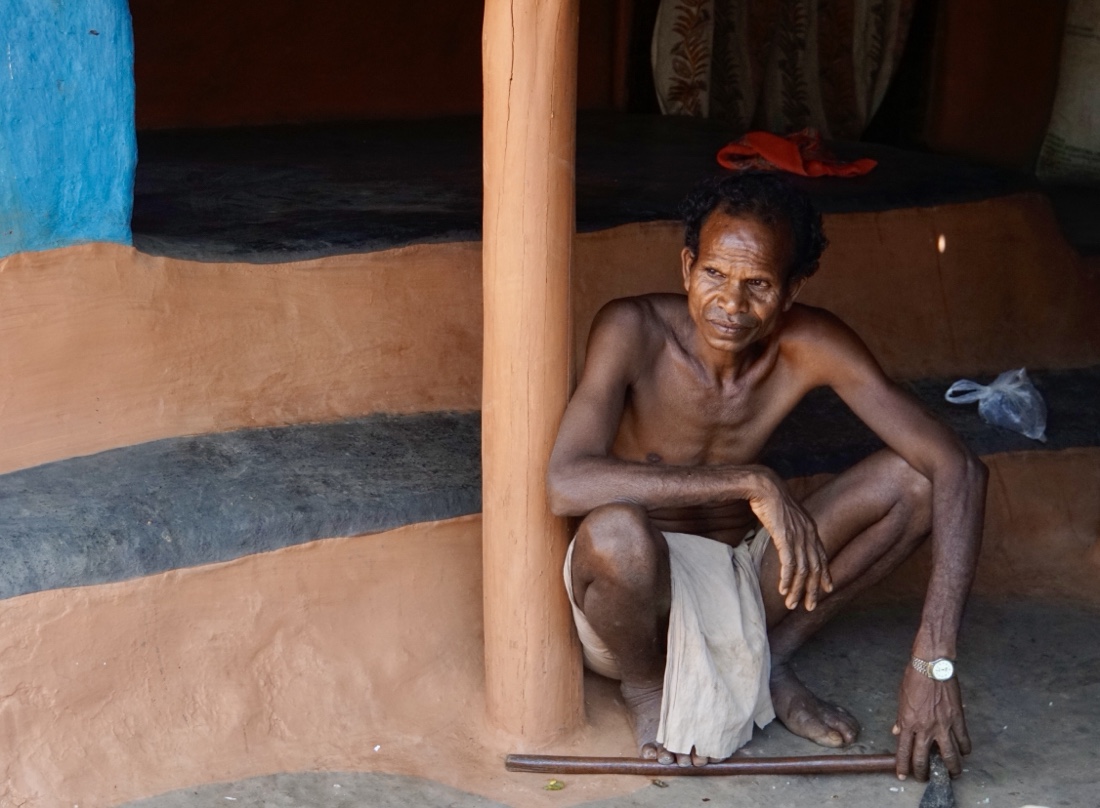 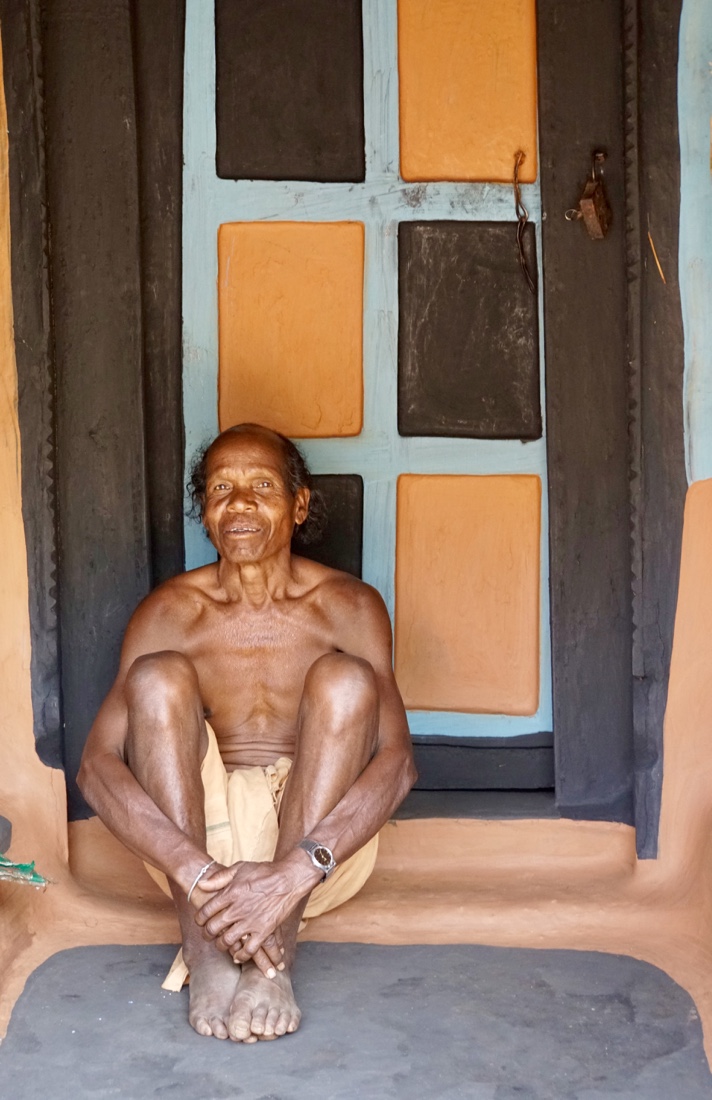 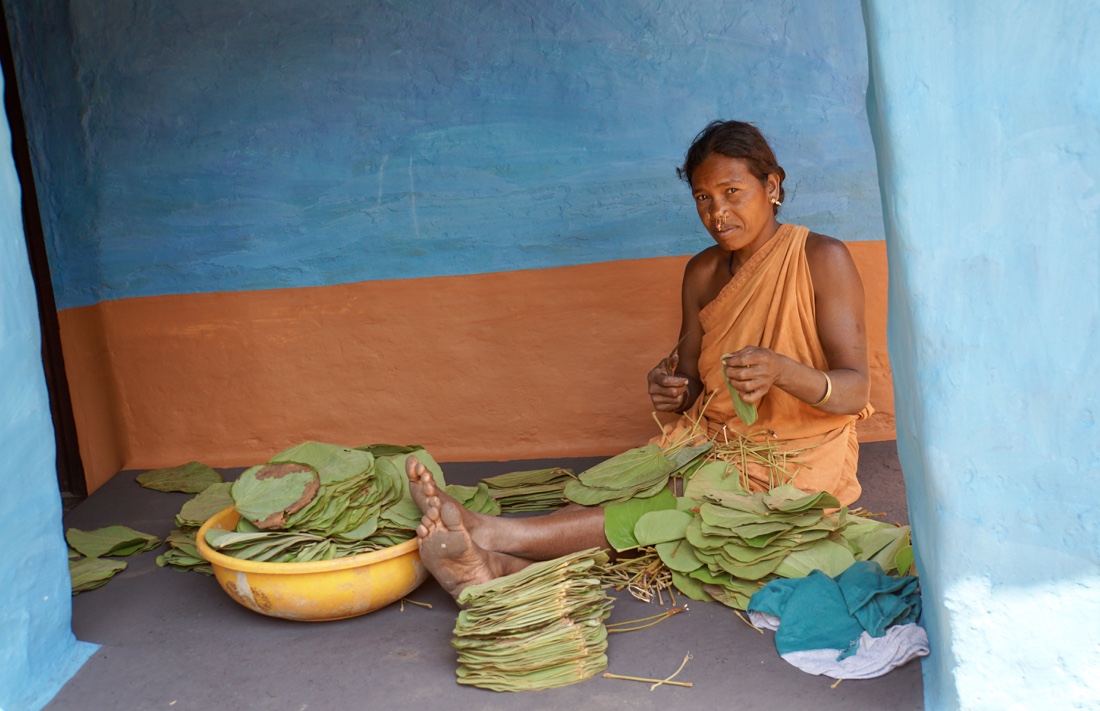 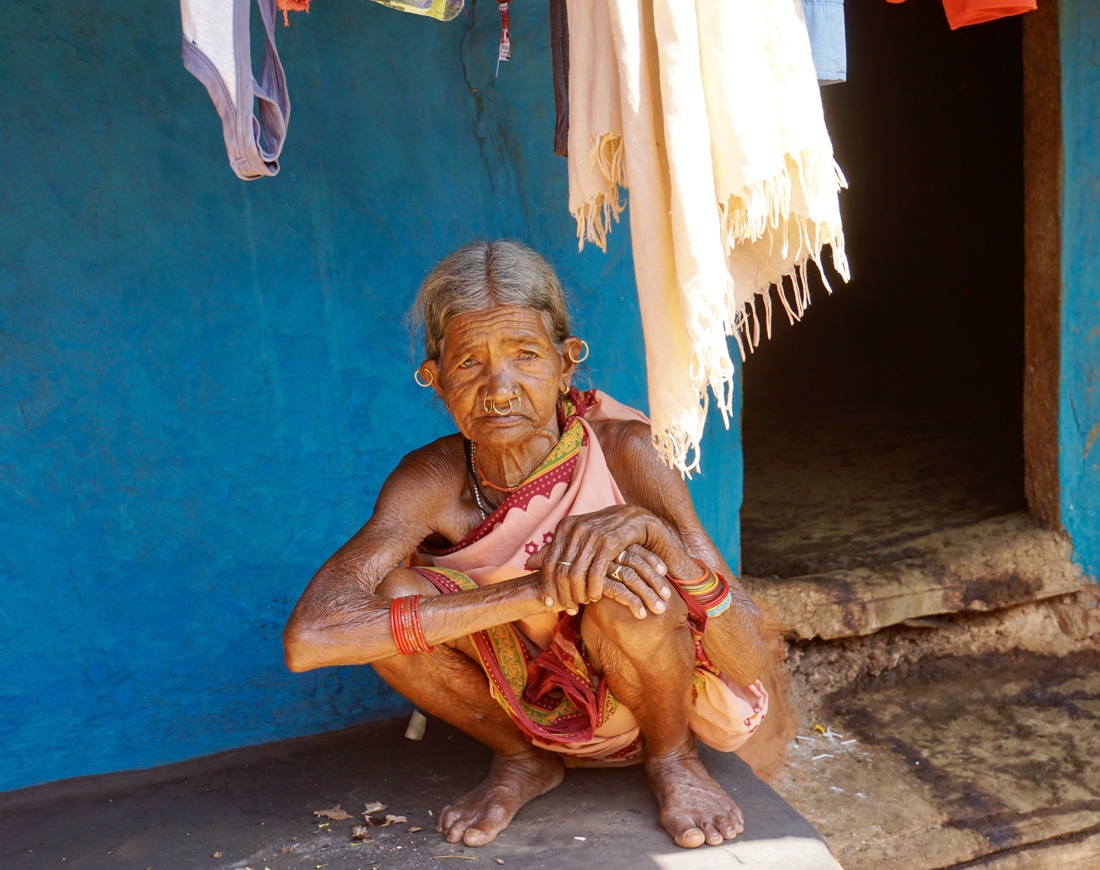 
We have lunch at the same restaurant we did a few days ago, and again it is very good. Prasant asks if I want to go to another village, but I am exhausted, because I was up most of the night exchanging emails with my US travel agent to deal with the way Air India had totally fucked things up (to use the technical airline term). Ultimately, she got things sorted out, but not before some anxious moments, including a fear that Air India might cancel my Delhi-Chicago flight. It’s going to be an extremely frigid day in hell before I fly Air India again.
I get a few hours of badly-needed sleep before dinner, where I sit with the Spanish couple and a group of seven Swiss, led by a woman who is Swiss, but was born in India.
October 24
Set out at the ungodly hour of 5:30, having already breakfasted. We have about a 3-hour drive to (what had better be) the terrific Kond market, called Chatikona, which operates only on Wednesday. There are approximately 1.8 million Konds in India.
Before giving you a rather lengthy discourse on the Konds, I’ll tell you briefly about my day, then tack on the Kond description at the end. I think it’s quite interesting, but it may not be everyone’s cup of tea. So, you decide.
Arriving at the Kond market, we see Konds walking down from the mountain.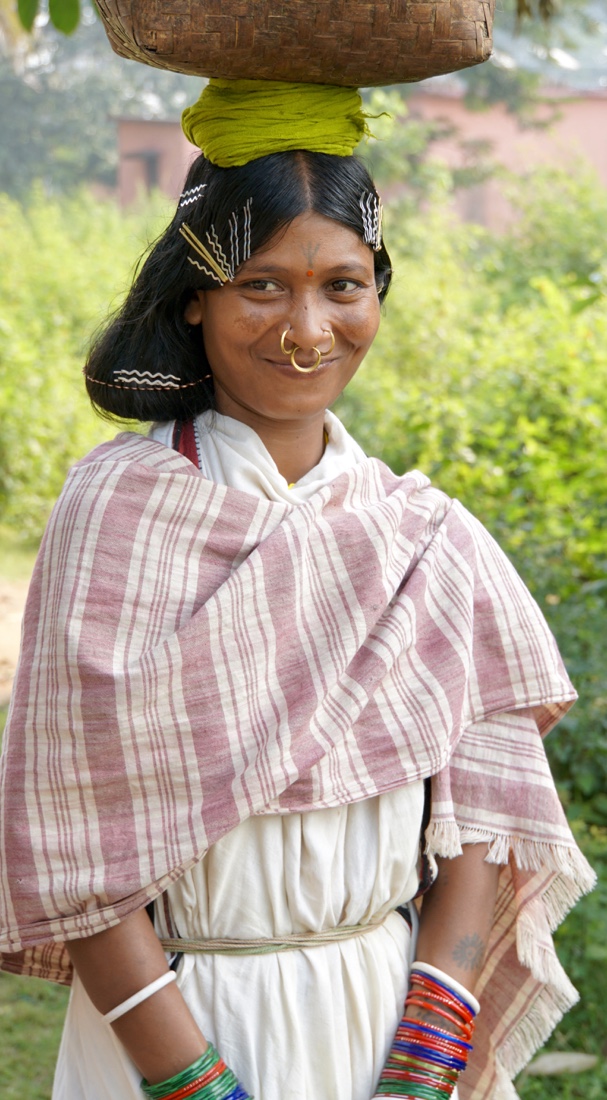 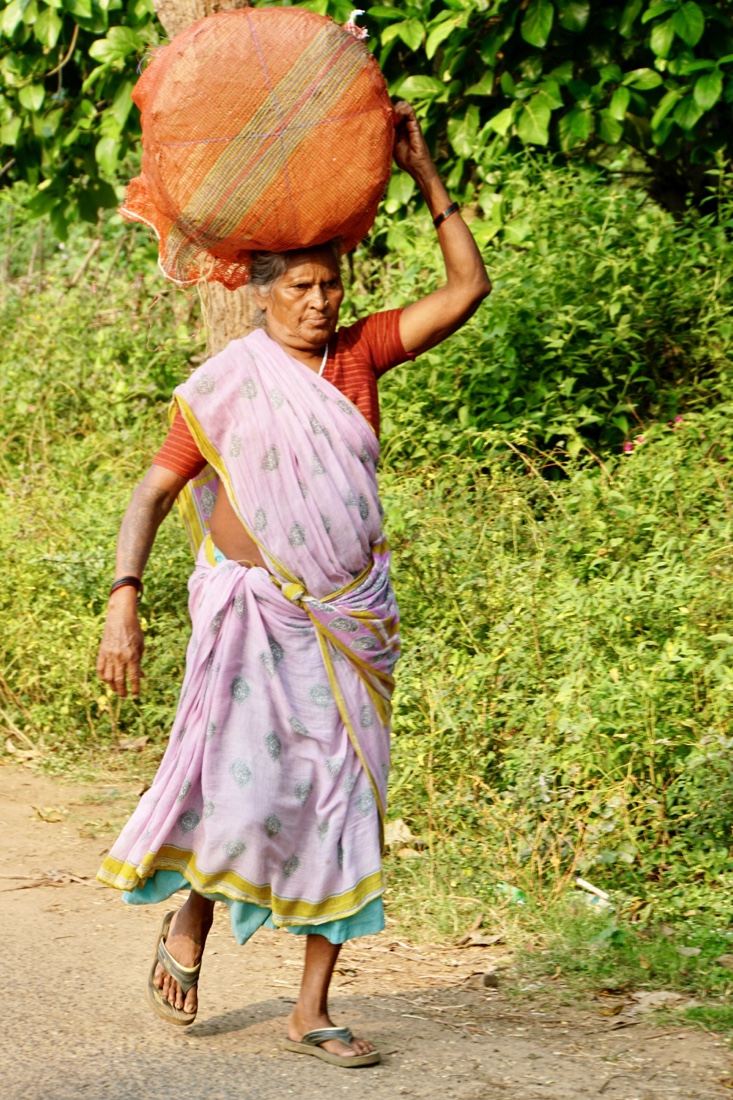 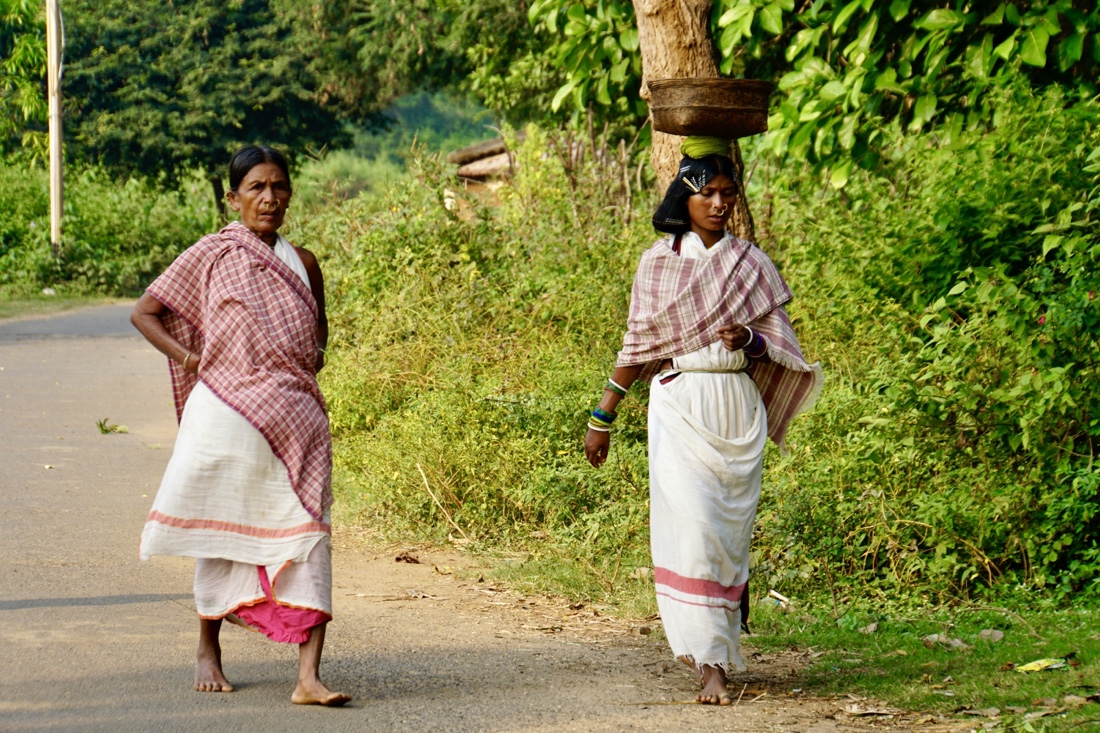
Because the government has built a road partway up the mountain, some of the Konds come down the last part of their trek in vehicles, typically stuffed to the gills with people.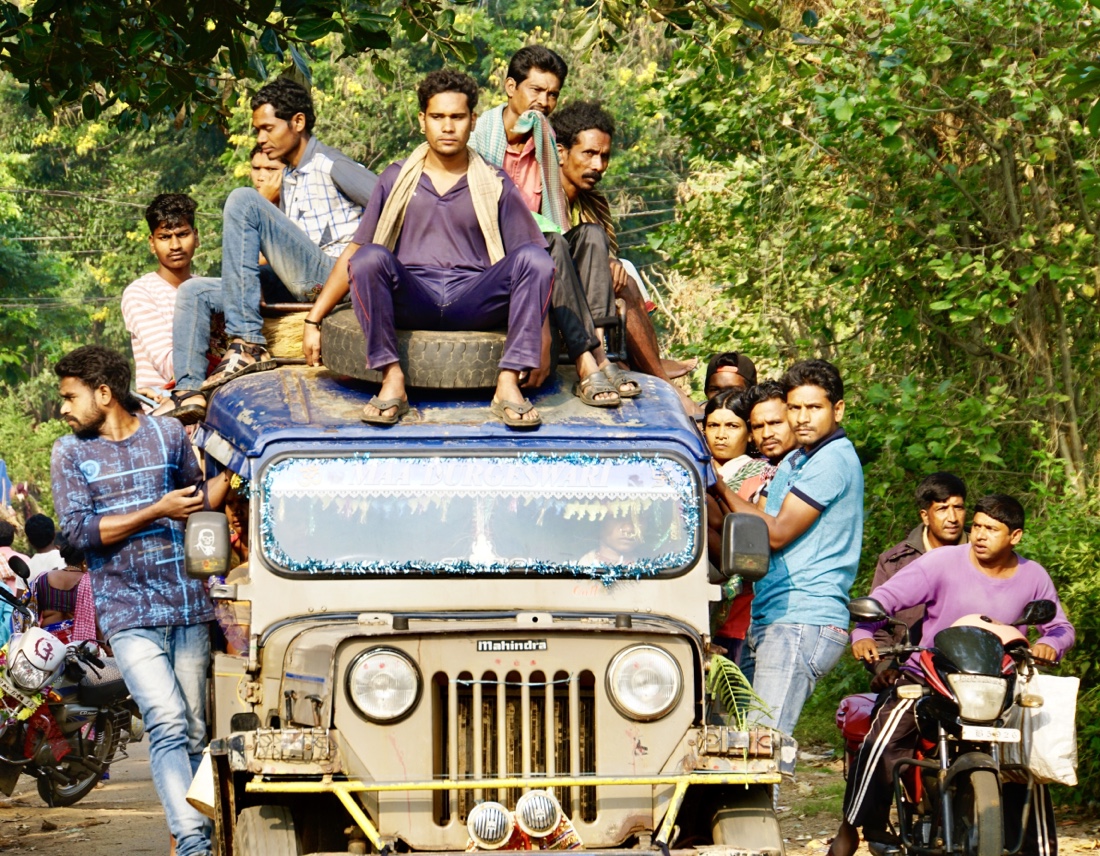
The market was indeed interesting, largely because of the opportunity to observe the dress and jewelry, which distinguish the Konds from other tribes and from different types of Konds. The market itself stretches across a railroad track,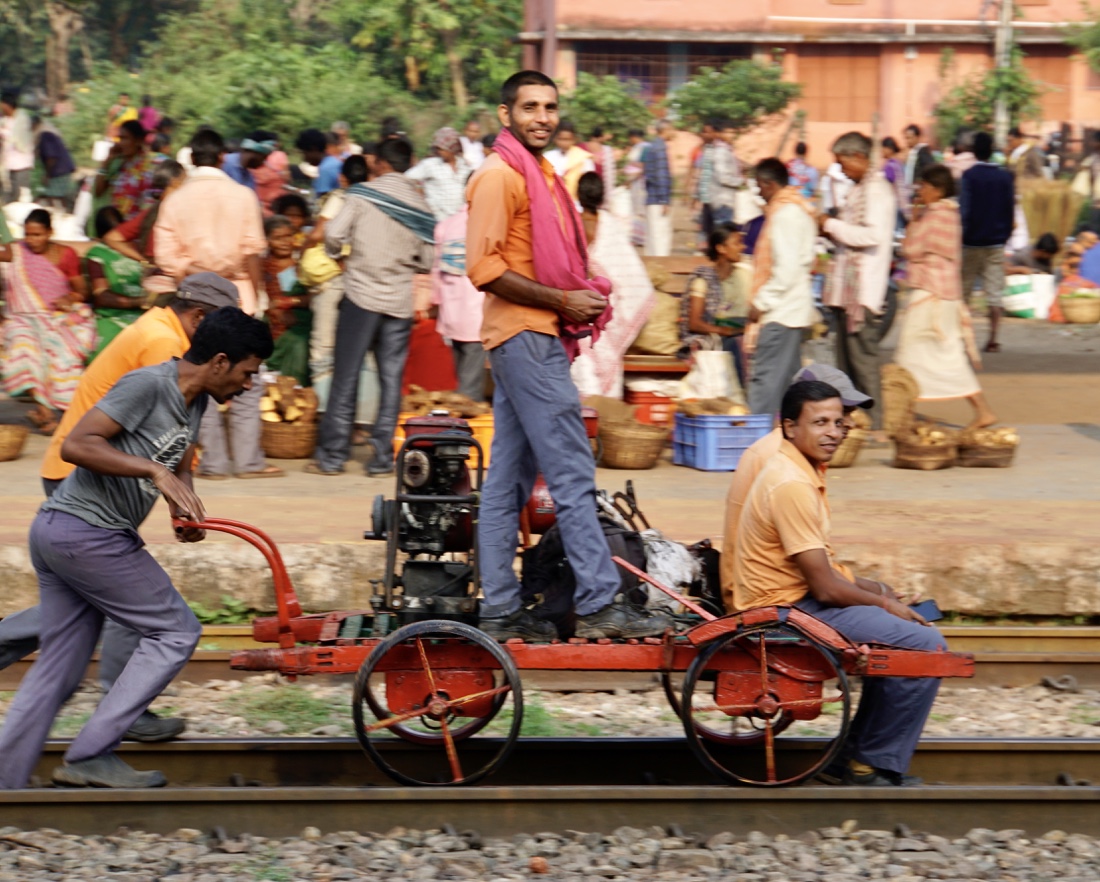
down a hill, along a highway and then into a large rectangular area. The weekly tribal market provides the opportunity for tribes to sell their products through a barter system which still prevails, get their weekly provisions, provides an opportunity for community elders to interact with others in their village, for girls to display their best of costumes and jewelry, and for the young men to display their courage to attract women.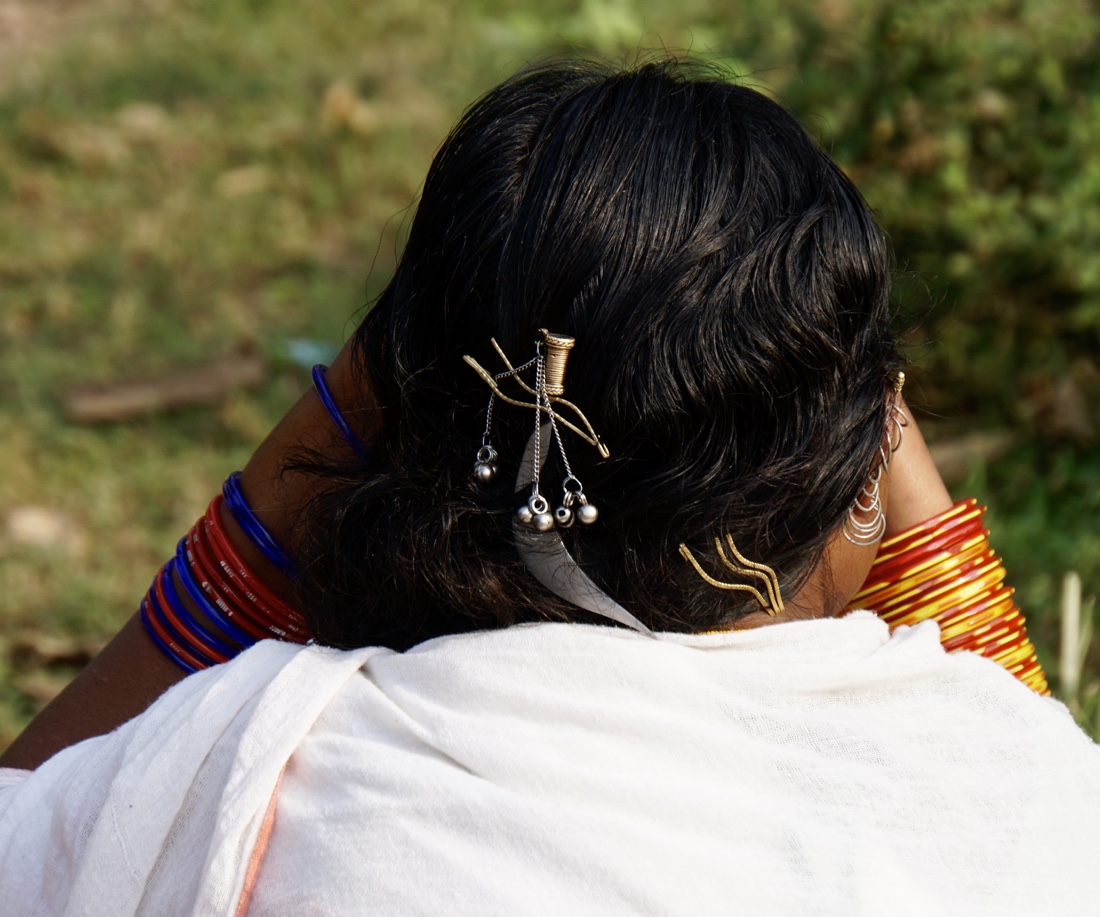 
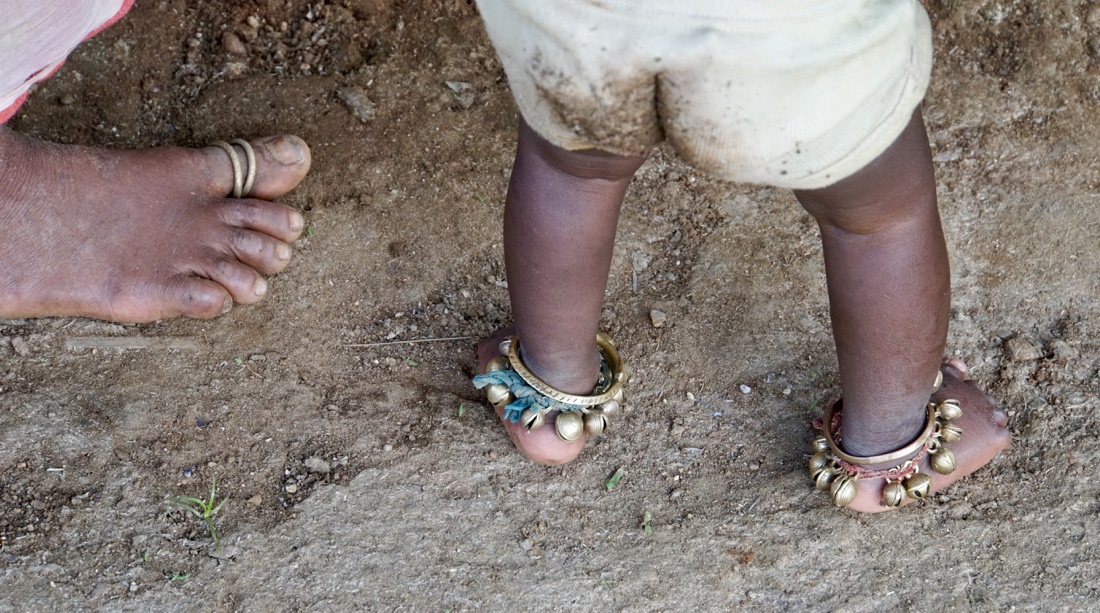 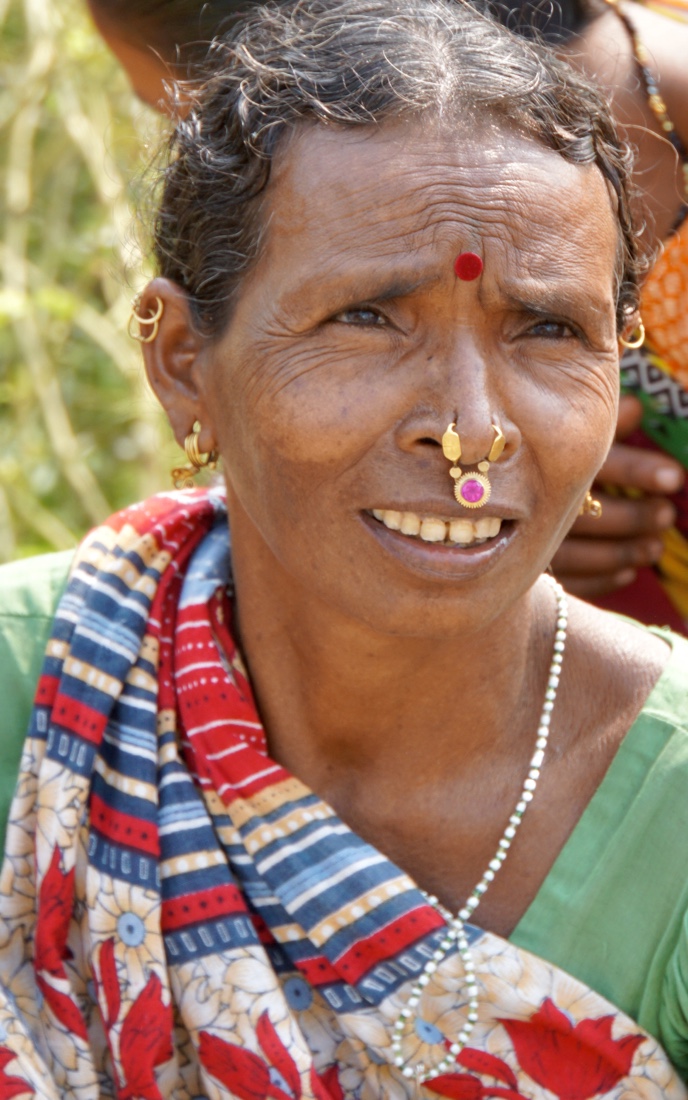 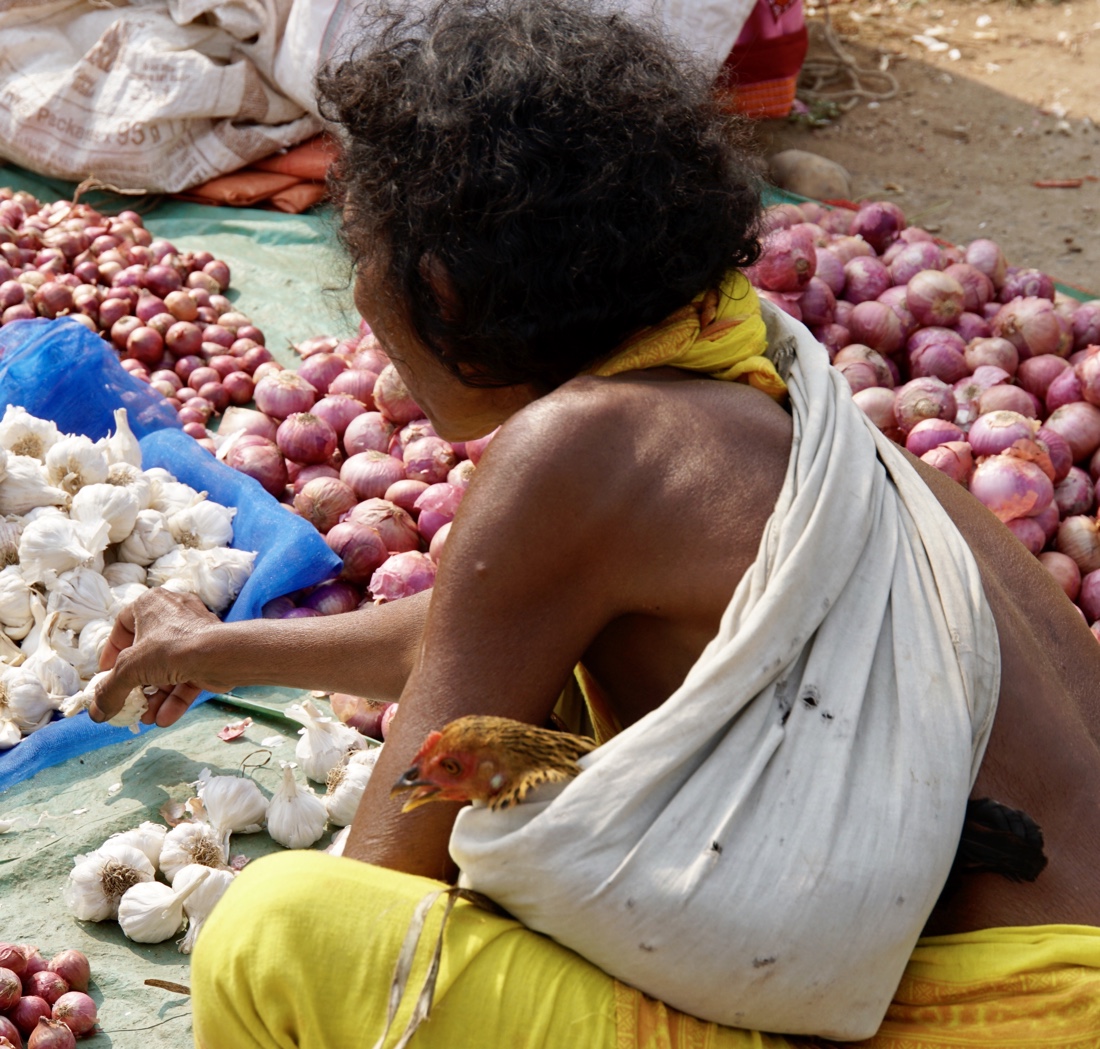 Before we got to the market, Prasant told me that the members of the tribe were aggressive and that I should not show people photographs that I take and be careful. He said sometimes they threw things at people trying to take pictures. I did not experience any aggressive behavior, but the Konds were noticeably less friendly than other people we’ve encountered and almost never smiled. Happily, though, they did not try to sacrifice me. Before we got to the market, Prasant told me that the members of the tribe were aggressive and that I should not show people photographs that I take and be careful. He said sometimes they threw things at people trying to take pictures. I did not experience any aggressive behavior, but the Konds were noticeably less friendly than other people we’ve encountered and almost never smiled. Happily, though, they did not try to sacrifice me.
This was the only market we’ve been in in which people tried actively to sell things to the very few tourists who were around. I did buy a few trinkets, but I think Carol would be proud of how I bargained (though I’m sure she would’ve gotten each item for less than I did).
After walking through the market, we relax and have a coffee there, then proceed to the first of three villages we visit, Gaudaguda, in which the Desia khandh live.
After the first village, we stop at a hotel to have an excellent Indian lunch, before continuing on to the other two villages. I am coughing badly, suffering from the smoke I inhaled at the pottery village yesterday.
We go to two more villages, Punjapai, where the Kuvi kandha live and Minapai, which is also a Kuvi kandha village in which most all of the villagers are engaged in making bamboo baskets.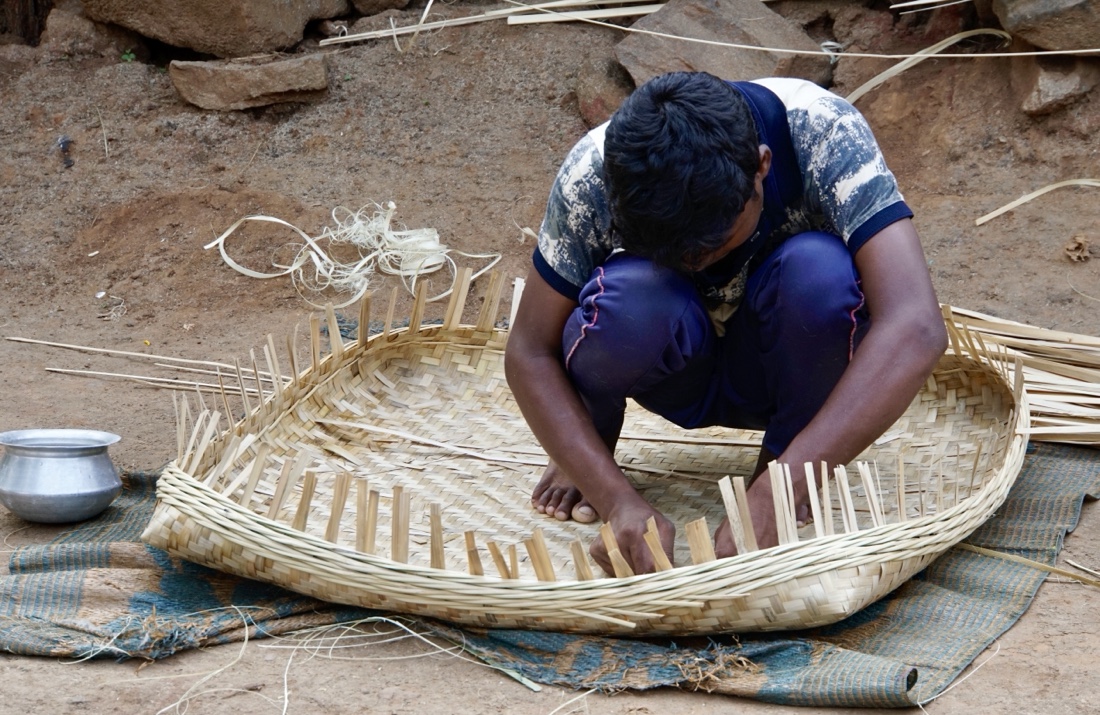 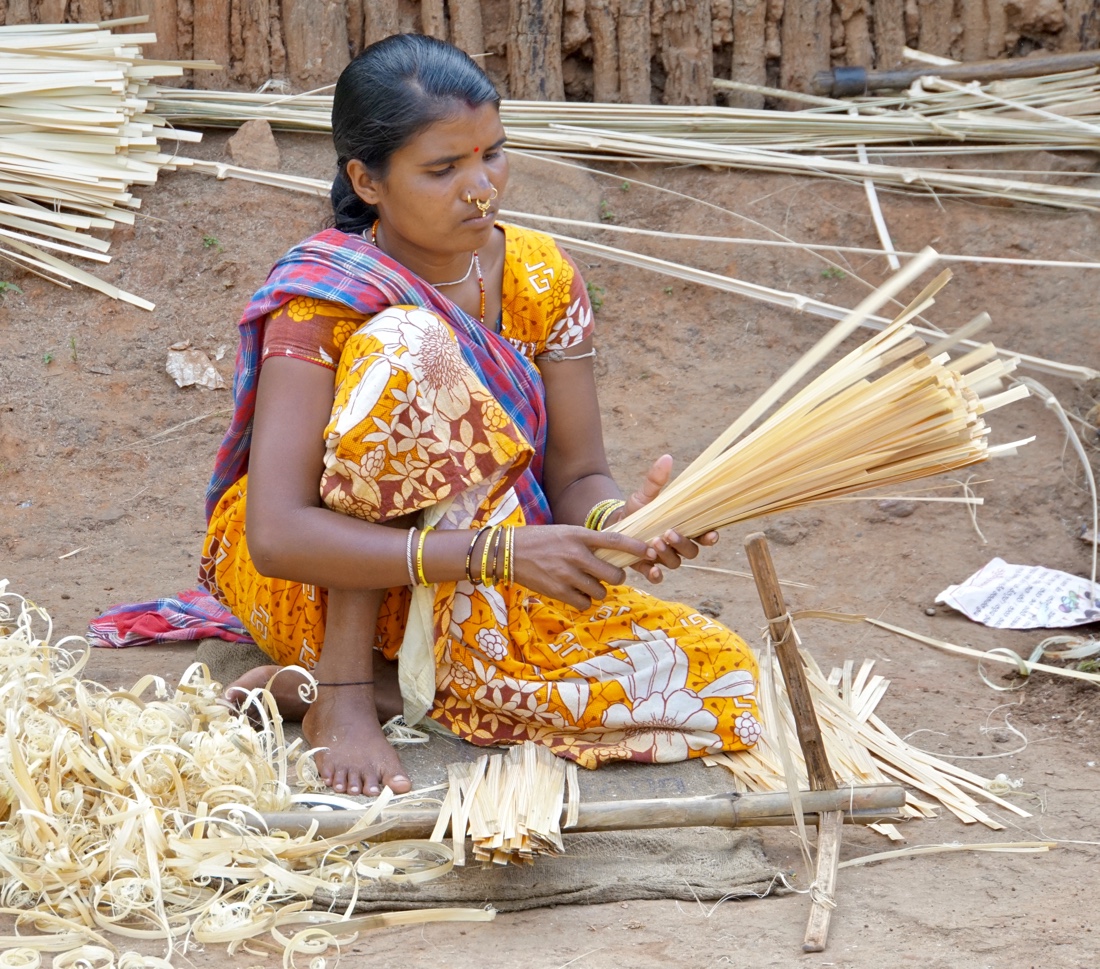 Prasant is something of a pied piper, as he buys packages of cookies and hands out cookies to the children. After visiting the third village, Prasant asked whether I’d like to go to another one. I demur, though, saying that I am marketed out. It’s been a tiring day. We started out very early and I didn’t sleep very well because of the cough. Though we did not do a lot of walking, we were on our feet for significant periods of time and when we were in the sun, it got pretty hot. And, oh yes, I’m old. Prasant is something of a pied piper, as he buys packages of cookies and hands out cookies to the children. After visiting the third village, Prasant asked whether I’d like to go to another one. I demur, though, saying that I am marketed out. It’s been a tiring day. We started out very early and I didn’t sleep very well because of the cough. Though we did not do a lot of walking, we were on our feet for significant periods of time and when we were in the sun, it got pretty hot. And, oh yes, I’m old.
Here are some photos that I have not sorted by village.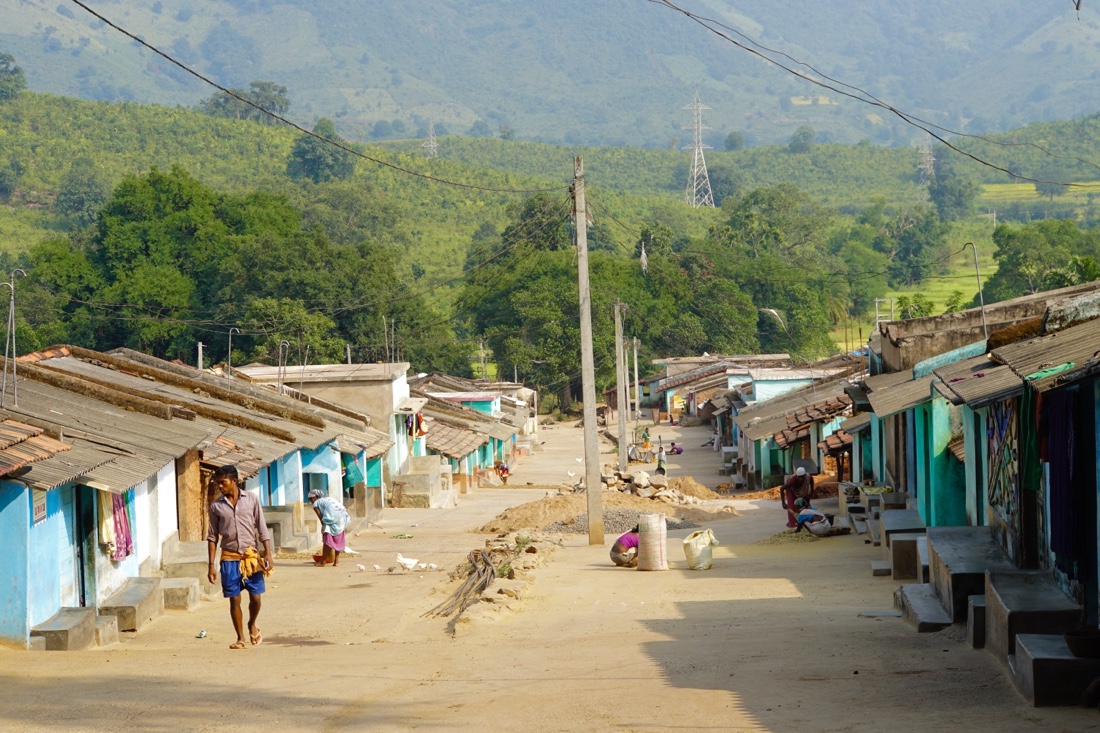 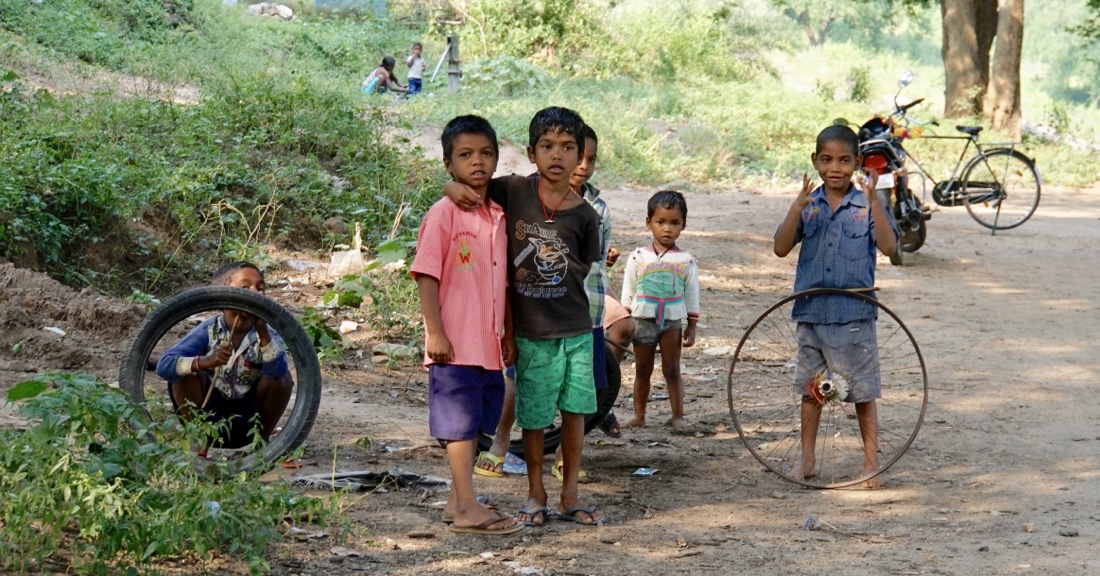 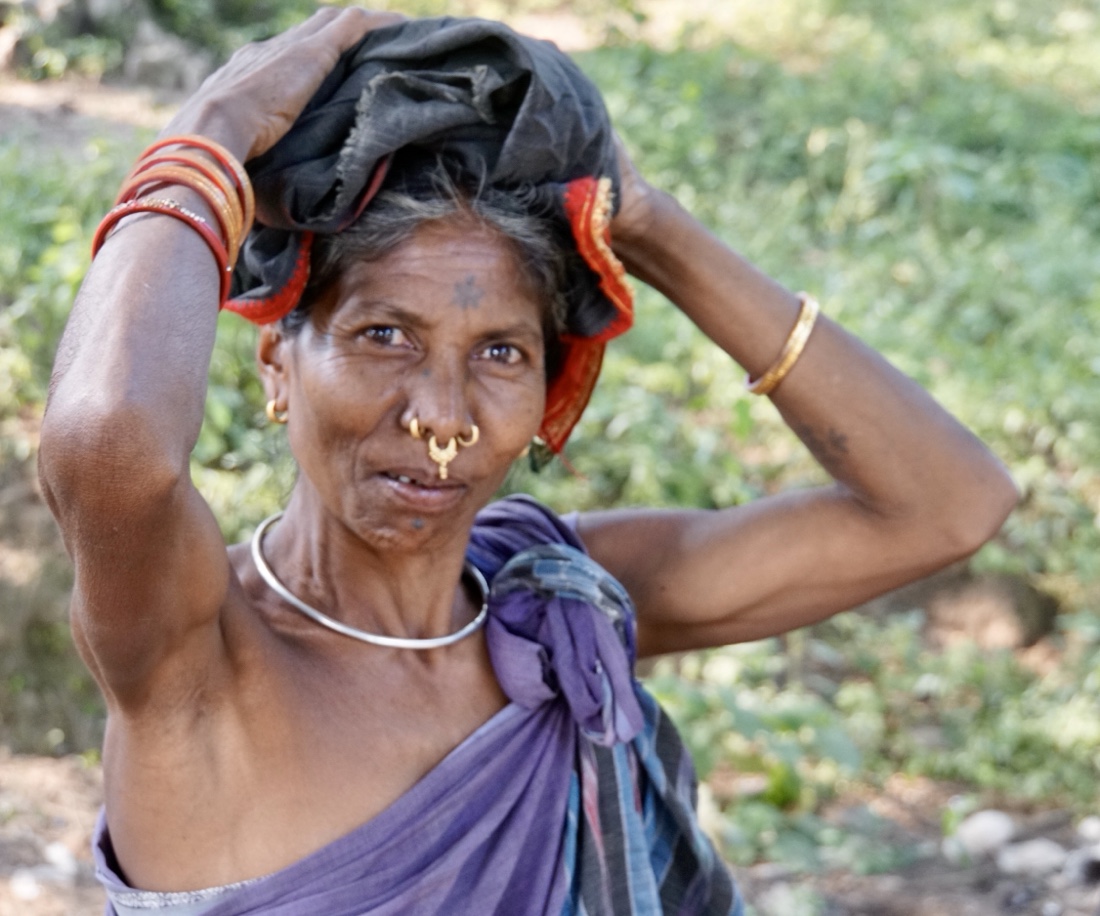 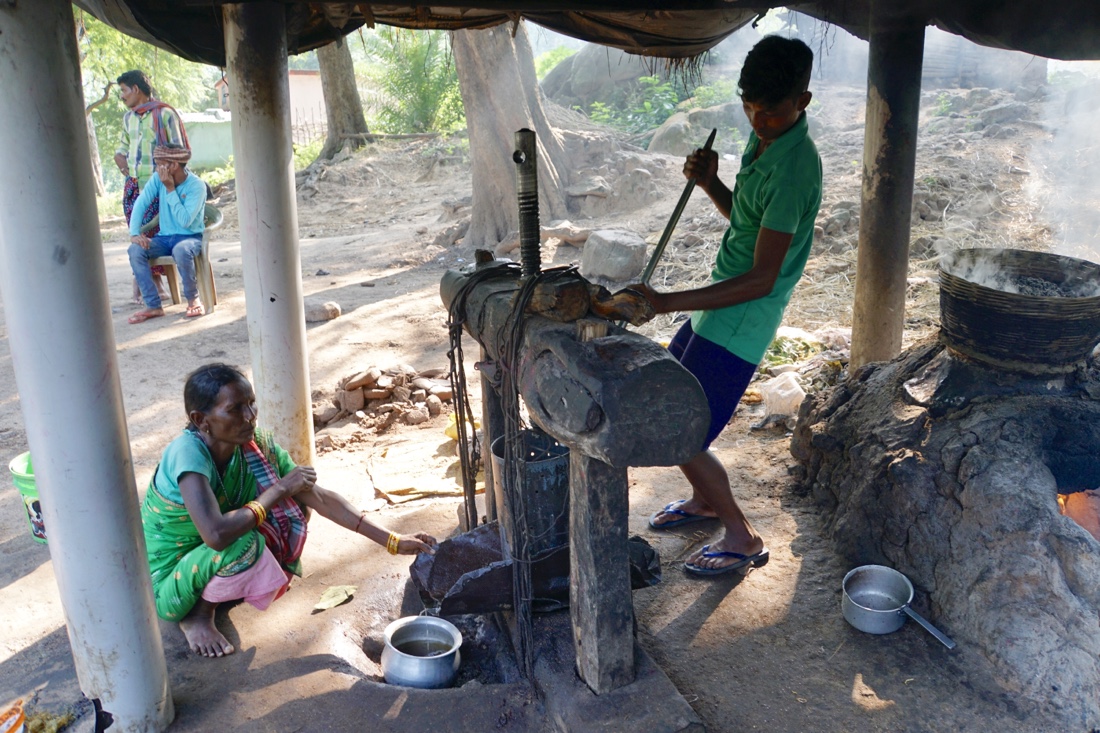 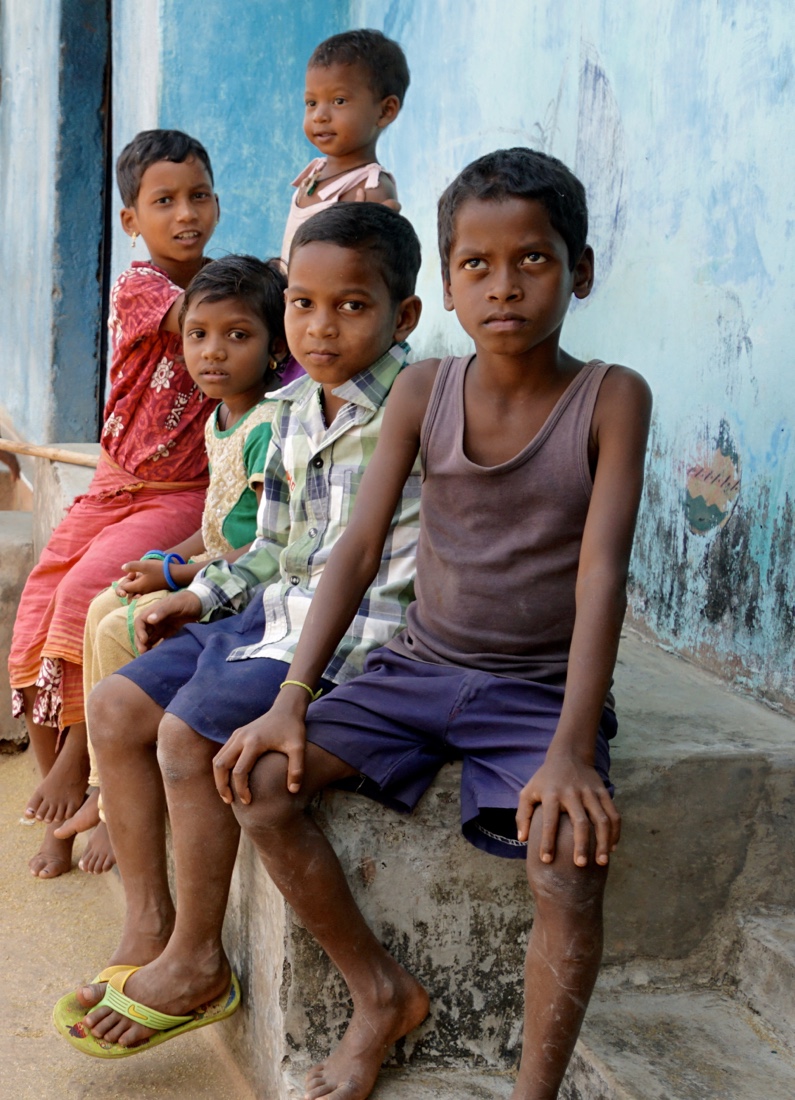 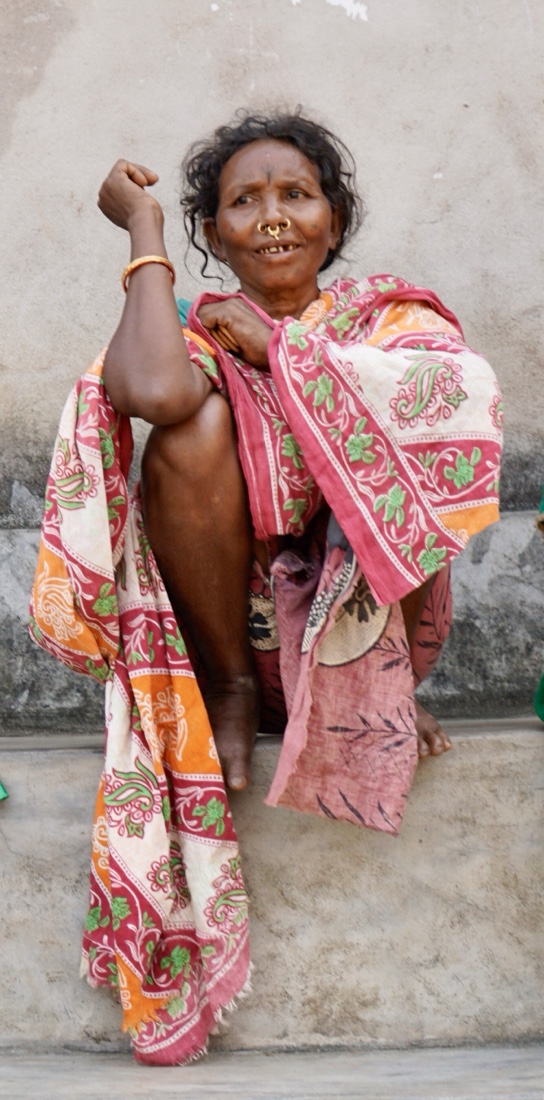 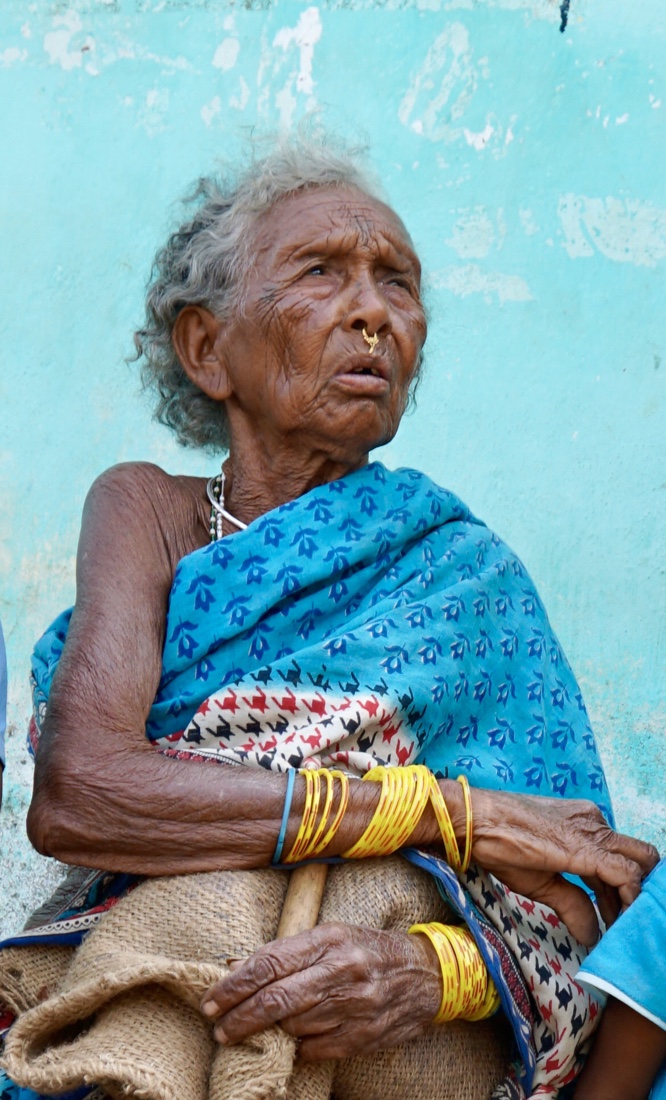 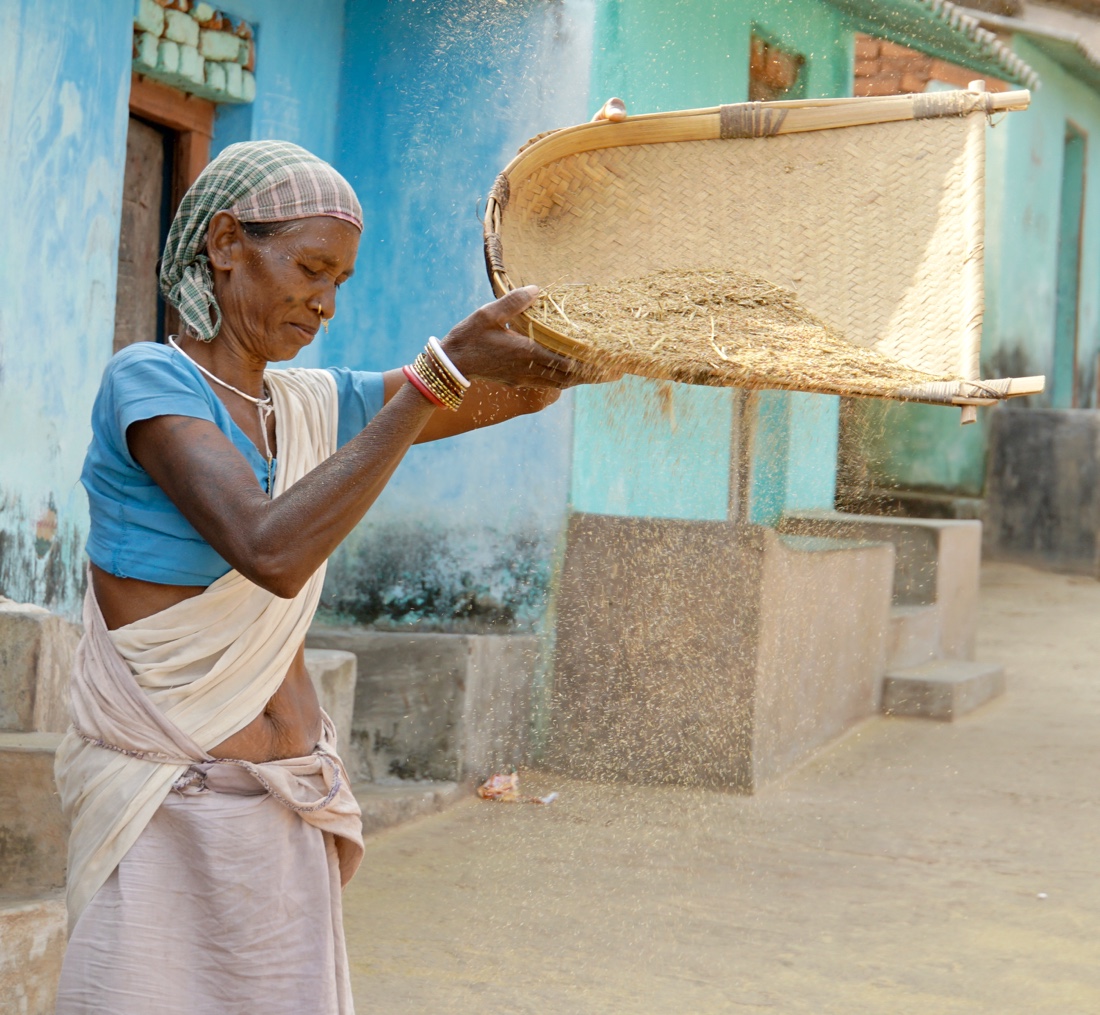 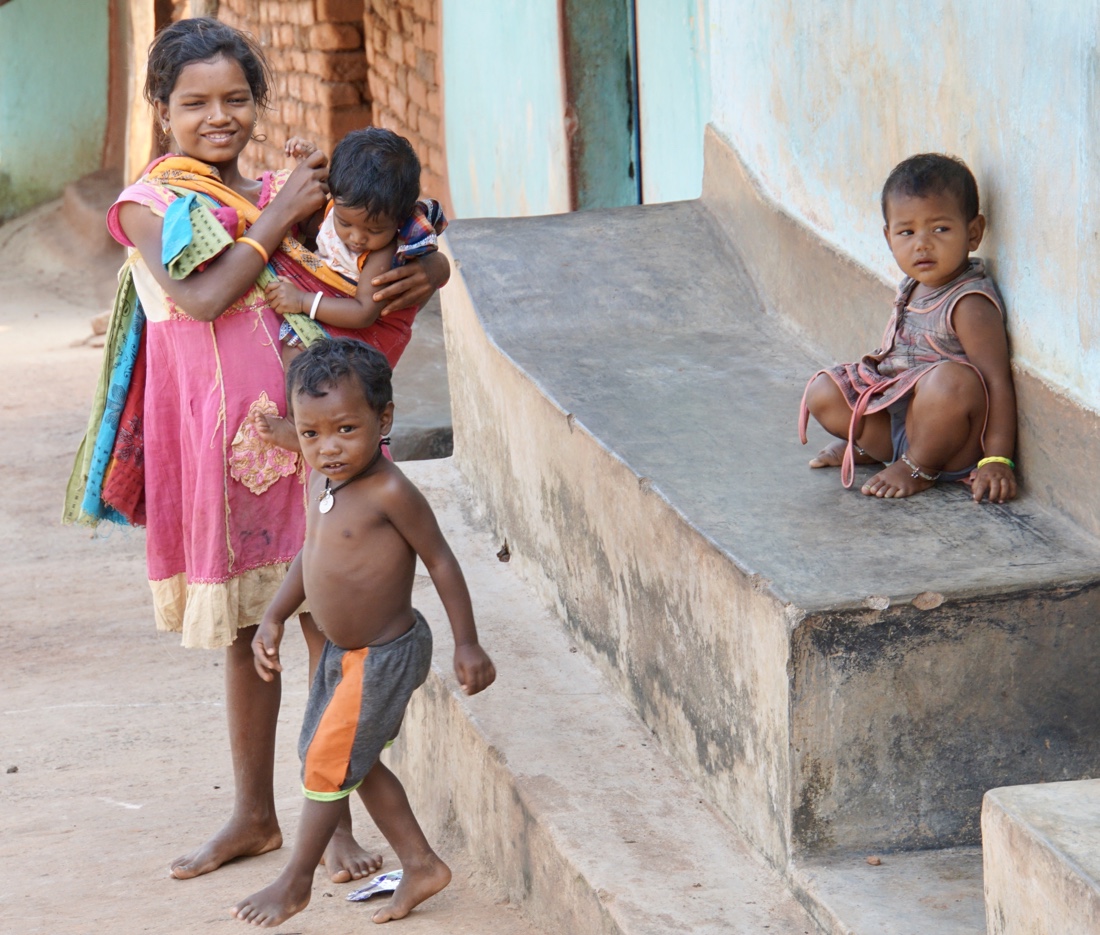 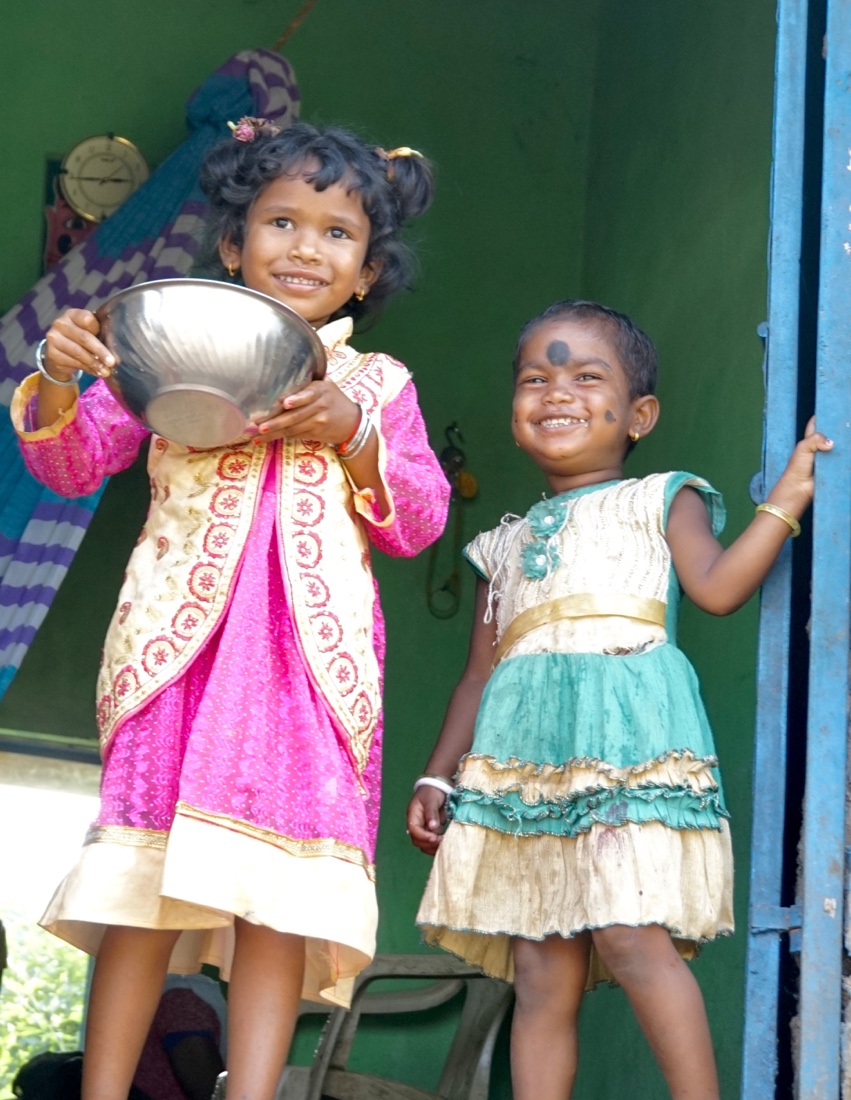 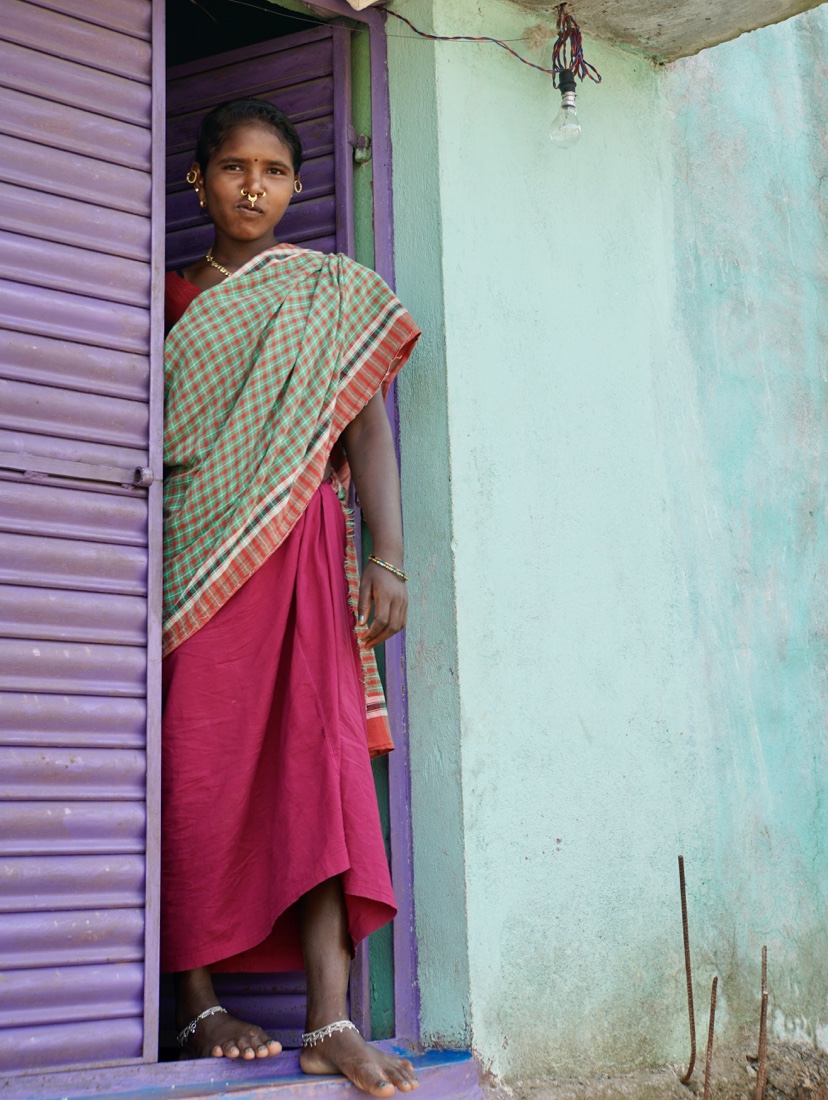 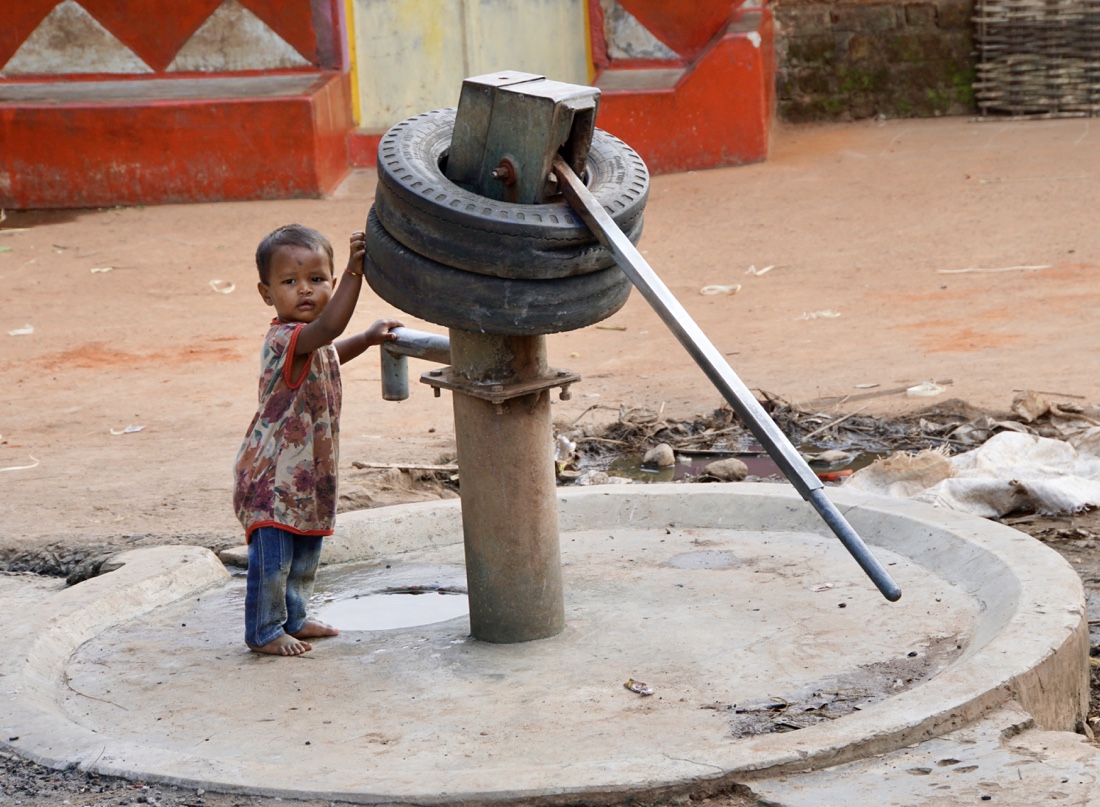 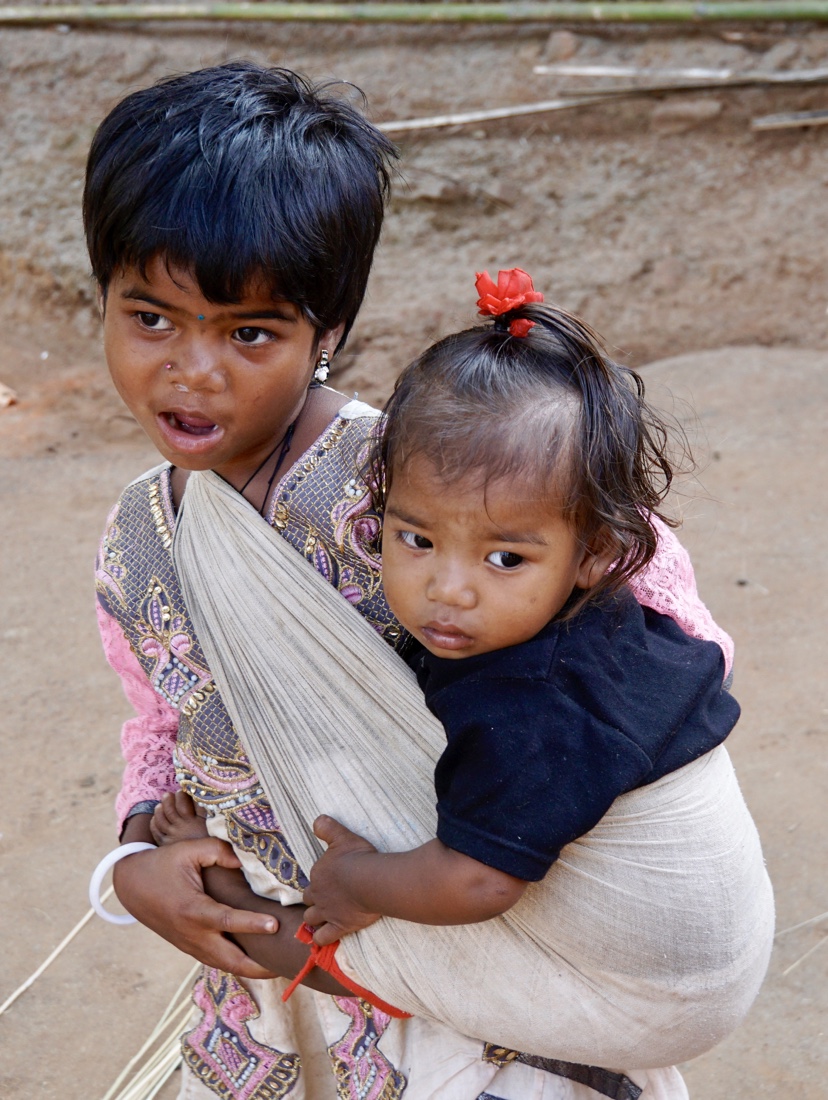 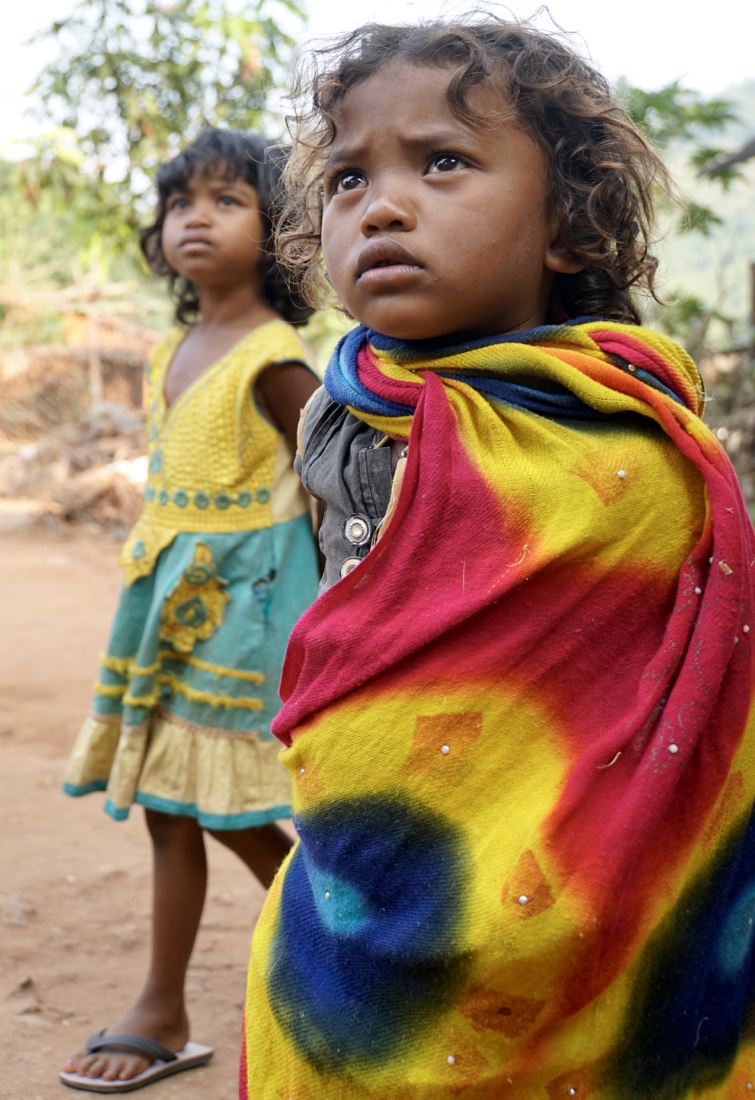 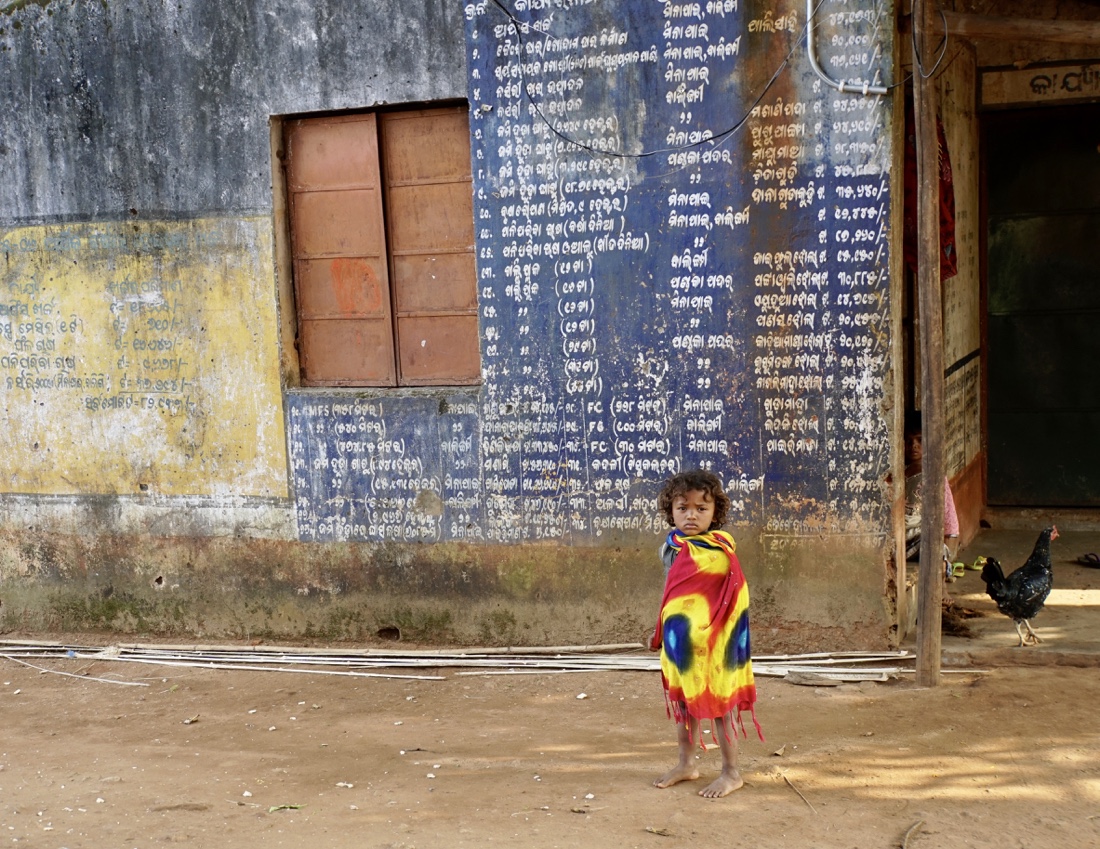
We return to the hotel, eleven hours after setting off, and I have a couple hours to relax, shower and blog, before another good dinner. Two French have stayed behind, Yves, about to be 65, and his daughter, Melodie. Yves has masked the fact that his English is excellentt and he talks about an amount of travel that makes me seem like a homebody. The two Spanish people, whose English is a bit better than my Spanish, are also at the table. The guy, whose name I did not get, travels around the world studying shamans and their methods of healing. He’d be a helluva interesting guy to have at a dinner party, if his English were better.
Over night and during the day today, I succeed in changing my plane reservations, so that I fly from one unpronounceable city directly to Delhi, rather than first flying from that unpronounceable city to Kolkata. The old plan made sense when I was going to take a group trip that ends in Kolkata, but it does not make sense now. With the help of travel agents in the US and Delhi, I figured out how to change it (at some cost, but, what the hell, it’s only money and I’m probably going to die of this cough, anyway, unless the Vick’s Vaporub that Prasant bought me manages to save me.) I’m going to try to make it through the trip, though, so that you can see how it ends.
Tomorrow is another long day, as we set out at 6AM.
Here may be more than you ever wanted to know about the Konds, but give it a try.
THE KONDS
The name Kandha translates as “mountaineer” and probably comes from the Dravidian word konda meaning hill.The Konds themselves believe they originated in Orissa and have always lived in their present location. The Kond tribe has a number of sub-tribes, including the Dongria, Kovi, Kuttia, Languli, Penga, and Jharnia.
They worship the mother goddess called penu, which means goddess of Earrth. Gods and Goddesses are believed to be very sensitive to neglect, disobedience, and violation of taboos. They react by ruining a crop, sending a tiger to attack cattle, or making the offender sick. They have to be propitiated by blood-offerings, and so sacrifice is an integral part of Kond religion. Priests officiate at sacrificial rituals, which in former times included human victims as well as animal ones. The Meriah or human sacrifice was stamped out by the British in the late 19th century.
Worship of the spirits of dead ancestors is also an important aspect of traditional Kond religion.
All important festivals are accompanied by animal sacrifice. Following the suppression of the Meriah human sacrifice, the Konds accepted buffaloes as substitute victims. Thus the Meriah festival, which is held between March and May, is still celebrated with buffaloes sacrificed as an offering to the Earth Goddess.
.
Kond houses or huts are rectangular in shape, with the walls made of timber and plastered over with mud. The floor is of hardened dirt, and the low roof is built of bamboo thatched with grass. The huts are small, consisting mostly of one room, which is shared with the livestock. Furnishings are sparse, with the occupants sleeping on wooden cots or reed mats. Only the father, mother, and younger children sleep in the house. Around the age of eight or so, Kond girls and boys leave home to live in segregated village dormitories under the supervision of an elderly female. As in many tribal societies, the dormitory system lends itself to a somewhat casual attitude to premarital sex among Kond youth.
Konds are divided into clans, each of which claim descent from a common ancestor. Typical names of subclans are Hikoka (horse), Kelka (kingfisher), and Kadam (a tree). The Konds are a warlike people, and in the past clans were continually fighting one another. Conflicts were usually over land or women.
The Kond family is typically patrilineal and nuclear in structure. Women are highly respected and are entitled to almost the same privileges as are men. Women manage the household, plant and weed the rice paddies, and raise the young, but they are also consulted before decisions are made in domestic affairs. Women attend the village council, where they can voice their opinion on matters relating to community affairs.
The traditional dress of Kond men is a long cloth, a few inches wide, that is wrapped around the waist and drawn between the legs.
Rice is the staple food of the Konds. It is eaten with lentils and with wild leafy vegetables gathered in the jungle. The diet is rather bland compared to the spicy curries eaten by other peoples in India. Konds are nonvegetarian, eating eggs, chicken, buffalo, goat, pork, and even beef. The Konds do not use milk. Wild game is hunted in the forest to supplement the diet. Konds enjoy alcohol, drinking rice-beer, toddy, or liquor made from mahua flowers.
Access to educational facilities has always been a problem for Konds living in the remote interior of the Eastern Ghats. Although some 30% of Kond children attend government schools today, many drop out because of economic hardship and the need to help support their families. The drop-out rate by Grade 5 is close to 80%. Literacy among Konds is low, with the rates (2001) among the Dongria Konds, who live in the Niyamgiri ranges of Orissa, being 29% for men and 14% for women, respectively.
Music, song, and dance play an important role in traditional Kond culture. Instruments include trumpets, drums, and the shepherd’s pipe. The deka, a two-stringed violin made with a bamboo stick and gourd, provides the musical accompaniment as the poet sings, or rather chants, the verses. There are songs for every occasion—love songs, songs to be sung on the eve of the Meriah sacrifice, at marriages, at the time of plowing, and at the time of death. Of greater importance is the Kond dance. Every village has a place set aside for dancing. In a dance of the Kuttia Konds, boys and girls stand in a row facing each other. They link arms and shuffle back and forth in time to the music, getting more agitated and excited as the tempo of the dance quickens. Konds arm themselves with weapons for the war dance, in which they mimic a battle scene. In a hunting dance, a man wearing the horns and skin of a wild animal is chased and captured by a party of “hunters.” Dancing accompanies festivals, marriages, and other important events and may continue day and night until the dancers are exhausted.
Although originally hunters and gatherers, most Konds are now engaged in agriculture. Rice, maize (corn), and pulses are important food crops, while turmeric, mustard seed, and legumes are grown as cash crops. Many Konds work as agricultural laborers, while some still hunt or gather forest products such as teak.
Of particular interest are the relationships of the Konds with the Panas and Doms. These are peoples who live in the Kond hill country, sometimes even in Kond villages, who act as traders, money-lenders, and intermediaries between the Konds and the Hindus. They also carry out certain ritual functions, which the Konds are forbidden to perform themselves.
.
Kond folk arts include tattooing, the carving of hairpins and similar objects out of animal bone, and jewelry-making. Konds are known for their skill in creating figures of animals and people out of brass and bronze. Other examples of Kond art are masks carved out of wood or gourds, elaborately carved wooden pillars formerly used in the Meriah sacrifice, and carvings on the doors of Kond houses.
October 23
After breakfast, we set out for a village some 40 kilometers away, called Boda Podder. We pass men working in the fields with water buffaloes.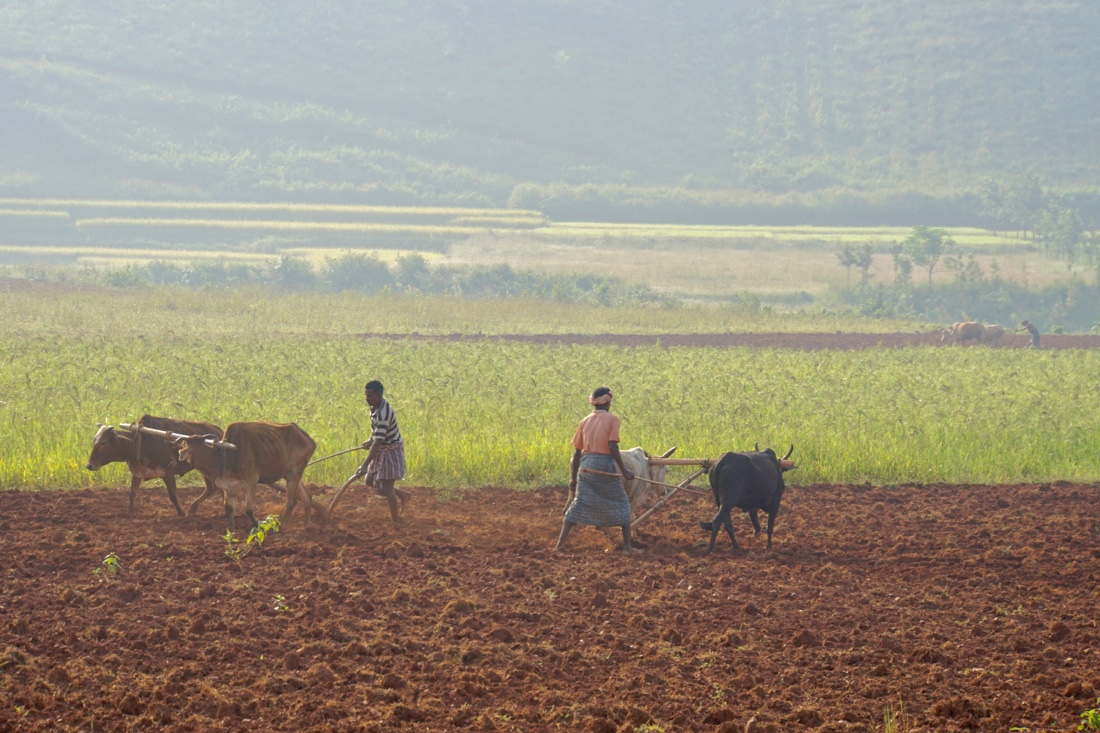
As we pass through villages we see daily life, women gathering water, a man squatting, brushing his teeth by the road, a group of men dressed in Western garb, with women in saris, nearby. We stop briefly for Prasant (I’ve been misspelling it as Prashant, which is how my Delhi travel agent spells his name) and our driver, Dilip, to have tea
We are in a pretty area, with hills all around, where all the hill tribes live.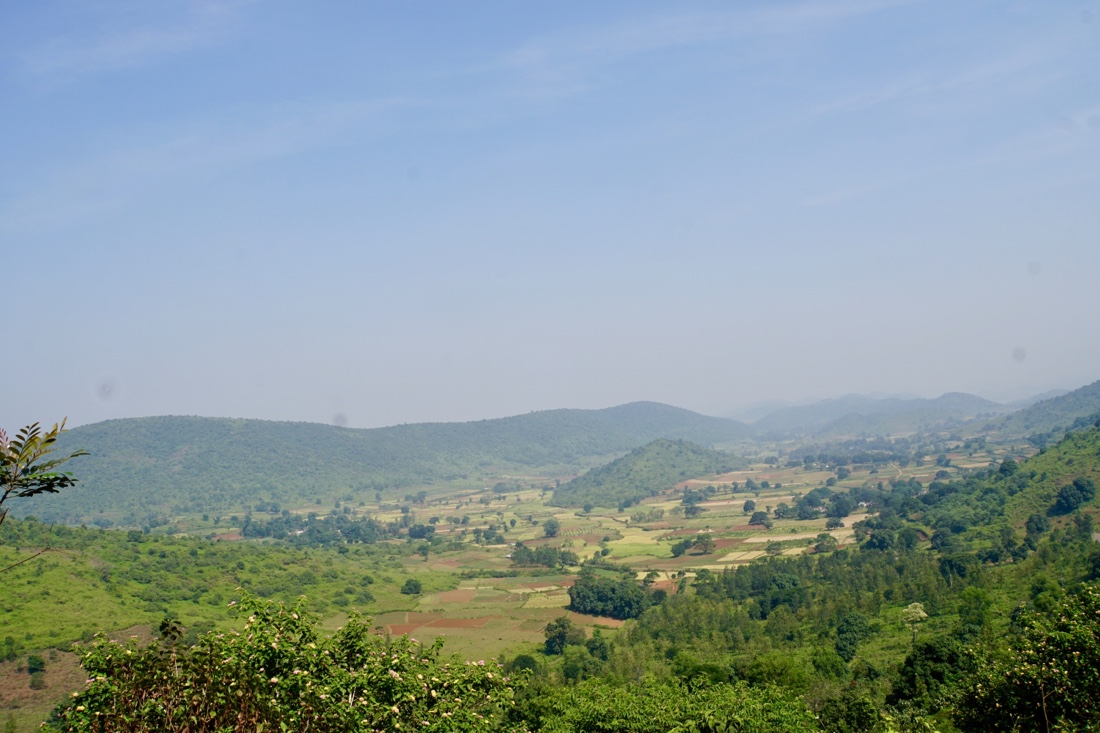
Most of the tribes have no roads, but the ones we’ll visit have had roads built by the government, who also has built schools, given people money to help them build houses, provided toilets and, in general, done much more for the tribal people than I would have imagined. The land is fertile, supporting ginger, potatoes, beans, cabbage, bananas, cauliflower and many other vegetables.
The Paika, a warrior tribe historically, who protected the king, and now works in agriculture lives in Boda Podder. The other village we visit, Mali Guda, is inhabited by the Mali tribe, who Prasant says are similar to Hindus. They don’t drink, and are good at growing organic vegetables, which they sell in the markets.
I walk leisurely with Prasant through these villages, sometimes pausing to sit down, and observe their lifestyles.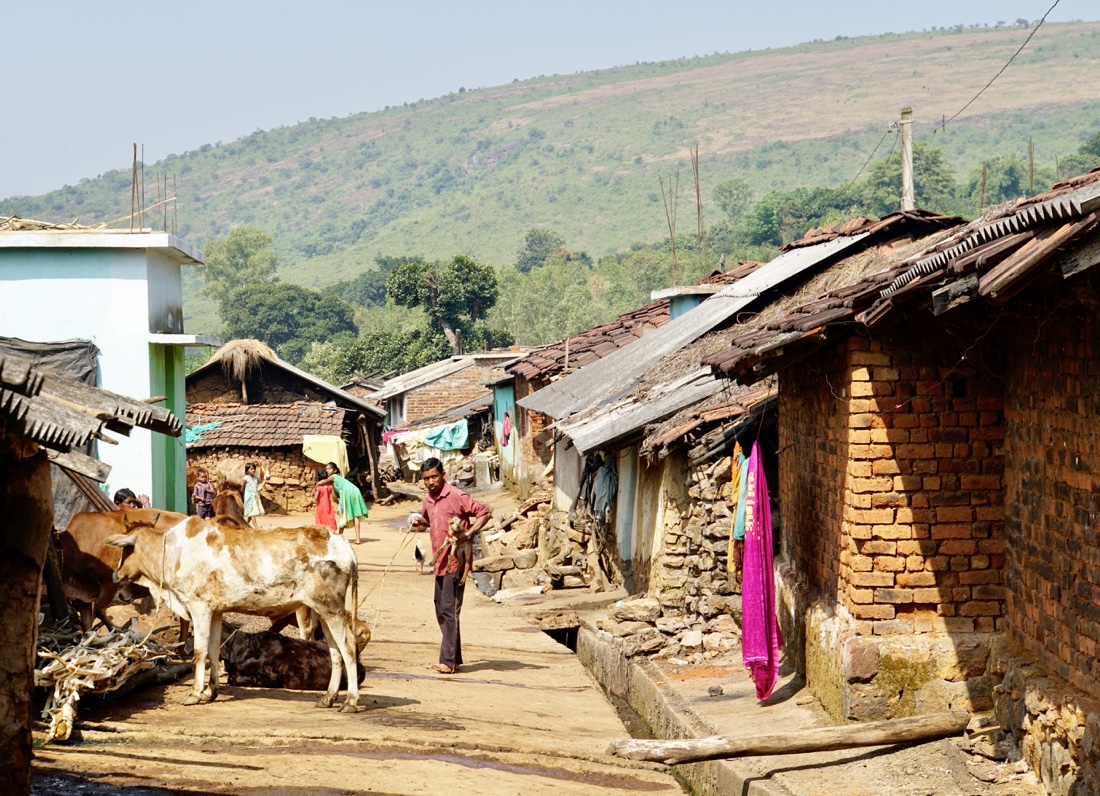 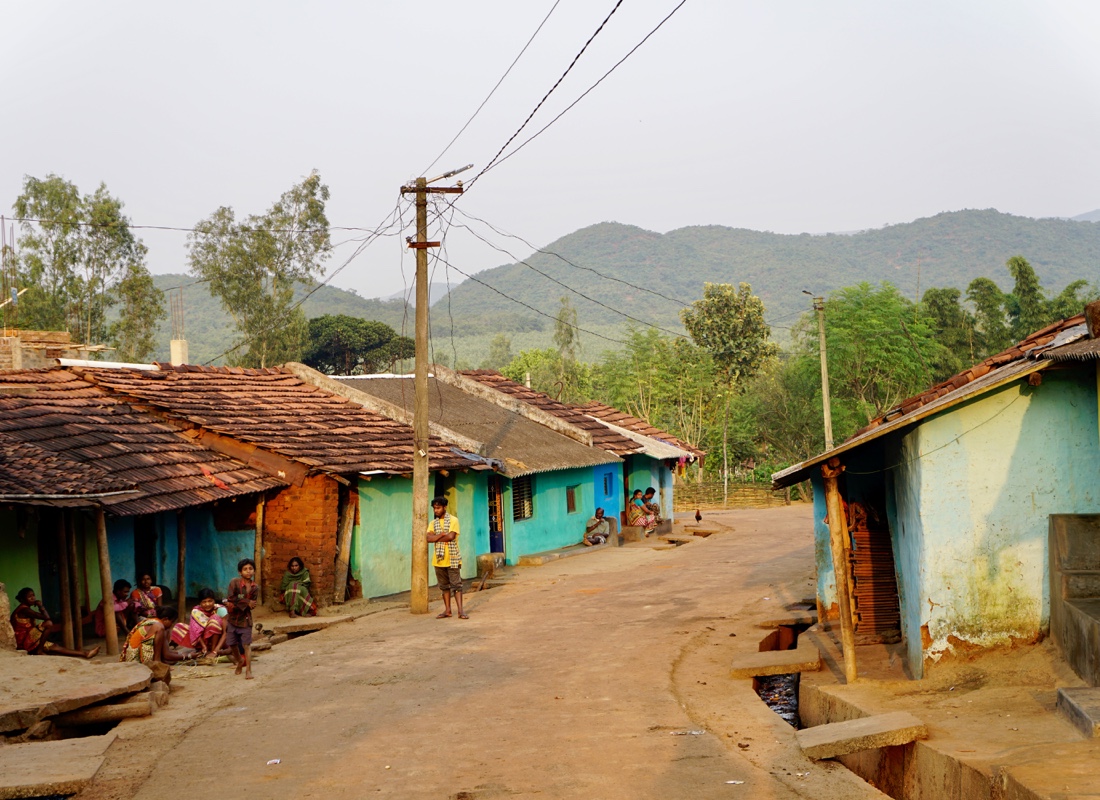
People are very friendly and we exchange greetings of “juhar ” with them, which is their version of “namaste.” Prasant is very good at pointing out details that I would otherwise miss. He’s very knowledgeable about the tribes, their lives and the agriculture surrounding the villages.
At various points, we see women carrying logs, repairing houses with mud and sweeping off the doorstep. We also see a group of men heading out to the field.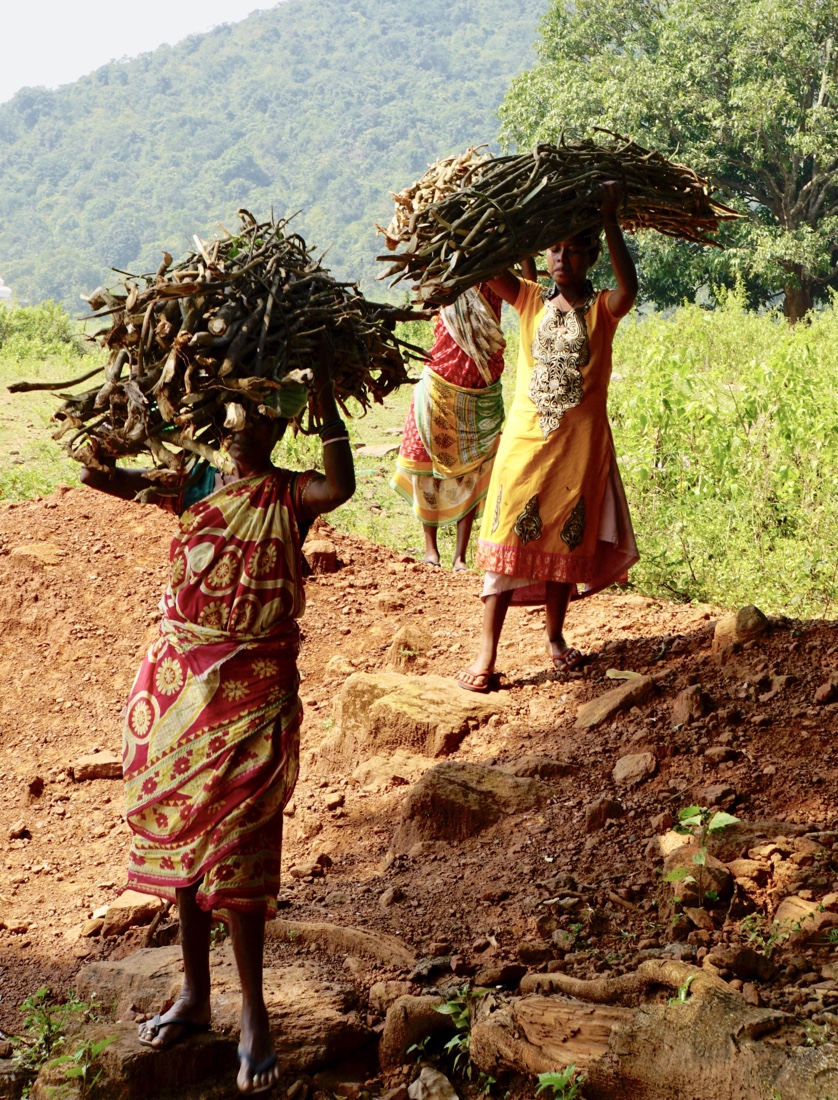 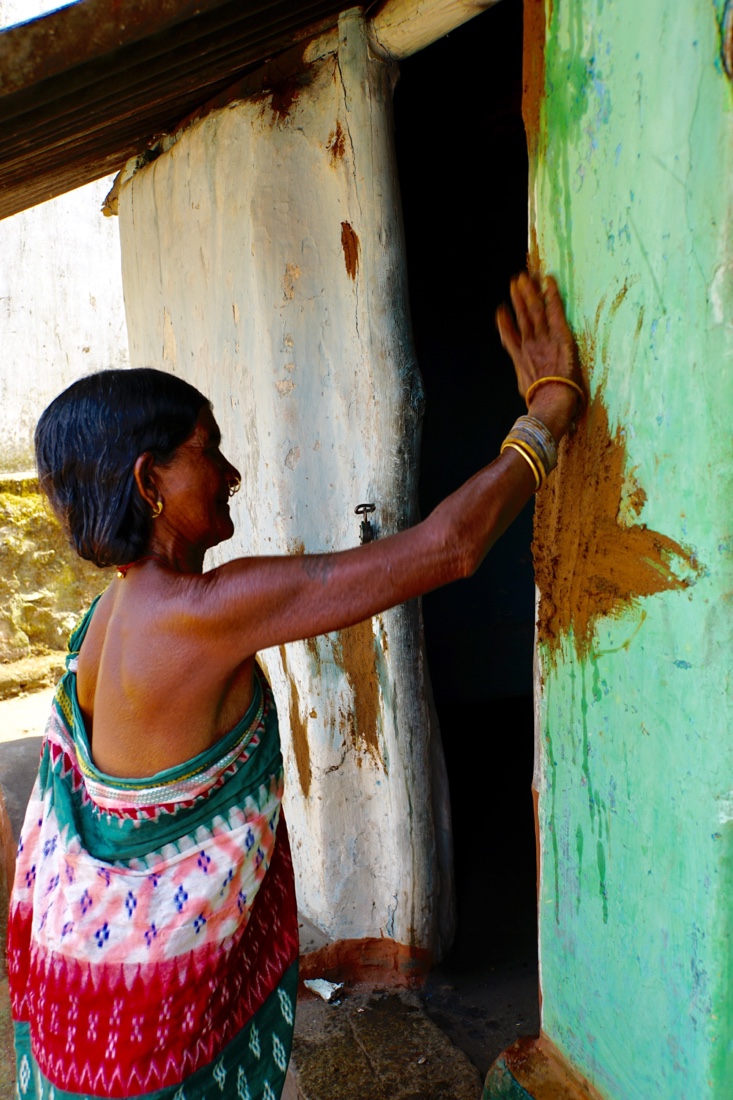 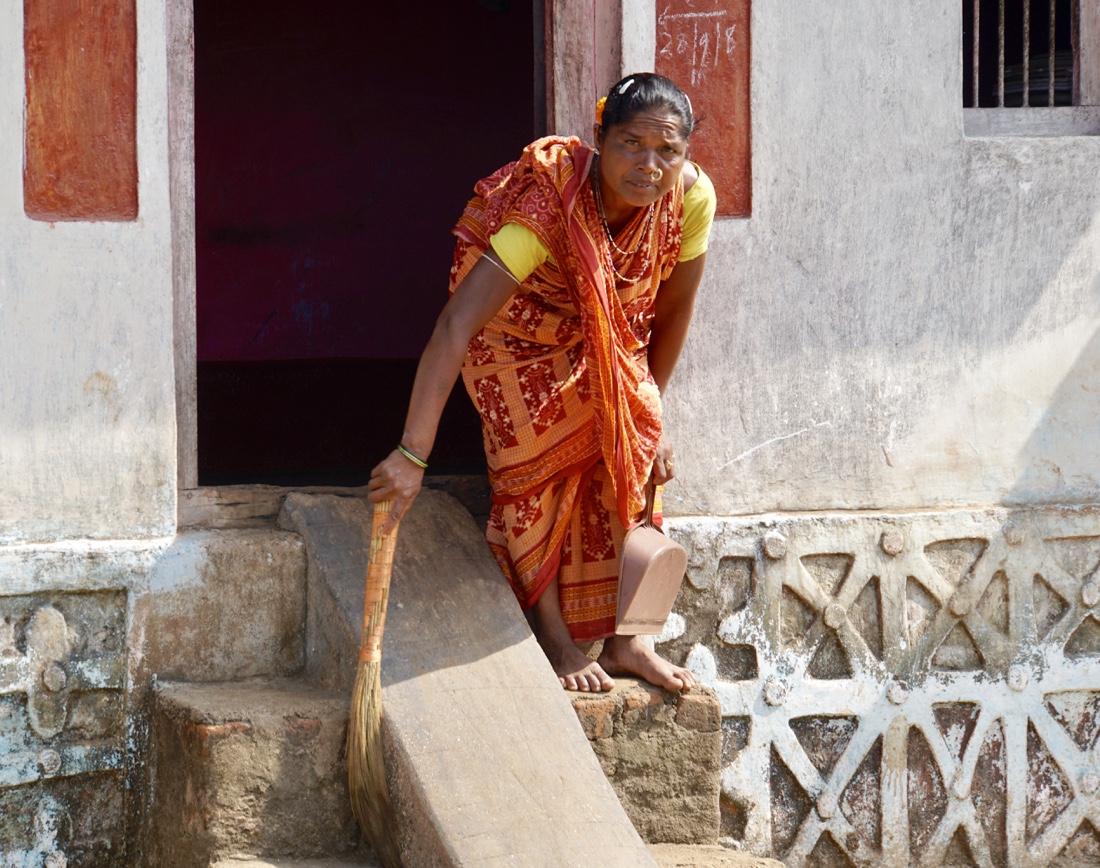 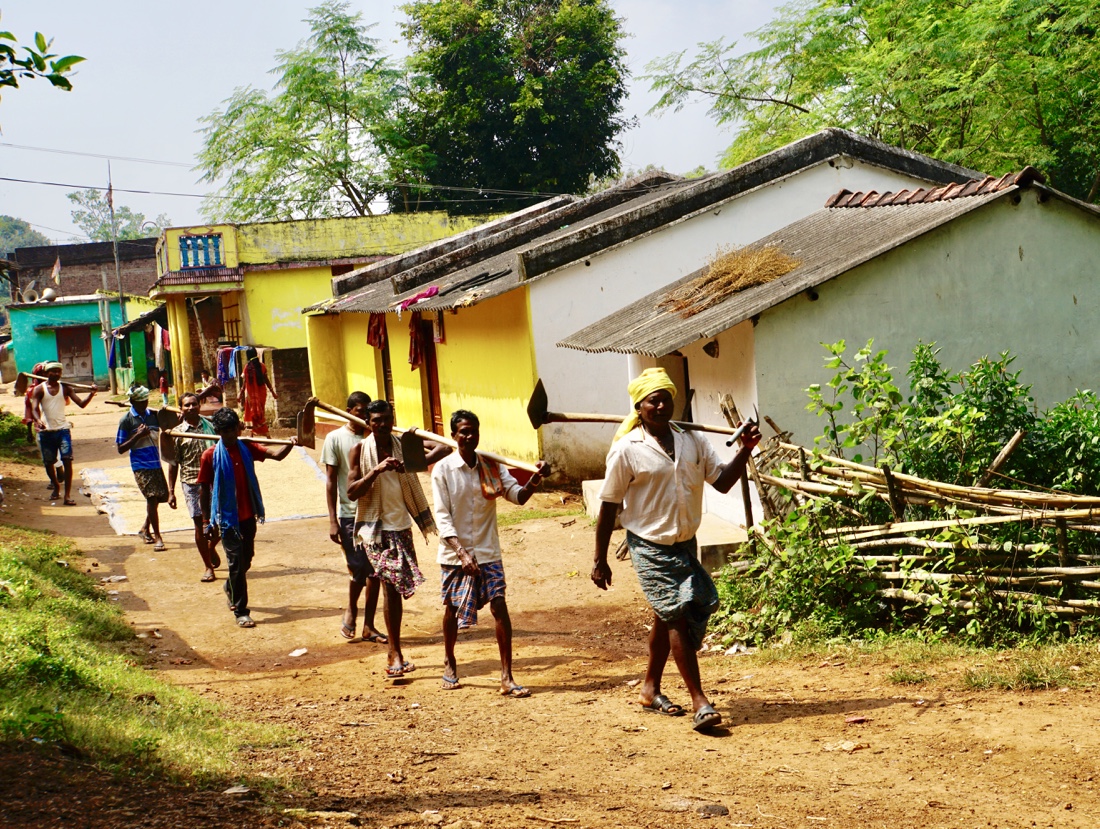
There’s a modern-day businessman selling children’s clothes from a rack on his motorcycle, and a small shopkeeper.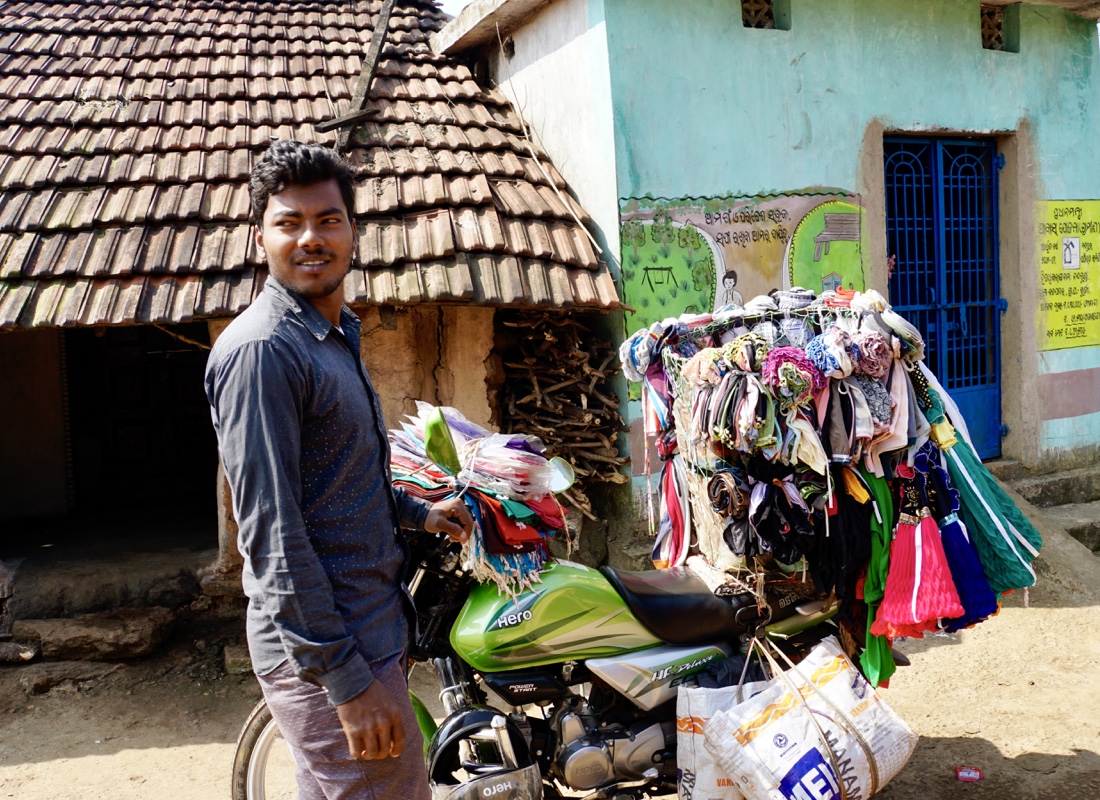
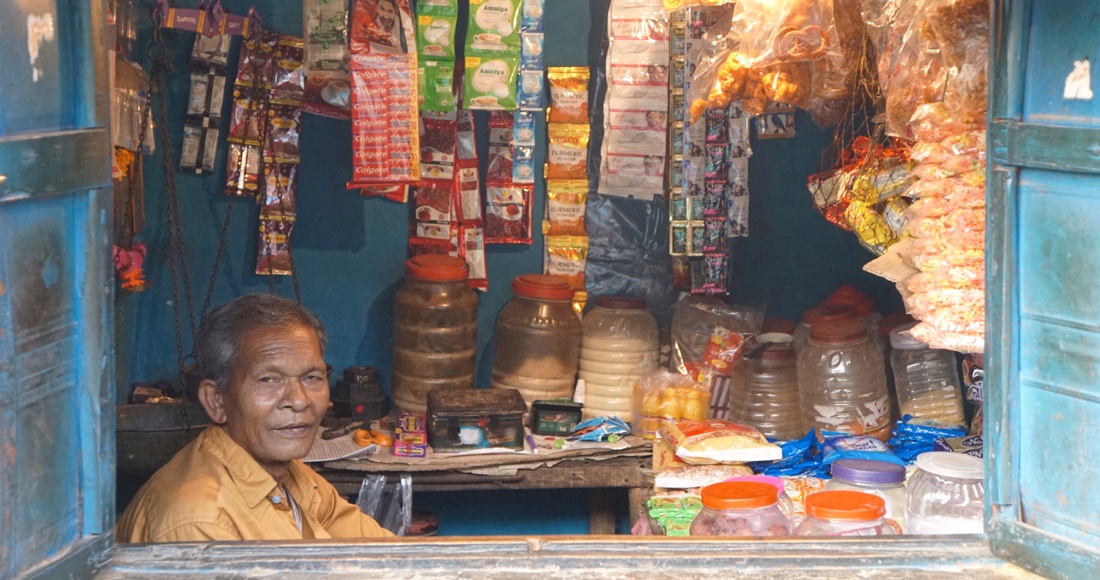 And the head of the second village poses with the goddess. And the head of the second village poses with the goddess.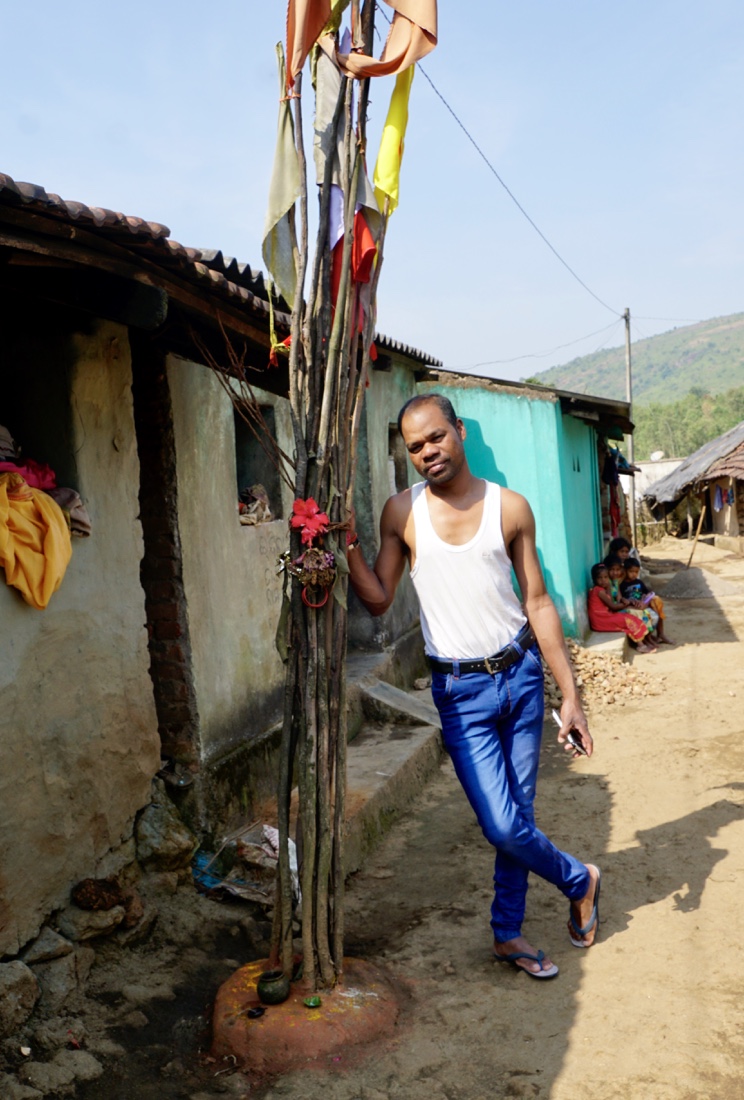
What I most enjoy, though, is photographing the people, so I’m including a healthy dose of those. Most are willing to be photographed, though some need to be coaxed. Often, they’ll stand ramrod straight, hands at their sides, and need to be encouraged to relax a bit. Sometimes the best approach is to take a stiff photo and show it to your subject, often eliciting smiles and laughs, which lead to better photos.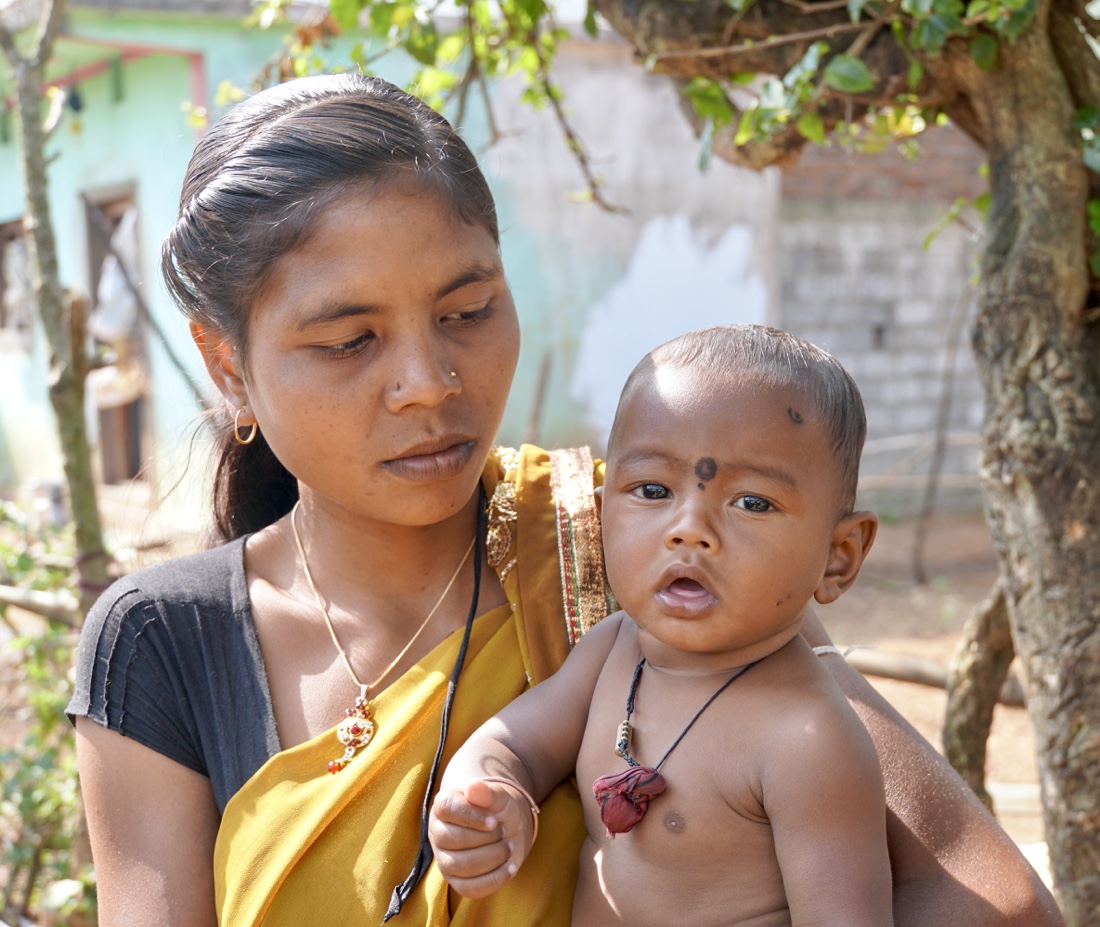 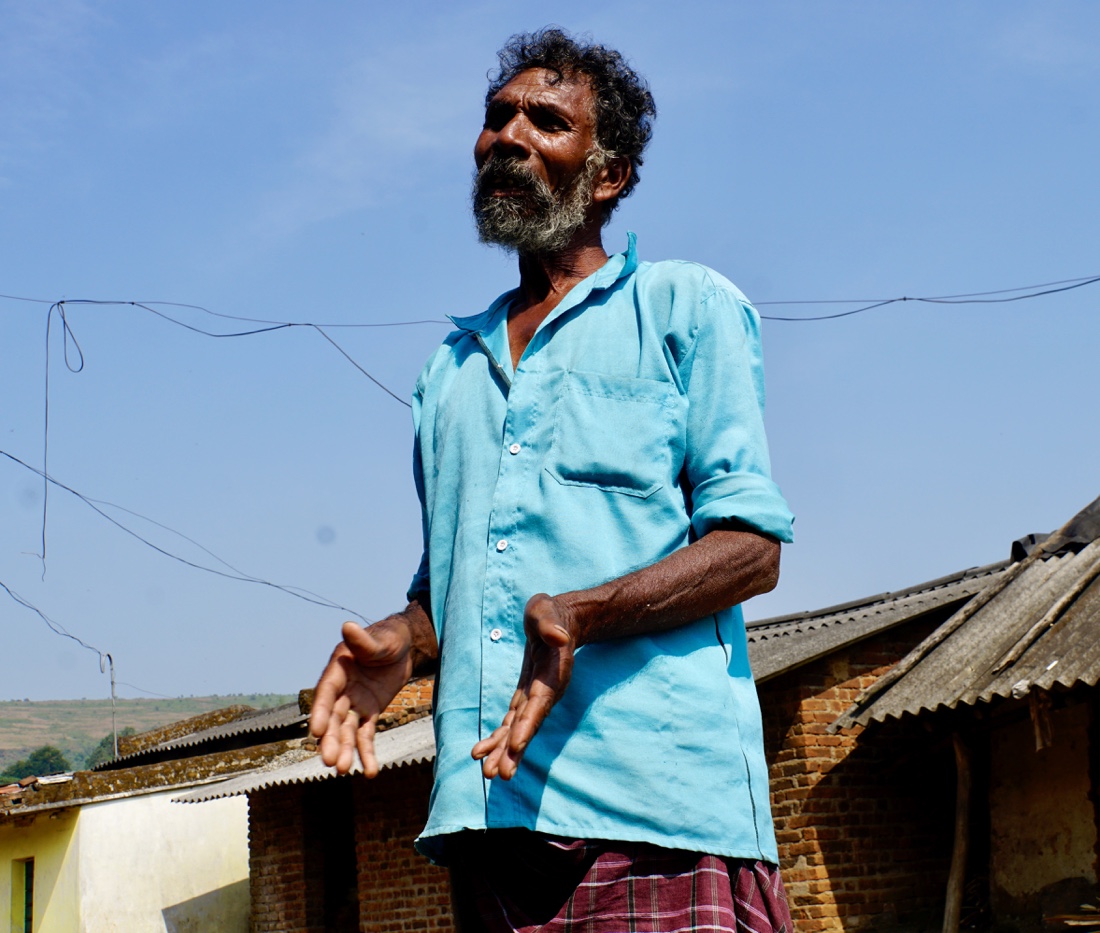 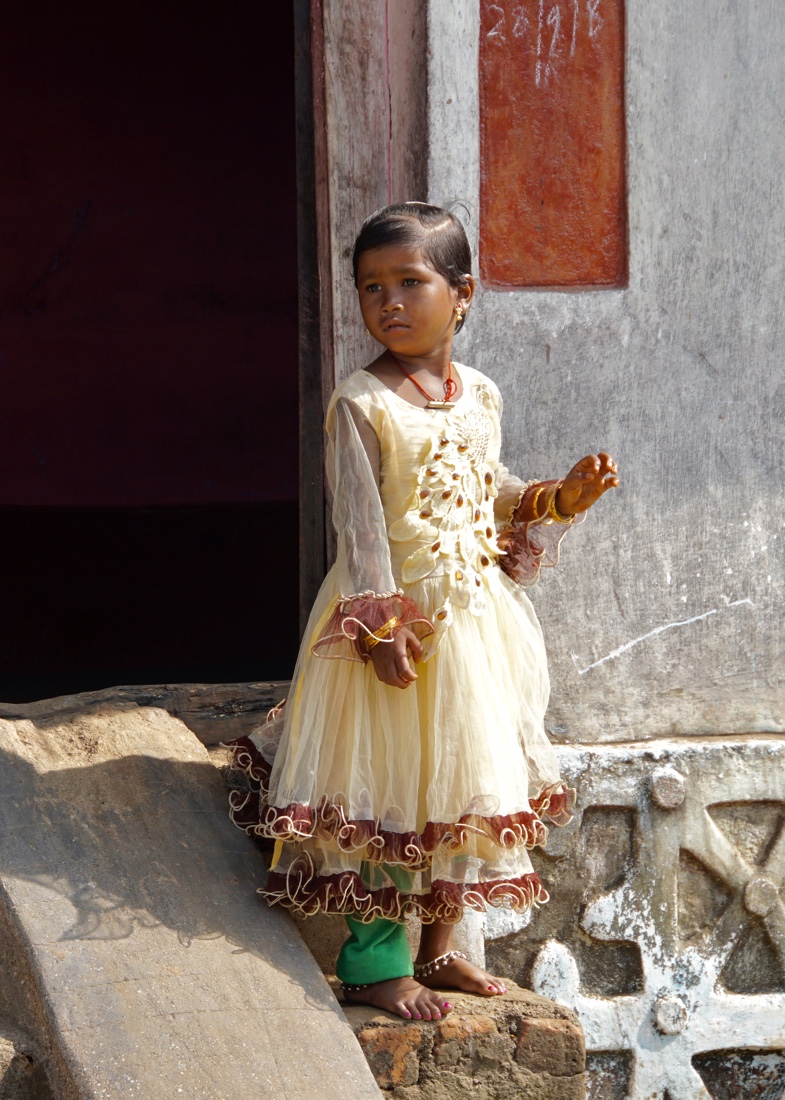 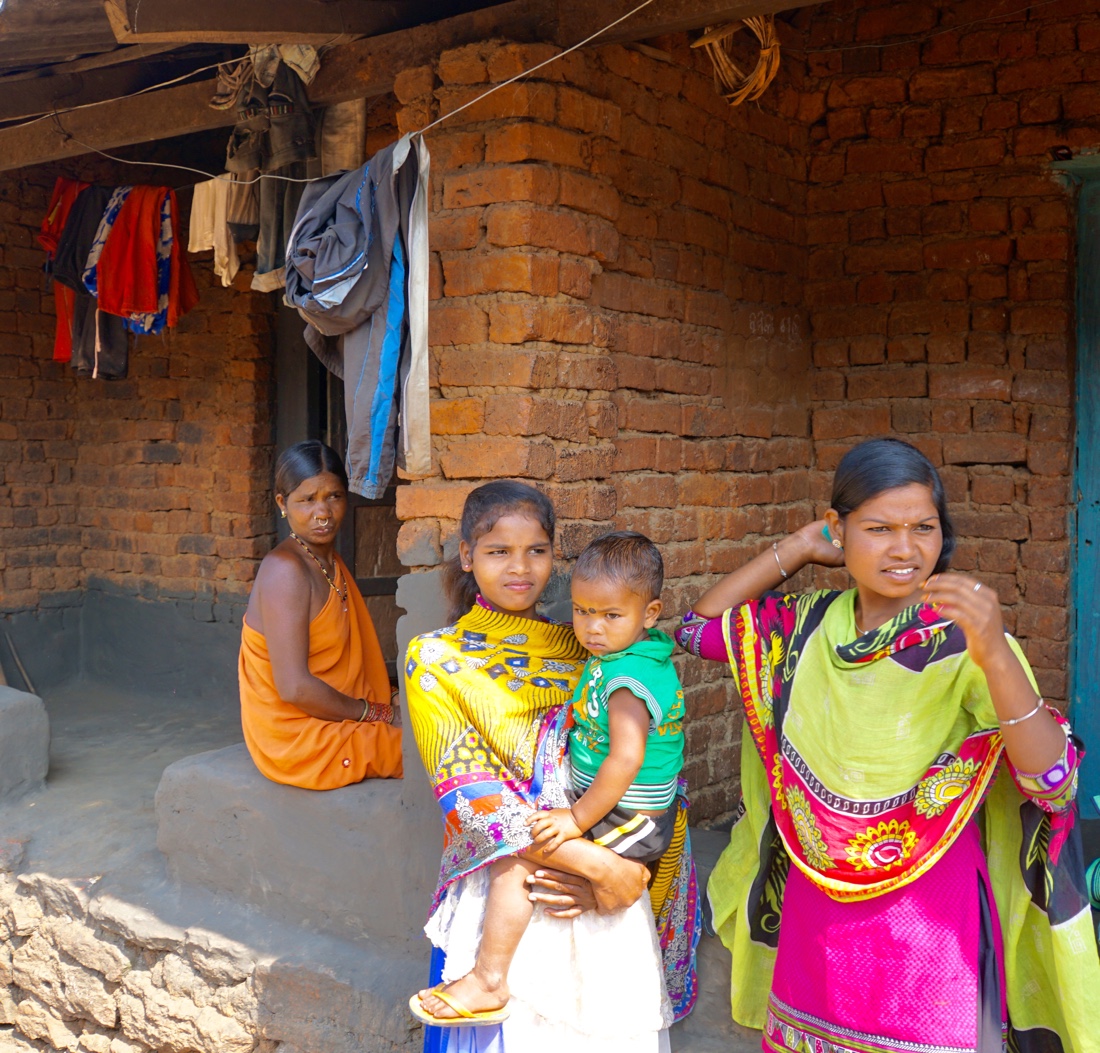 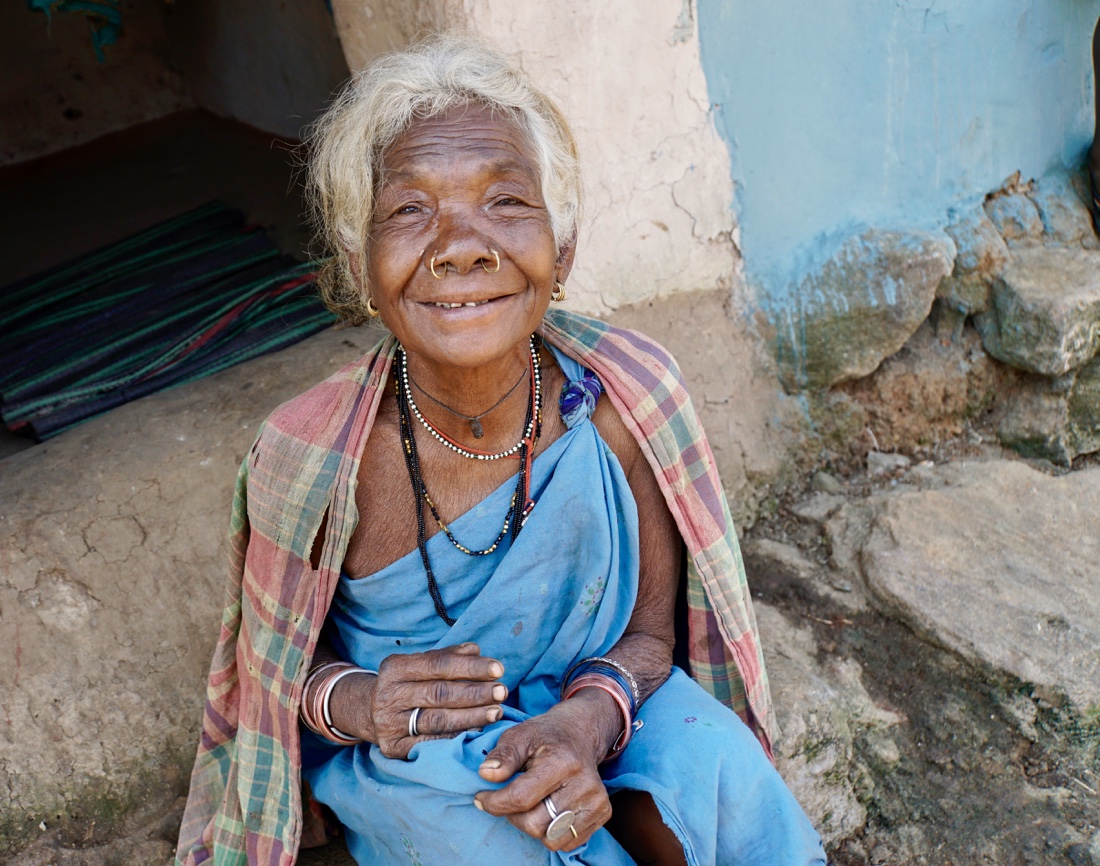 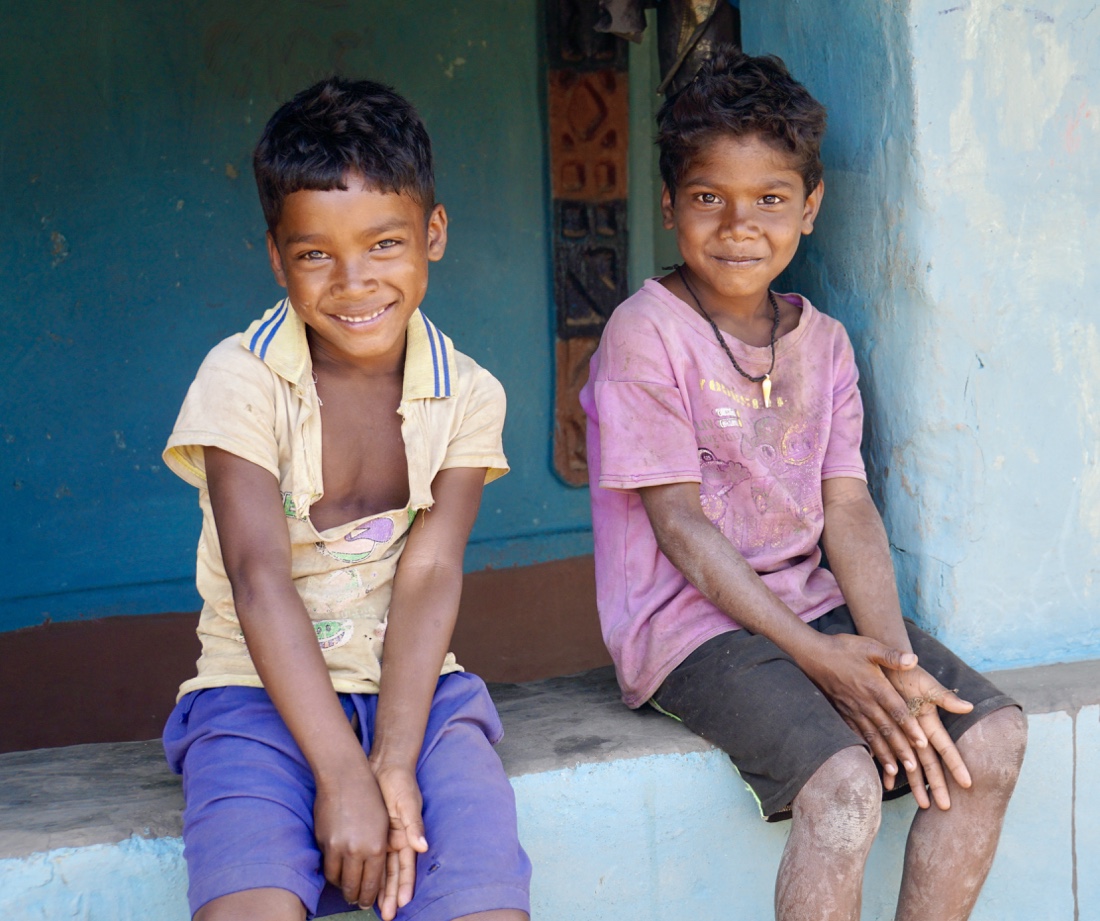 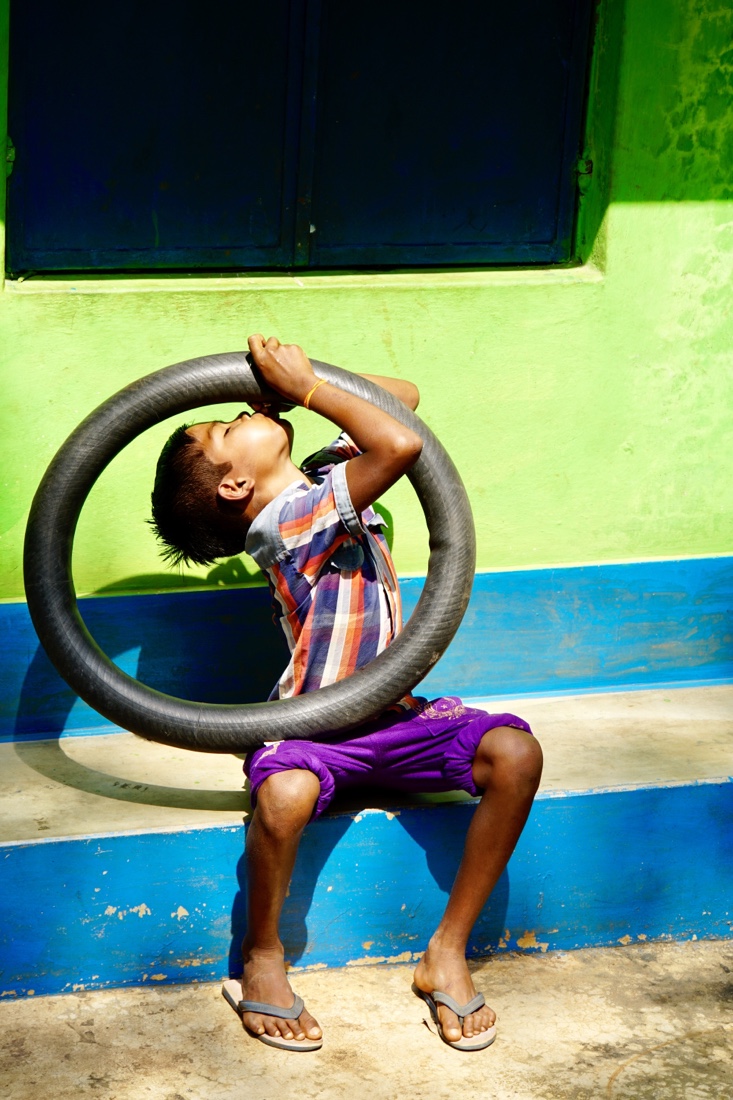 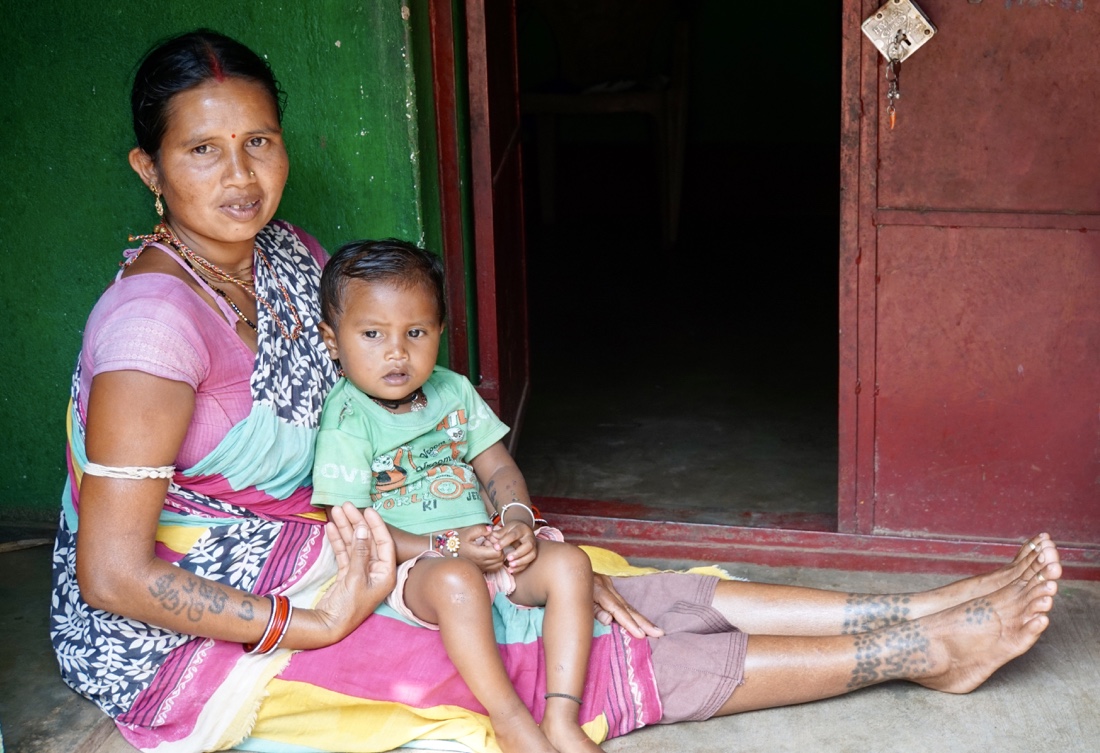 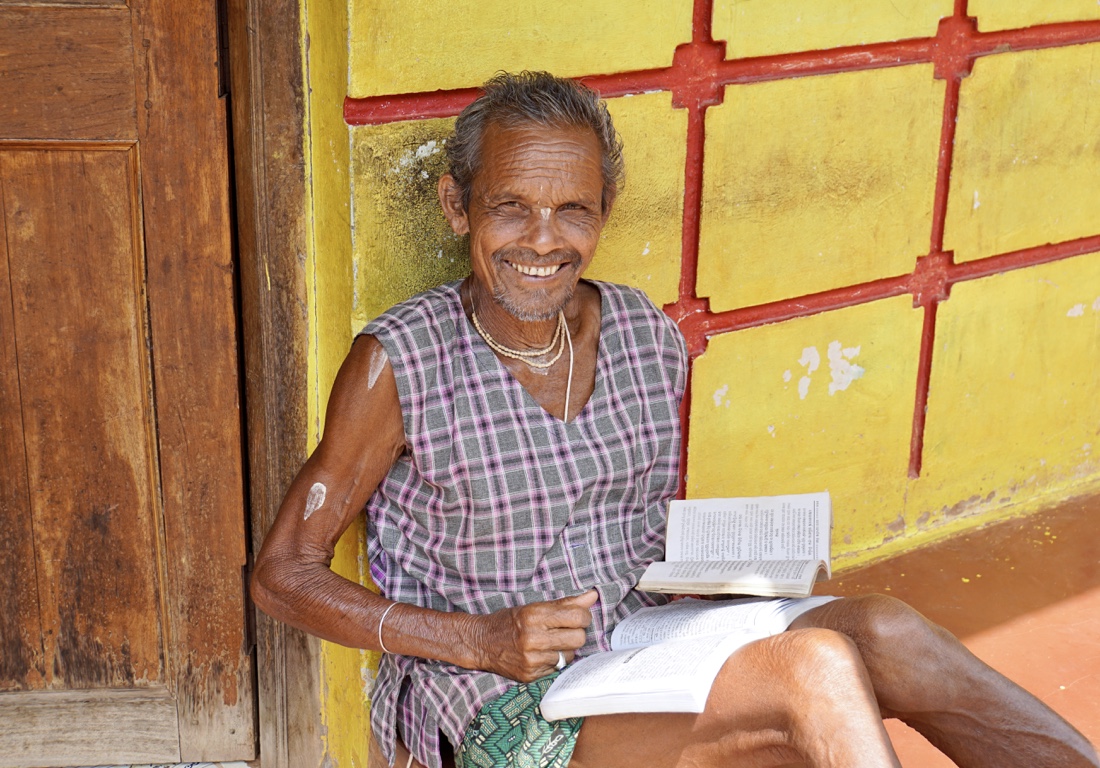 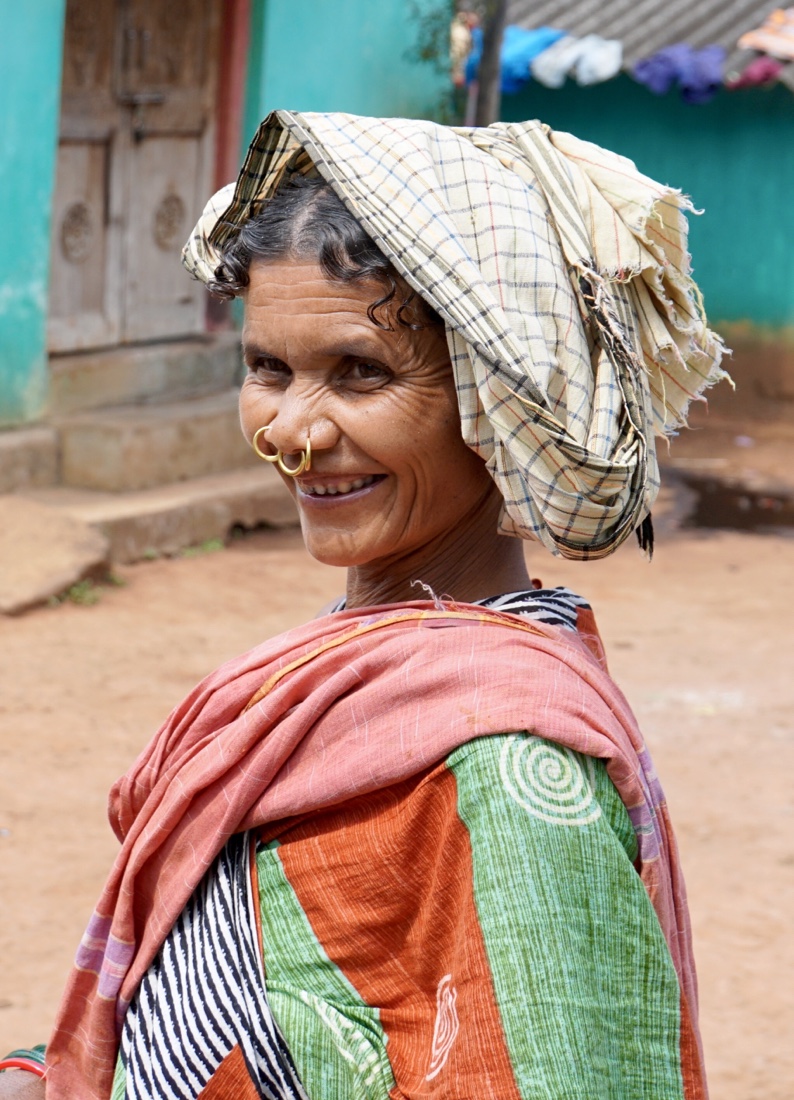
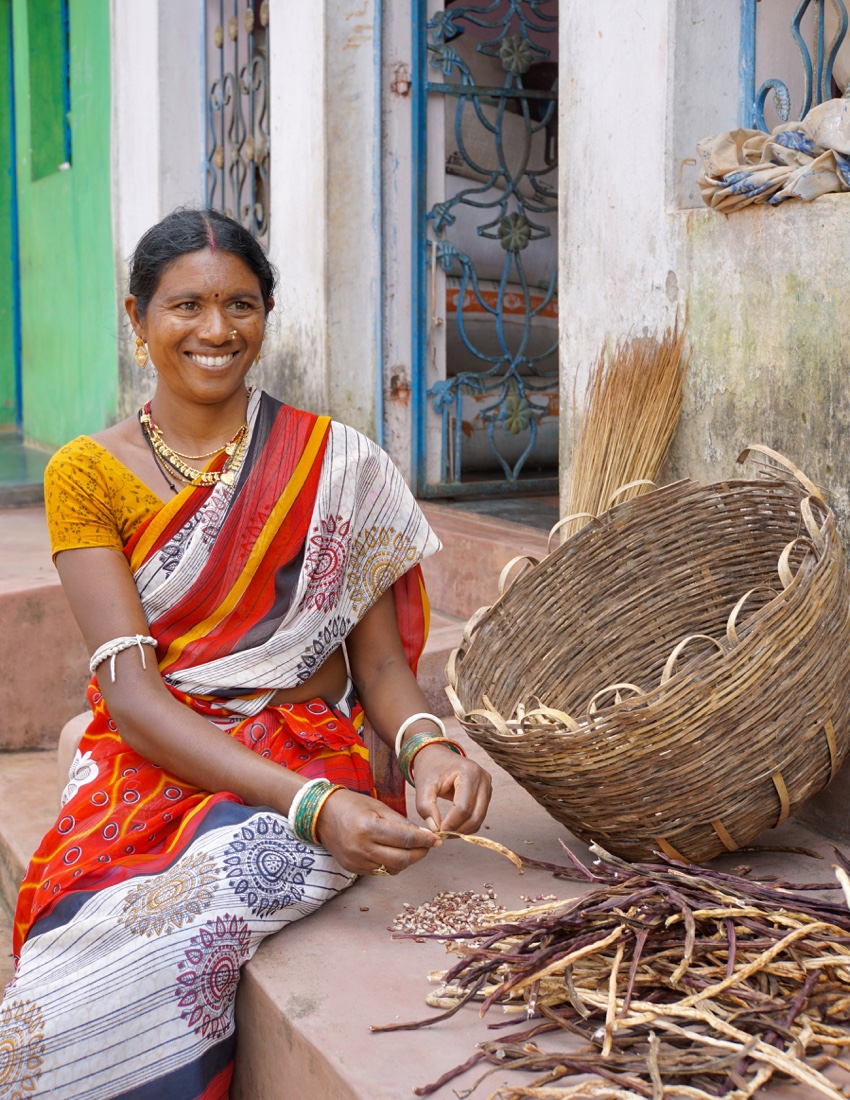 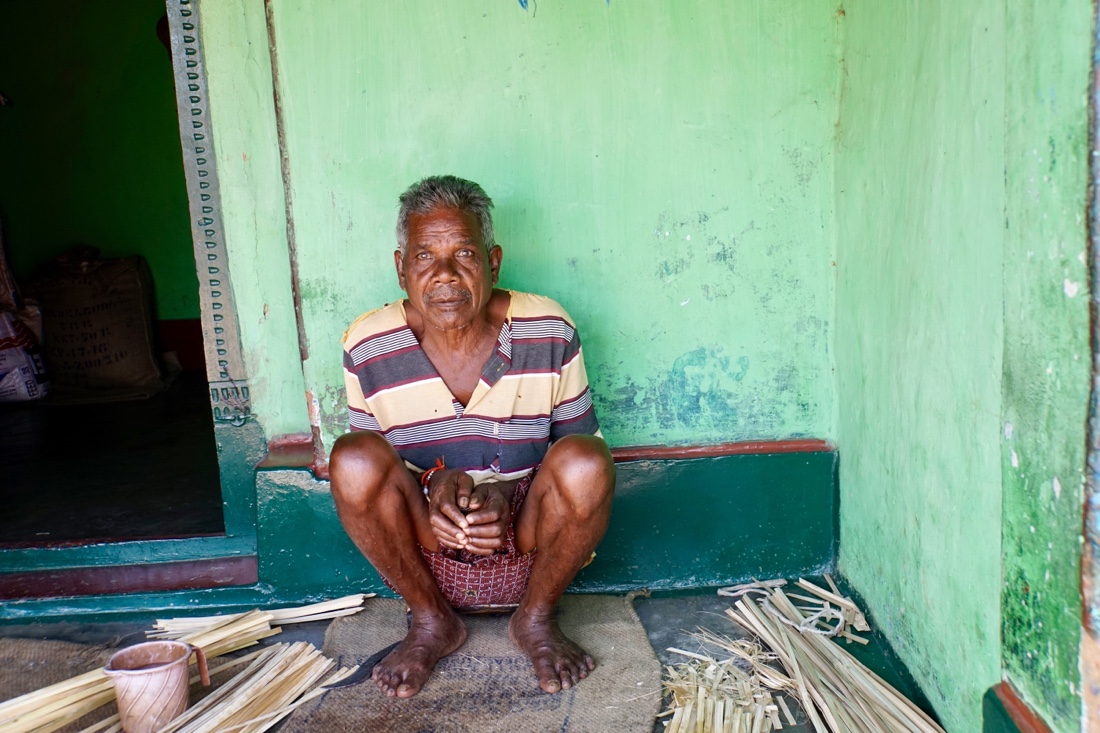 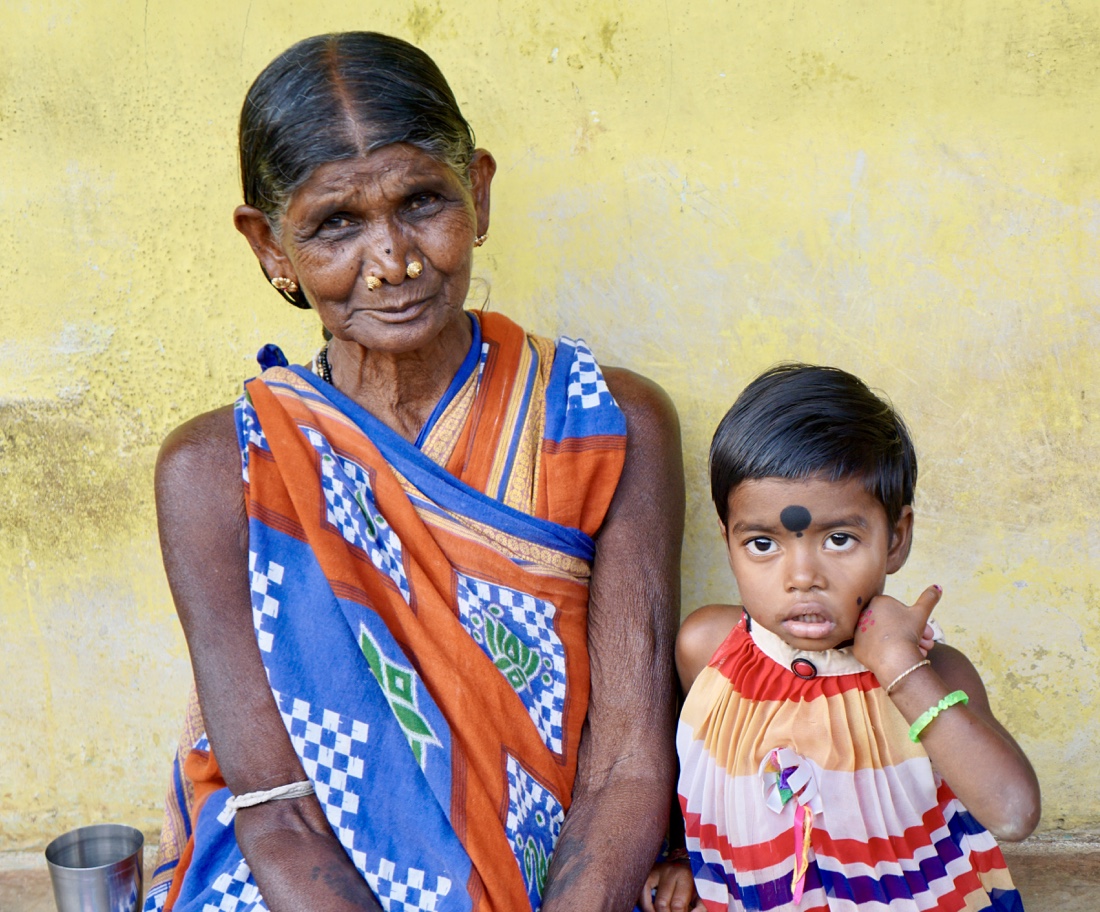 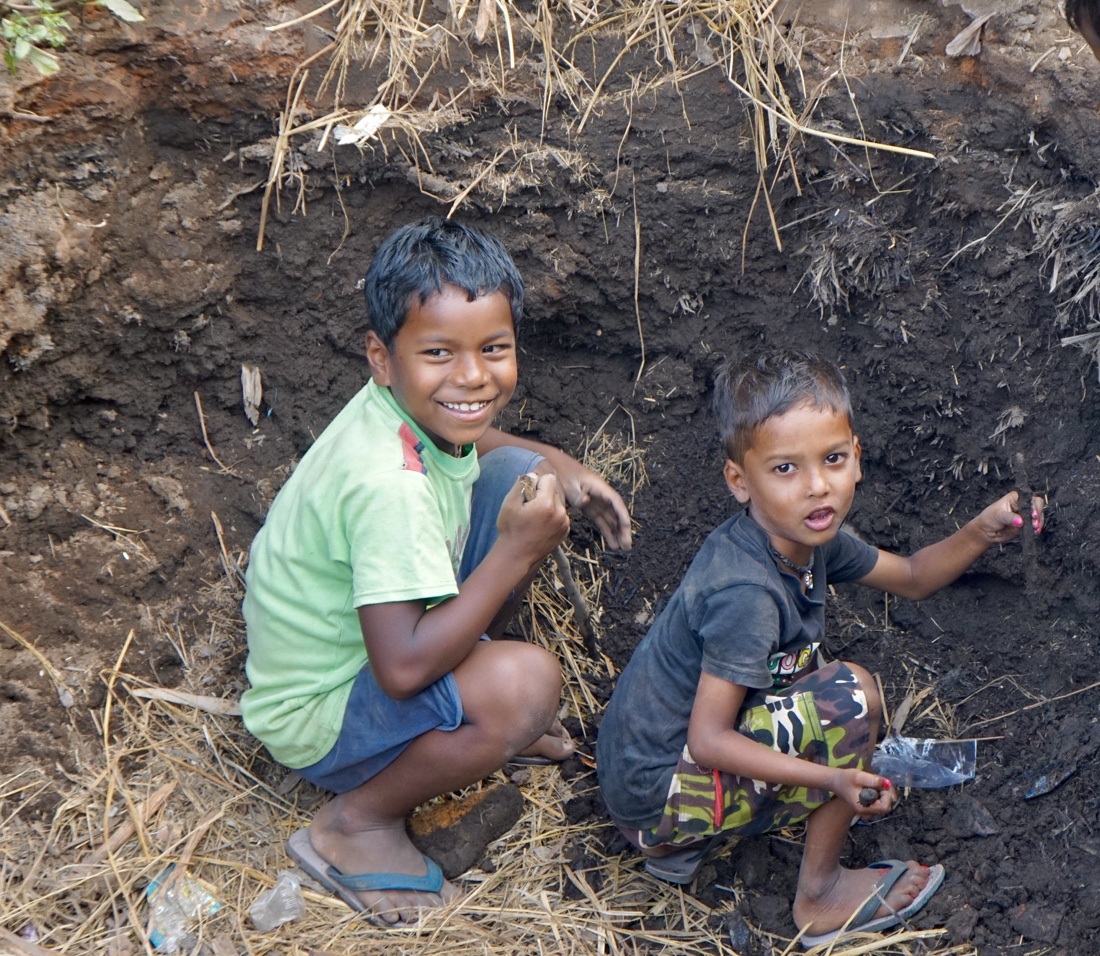 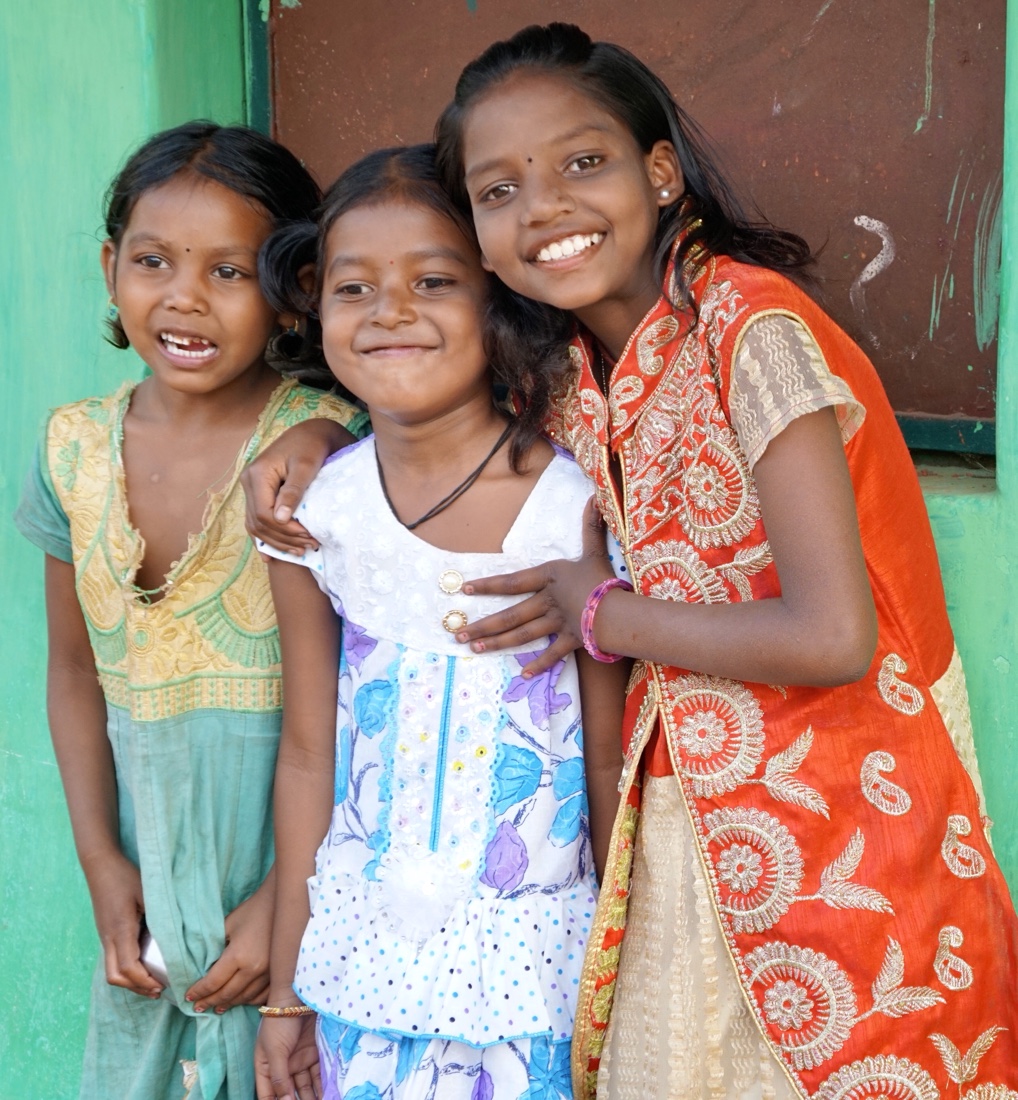 Head back to the hotel for a light lunch on the patio outside my room at 1PM. Relax and blog until 3:30, when Prasant comes by, and we walk to a nearby pottery village. It’s very cool that our hotel is essentially part of the village. Head back to the hotel for a light lunch on the patio outside my room at 1PM. Relax and blog until 3:30, when Prasant comes by, and we walk to a nearby pottery village. It’s very cool that our hotel is essentially part of the village.
We see the place where members of the community make pottery and Padang explains the process. The government has provided pottery wheels, at which people work in the large, covered shed. The air is full of smoke, and must be a huge health hazard.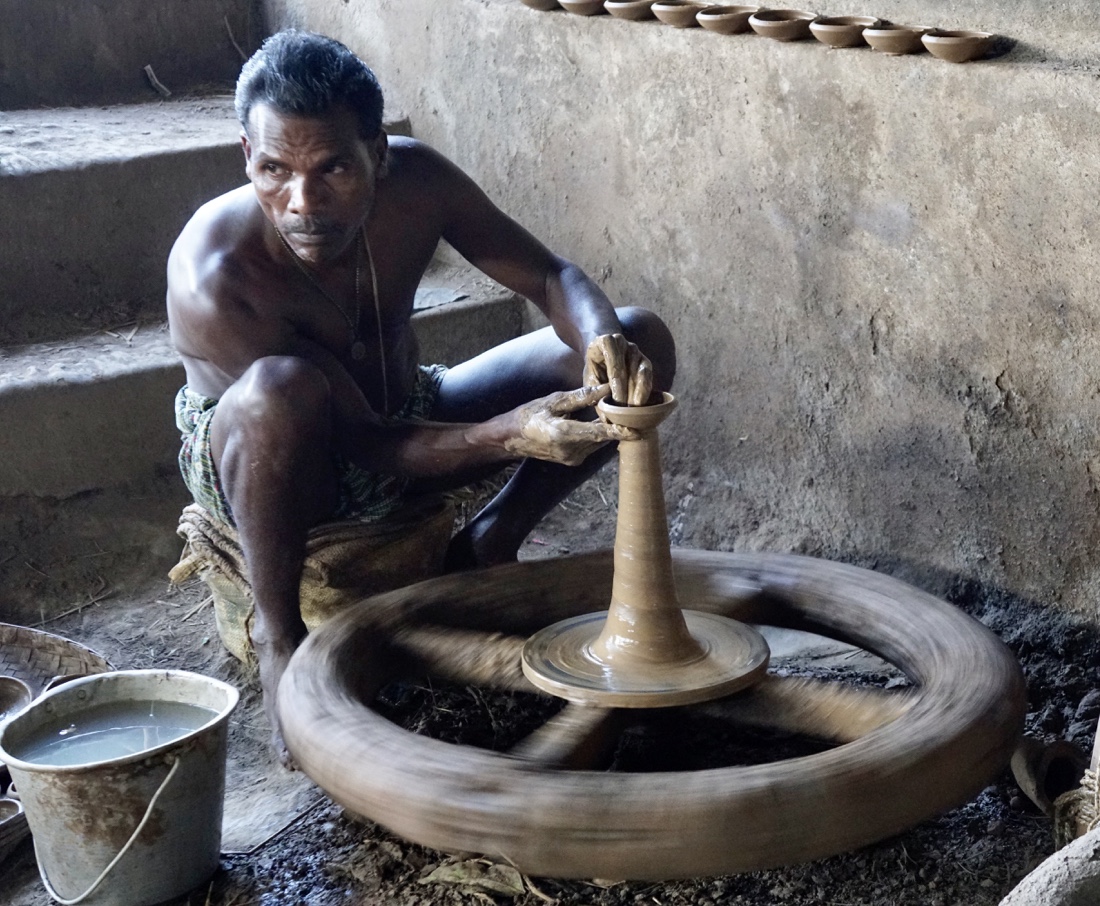 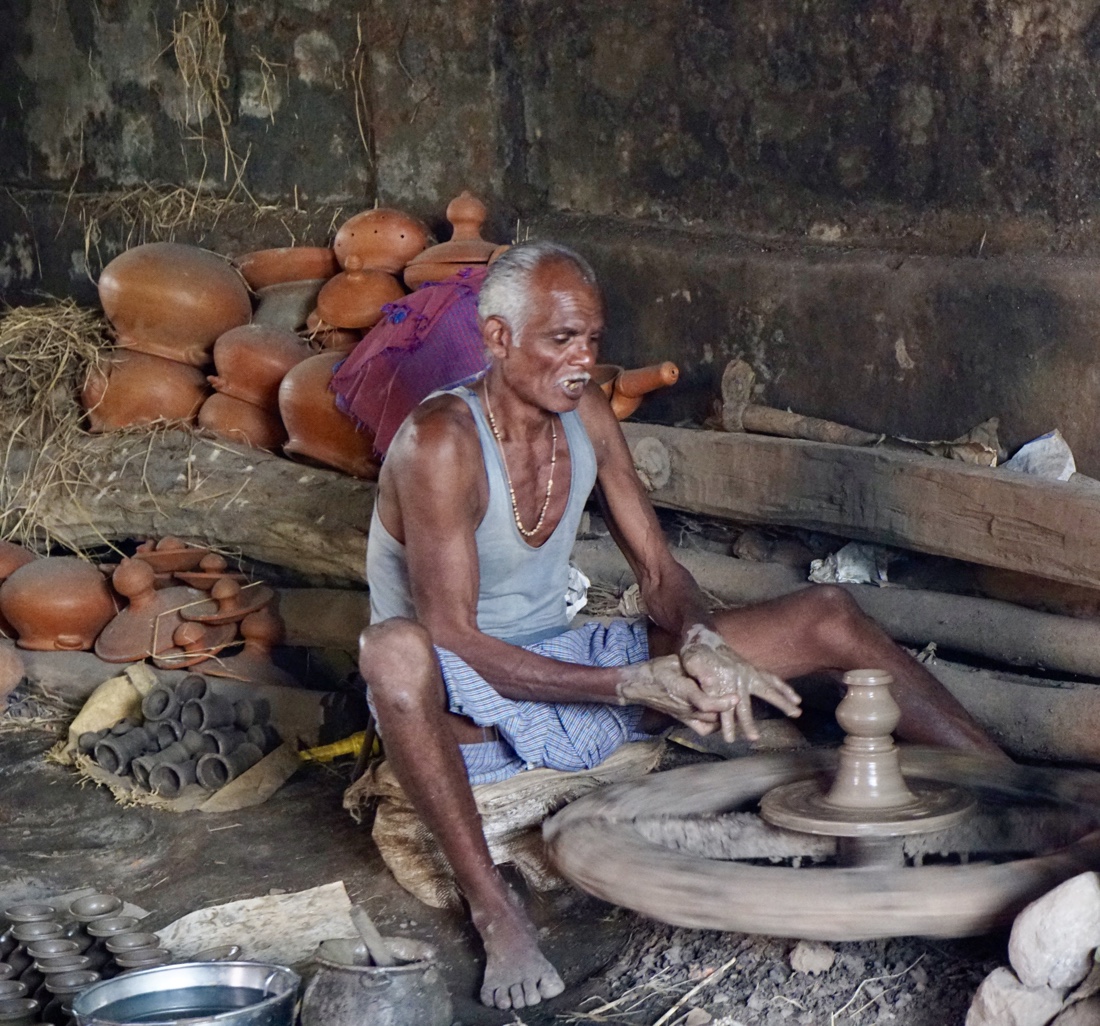
We stay in the village until the cows come home from their day in the jungle,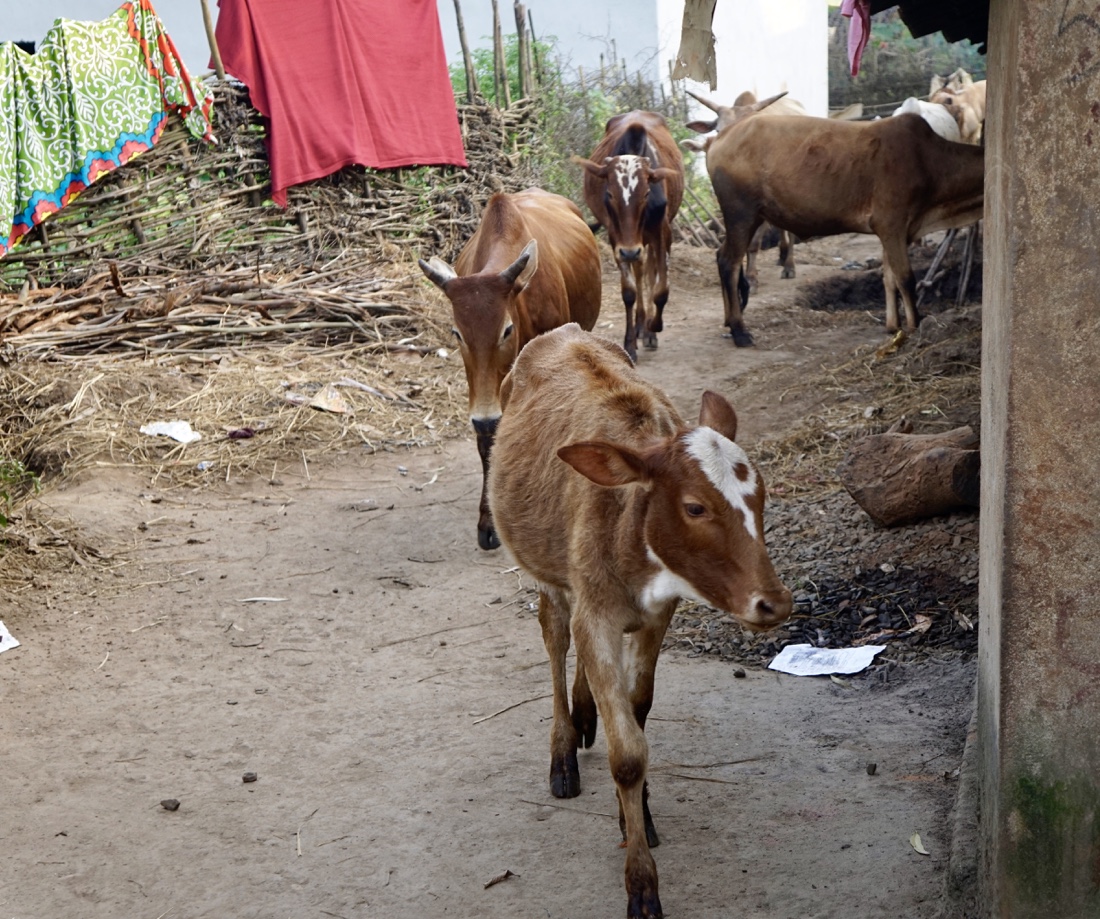 then I walk the short distance back to the hotel and rest, blog and shower before dinner with the French group. My would-be roommates from Spain join us, but since we’re at different tables I have only a brief opportunity to exchange a few words with them, utilizing my high school Spanish, as revived by a number of trips to Spanish-speaking countries. then I walk the short distance back to the hotel and rest, blog and shower before dinner with the French group. My would-be roommates from Spain join us, but since we’re at different tables I have only a brief opportunity to exchange a few words with them, utilizing my high school Spanish, as revived by a number of trips to Spanish-speaking countries.
October 22.
Leon, the Australian owner of the place I’m staying at brings breakfast down to the cottage. He knows that I’m not happy with the room arrangements and is trying his best to make up for it. Much more on that, later.
After breakfast, Prashant and I walk few steps to see a village getting started on day. Cow dung with water, thought to be suspicious, is spread evenly in front of houses to clean. (it’s ironic that the houses, both interior and exterior are kept so clean, while streets and public areas are laden with trash).Mandalas are drawn on the area right outside houses to welcome the goddess. Cows and people mingle. A government pump house provides water for one hour in the morning and one in the evening. Some people are using free gas provided by the government for their stoves.
Two boys, rotating each day, walk cows and goats up to the jungle to eat. On the way back, cows know their houses and peel off, so there are no marking on the cows. Mixed village, some Hindus, some tribal, from many different tribes.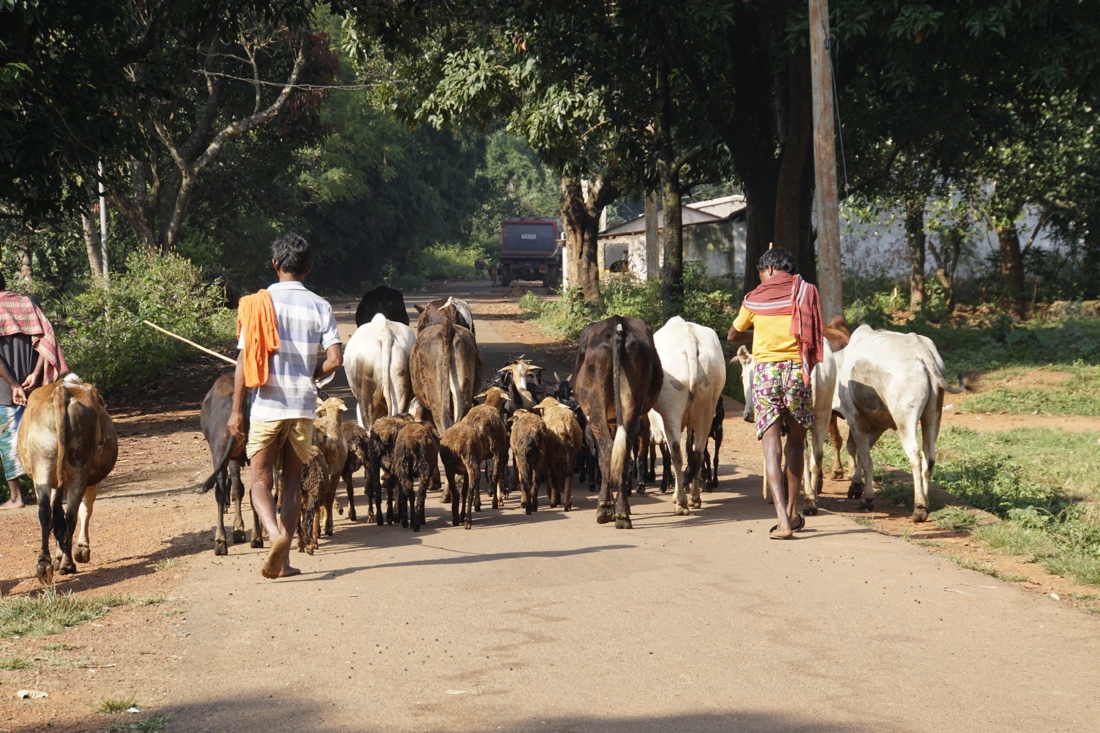
We visit a second village called Lanjiguda, inhabited primarily by the Lower paroja tribe.
Photos of people below come from both villages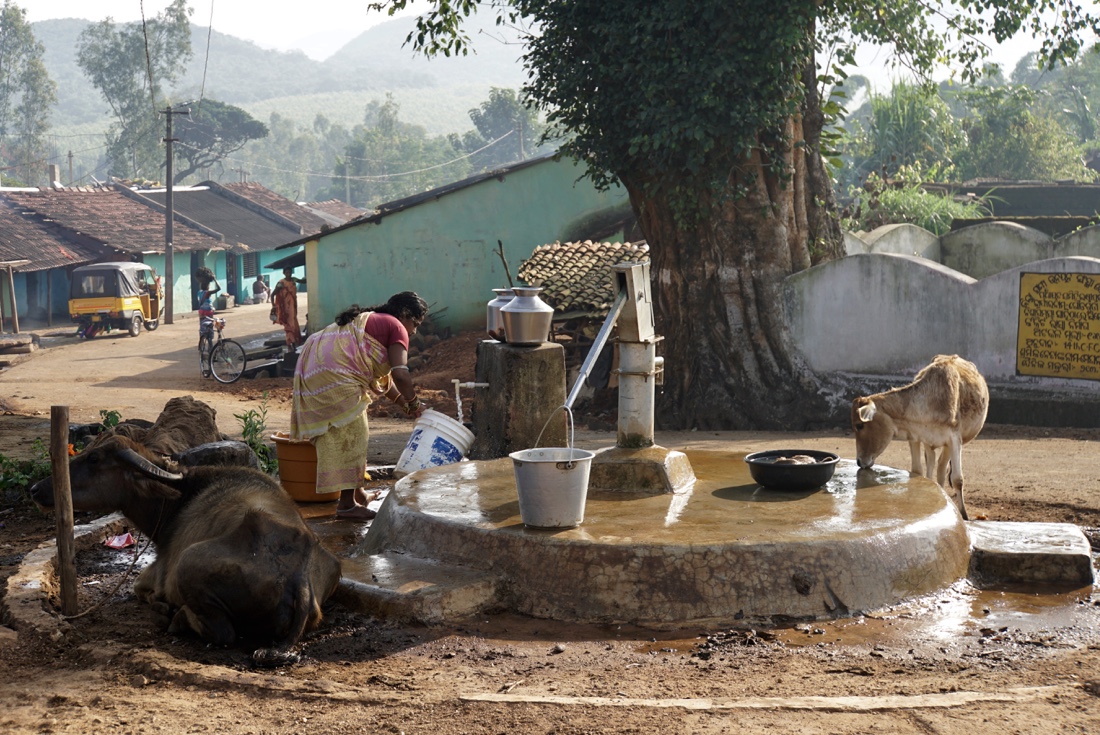 . . 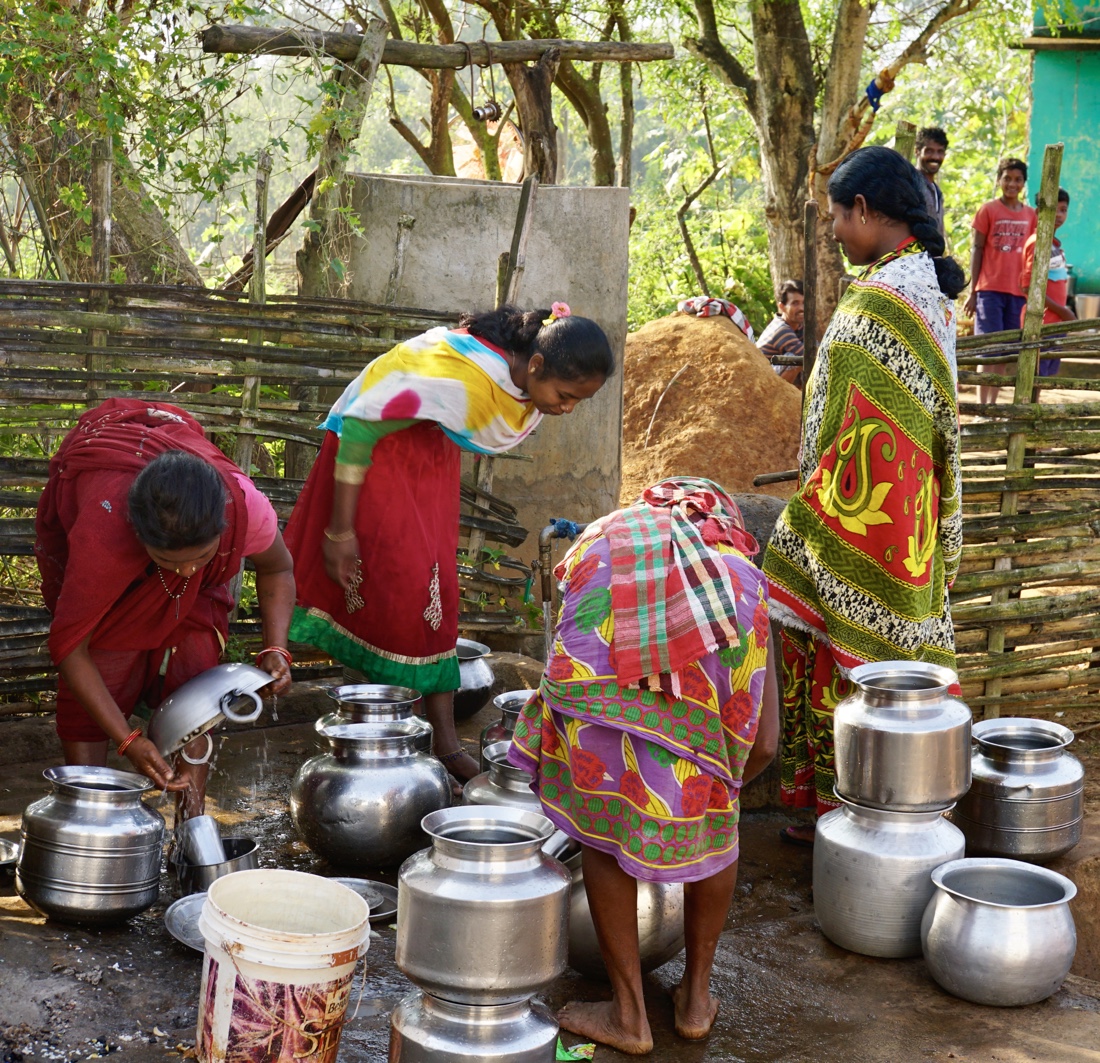 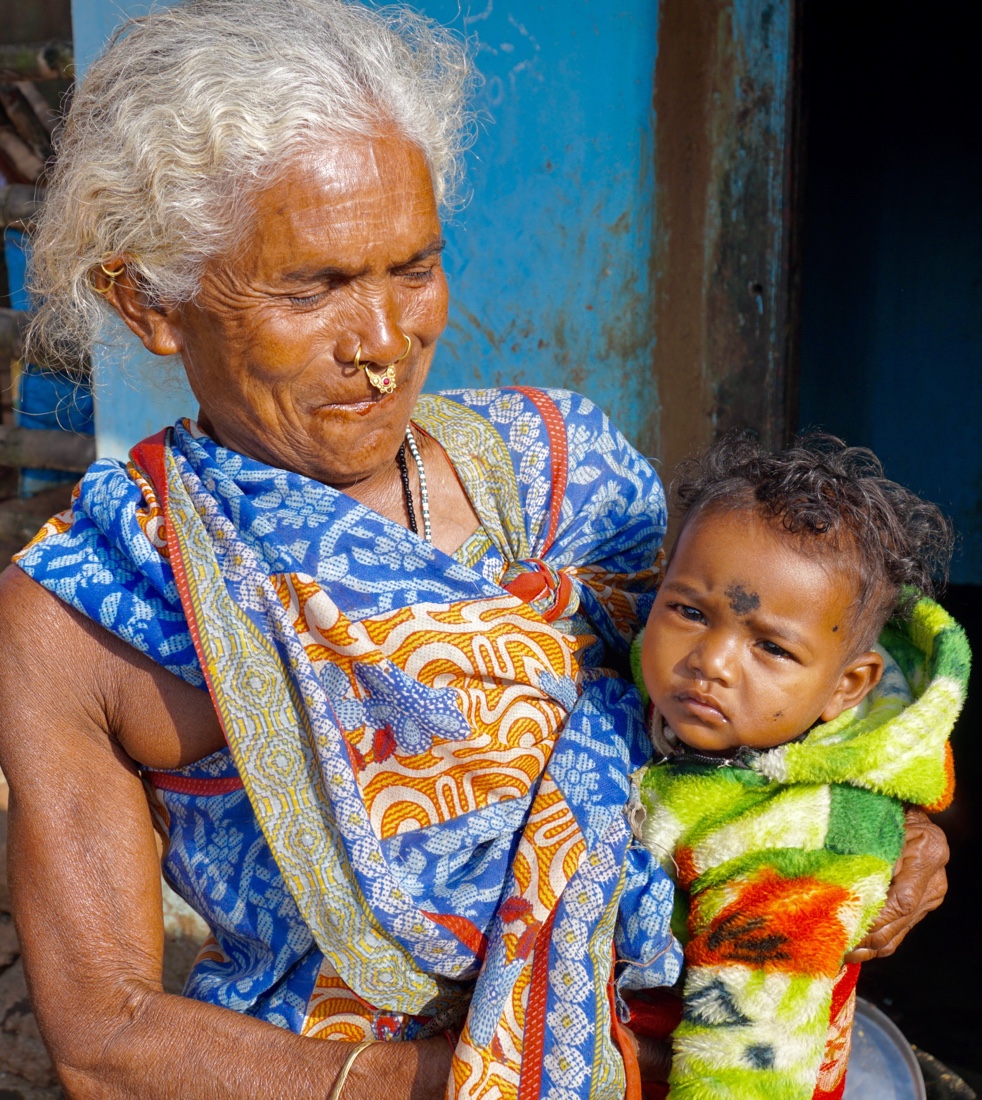
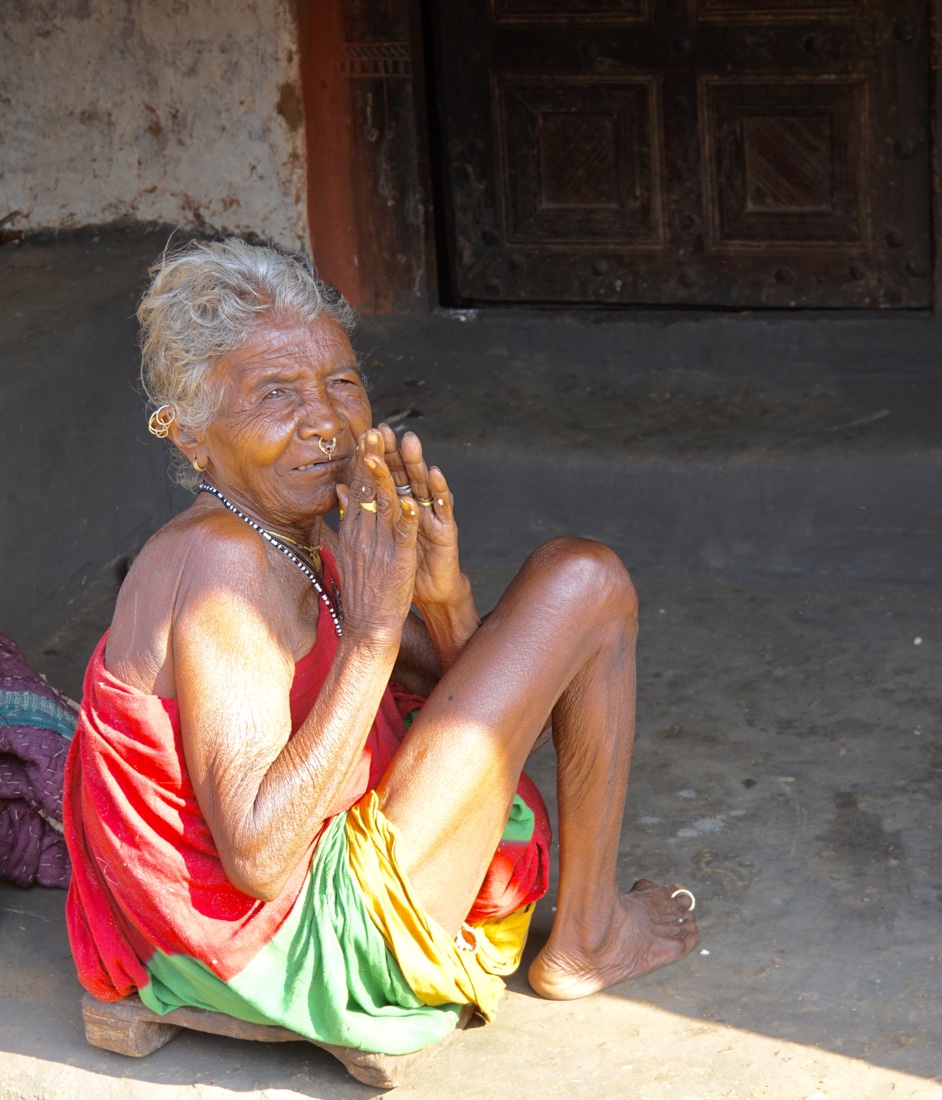 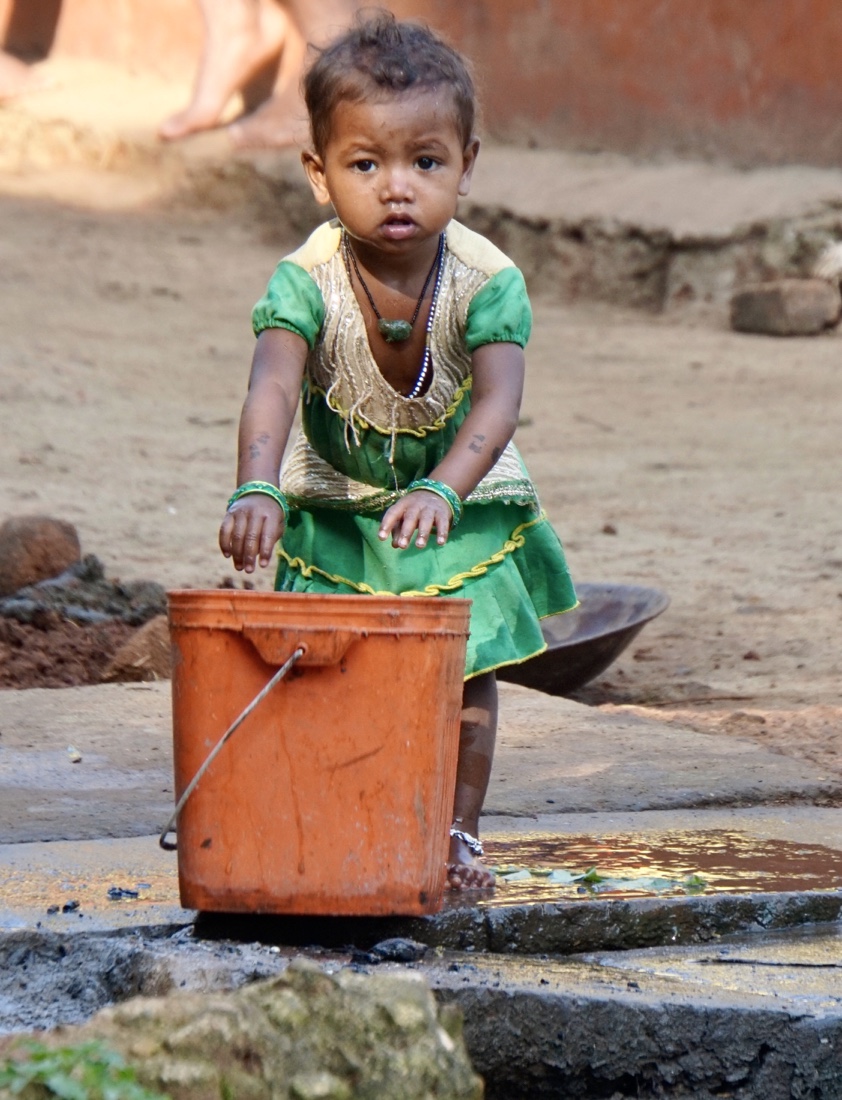 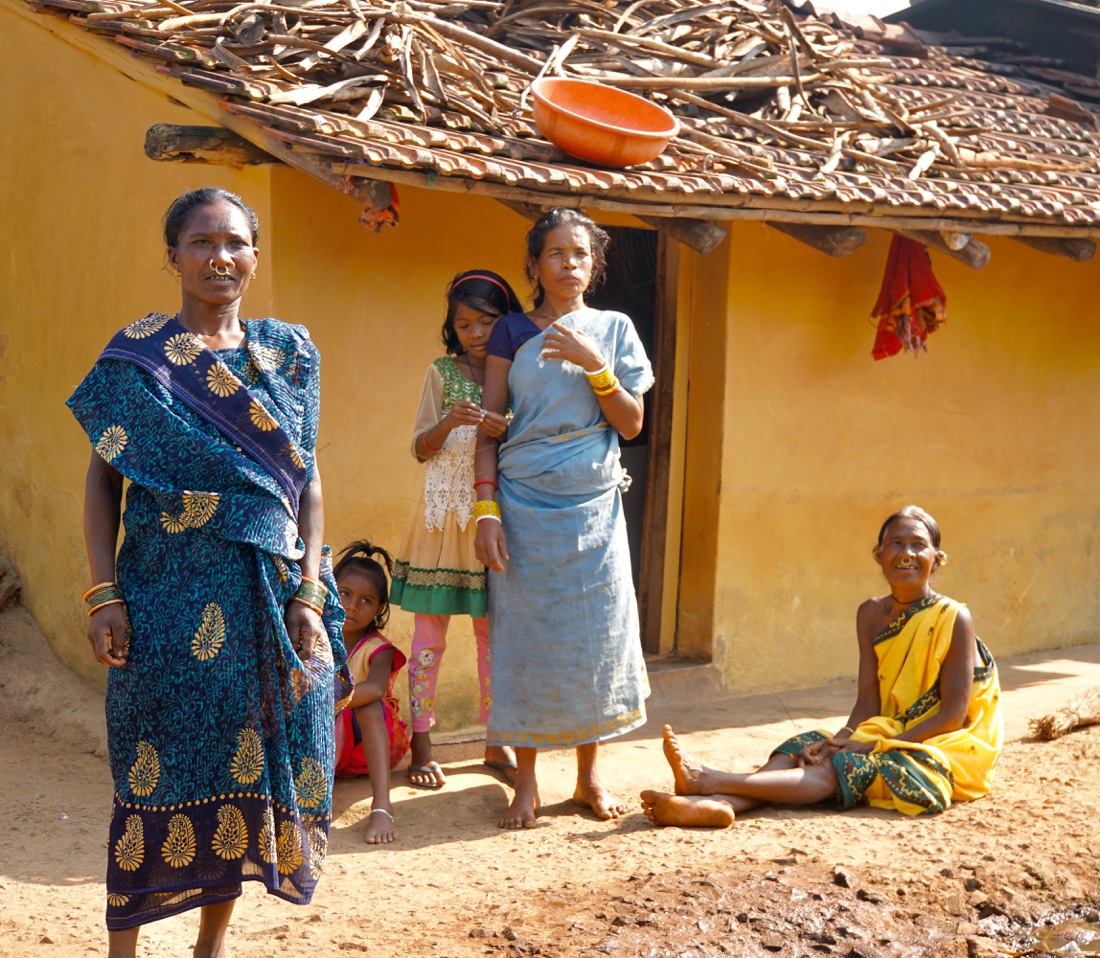 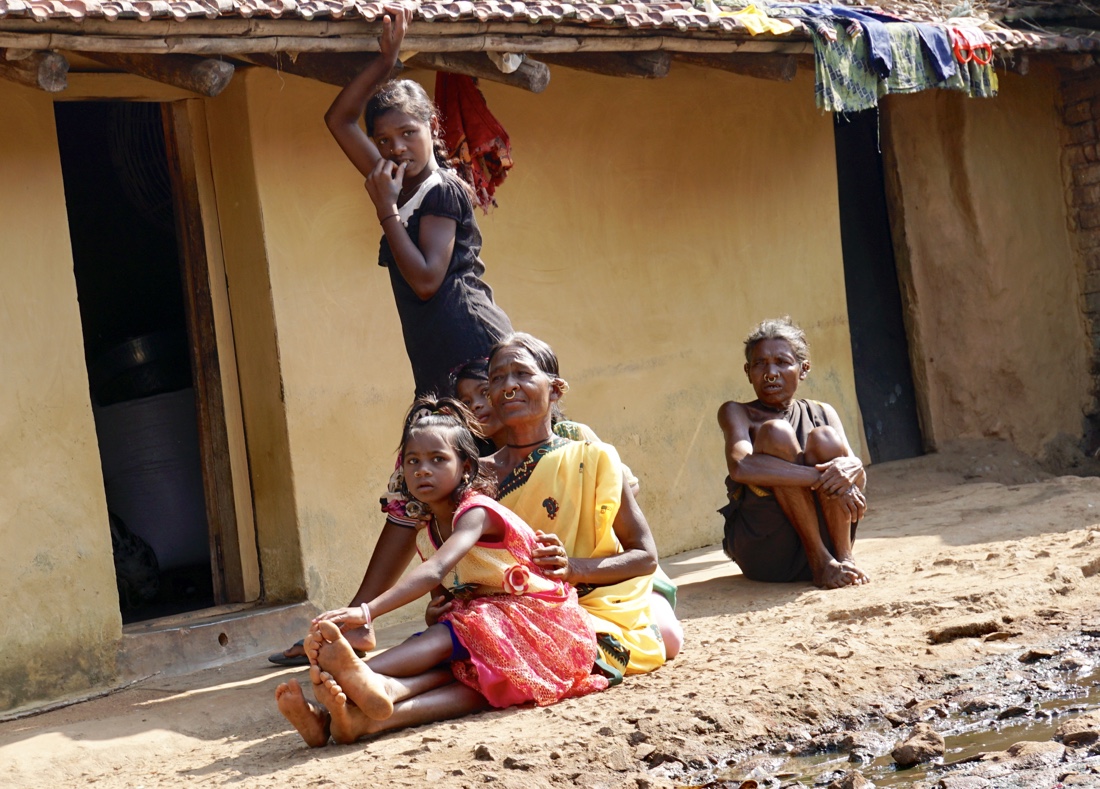 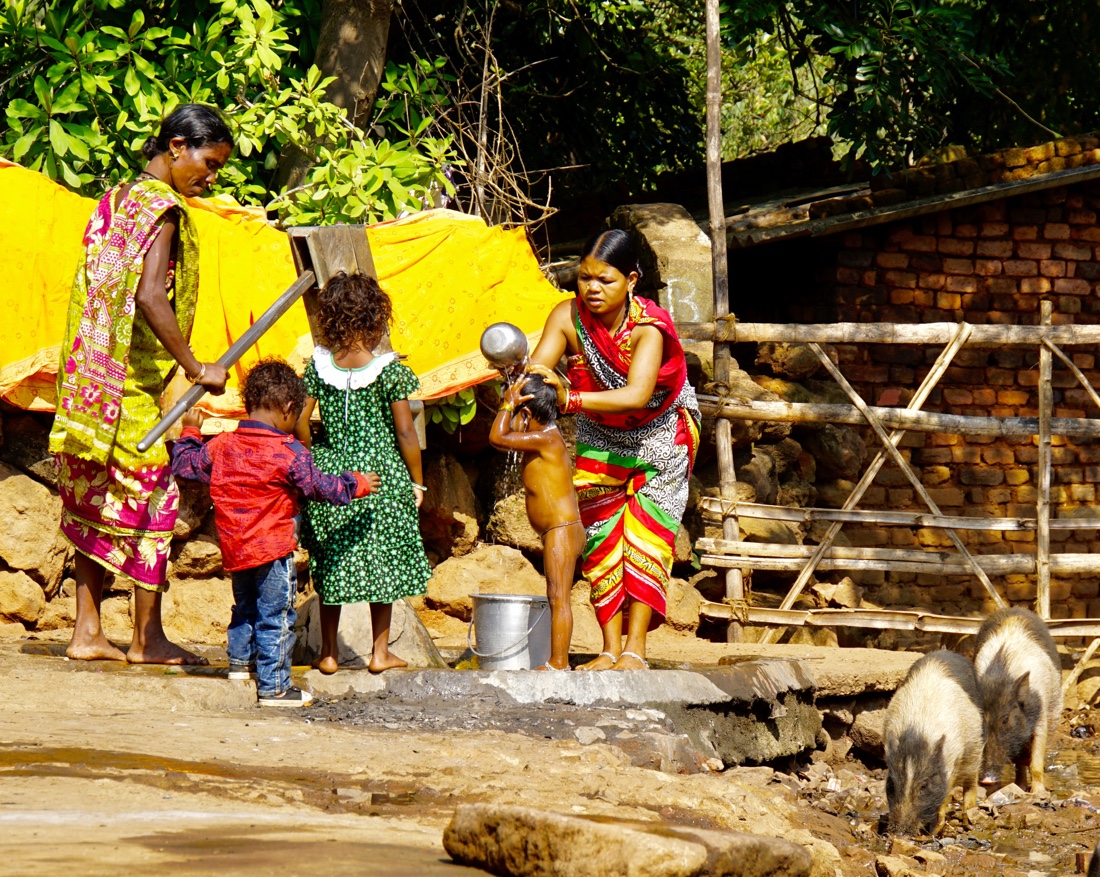 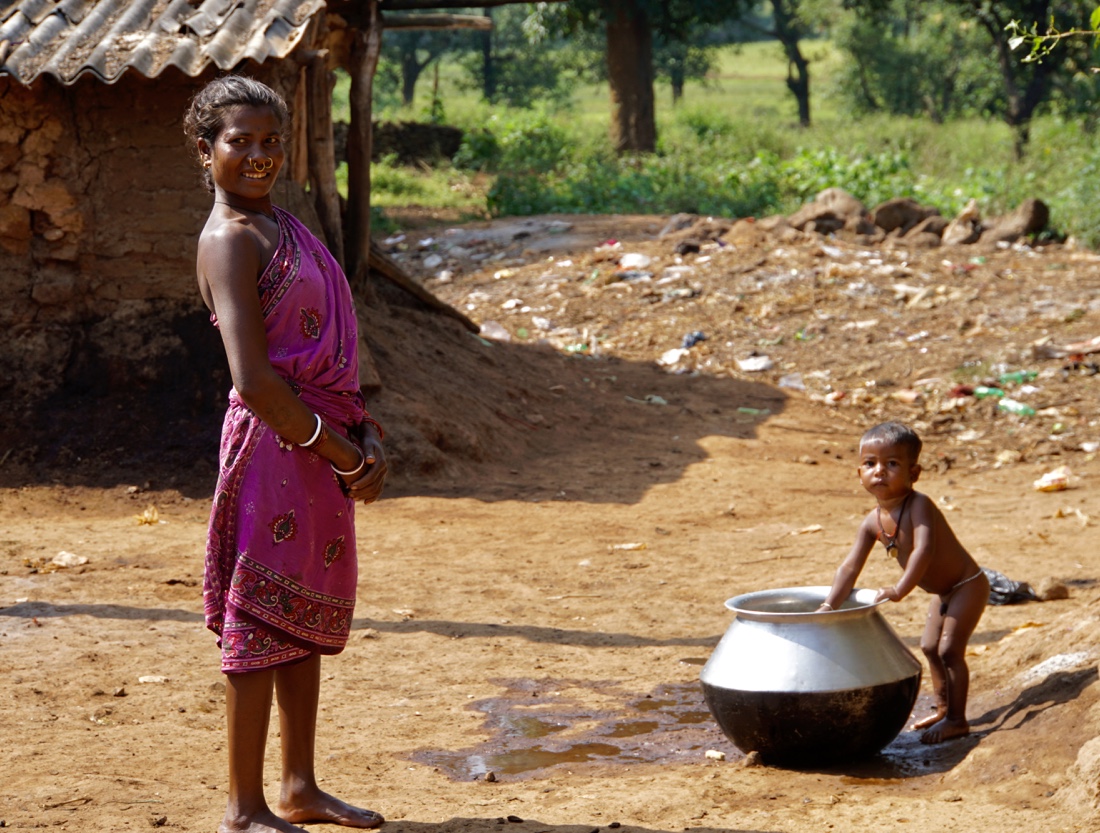 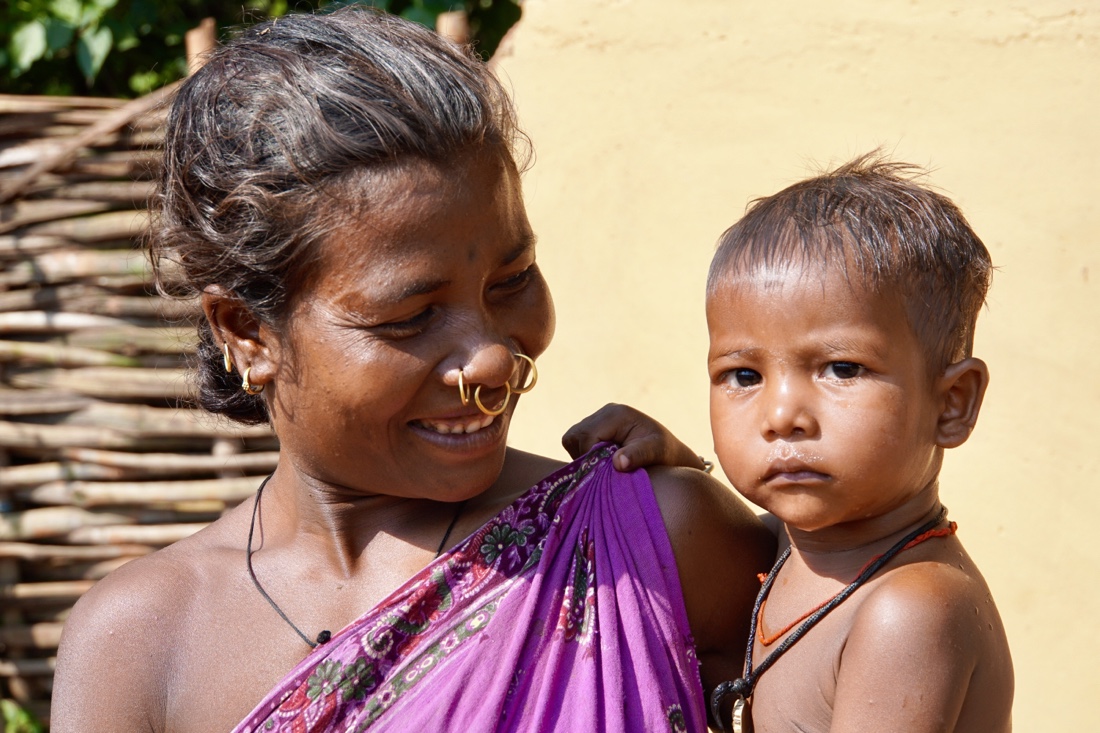  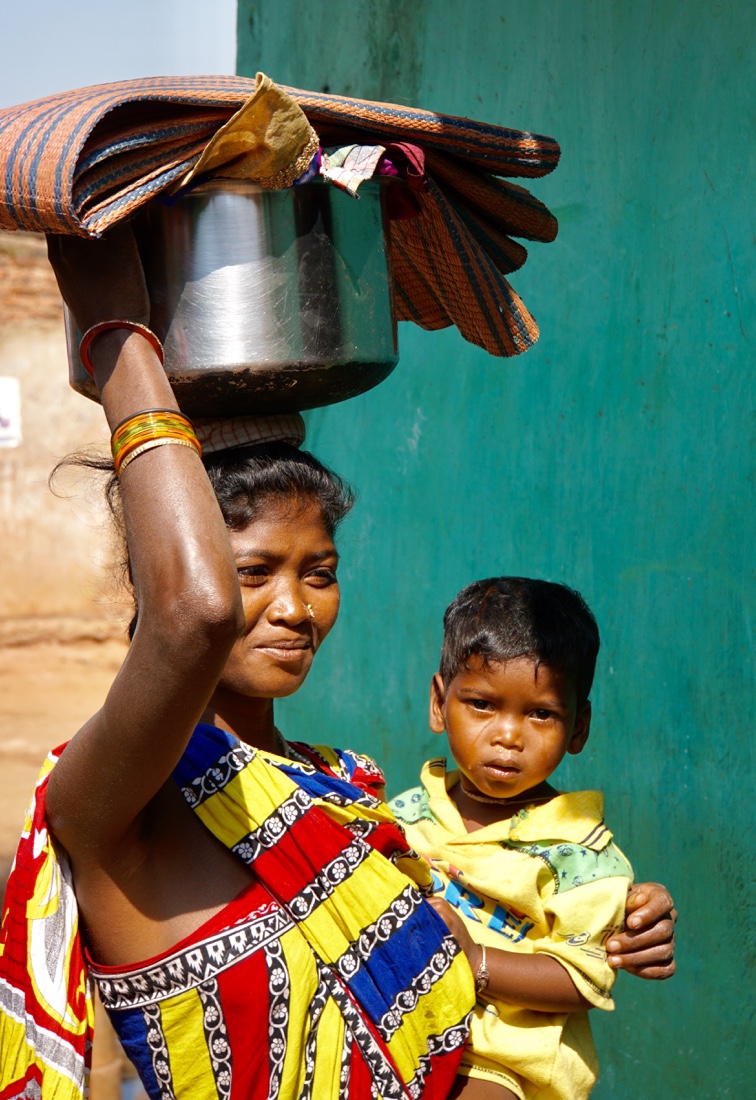 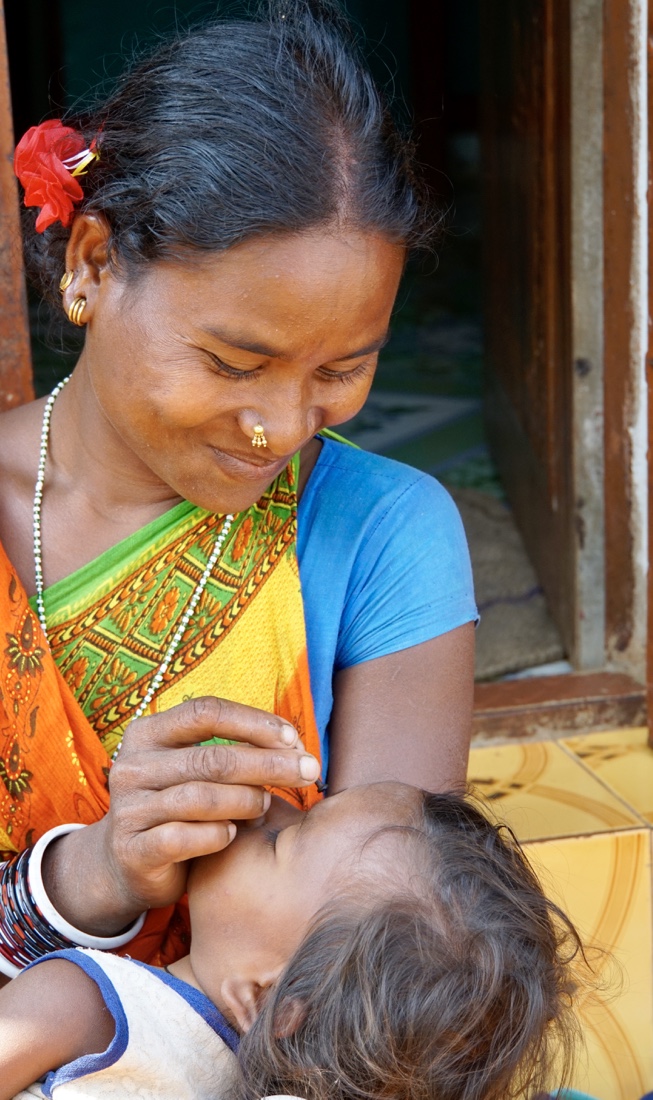 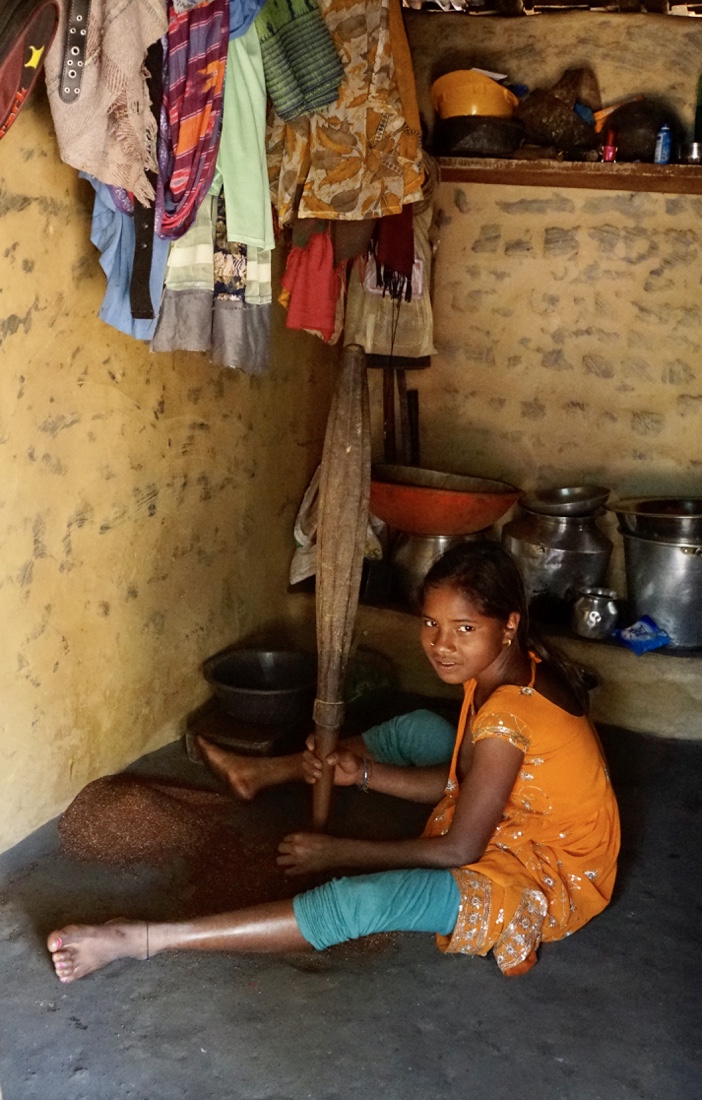 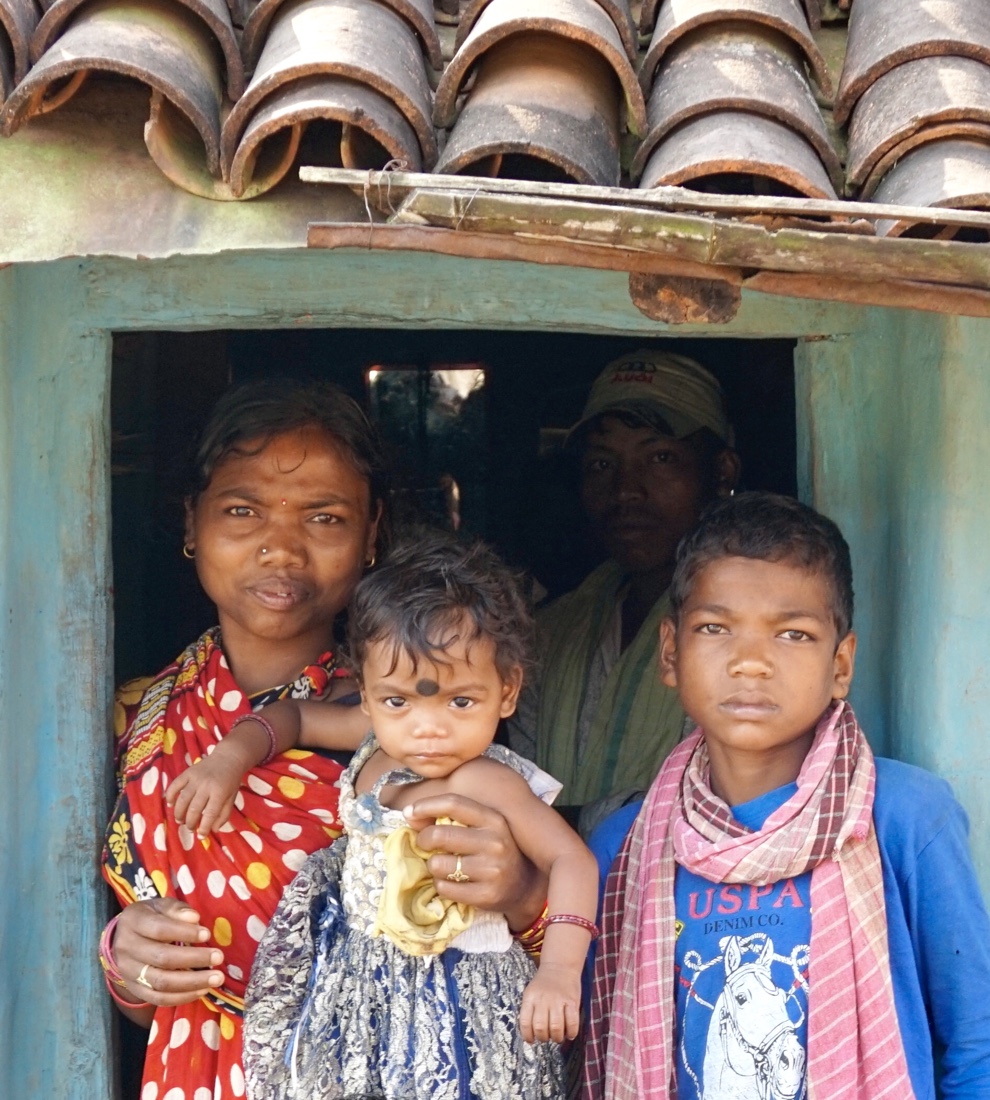
Below are a few pictures of interiors of village houses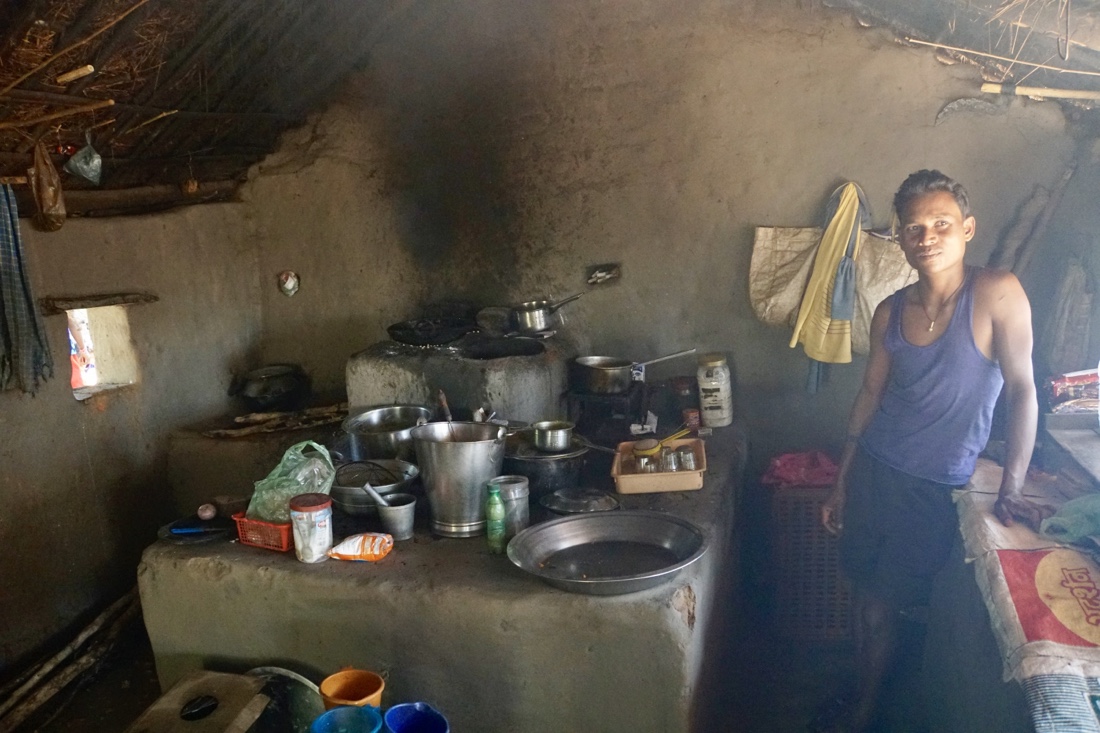 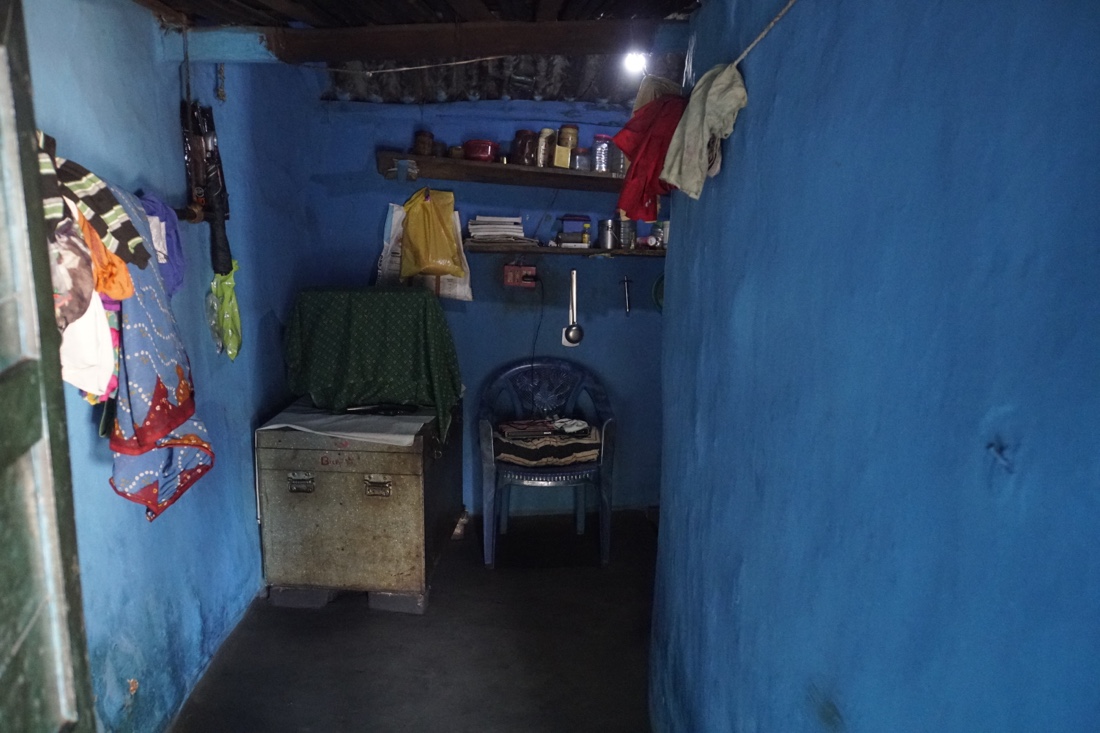
After visiting these two tribes, we drove through nice, hilly scenery, was once all forest, but tribes cut trees for firewood. The forestry department has been planting many trees. Unfortunately, the beautiful landscape is often marred by trash.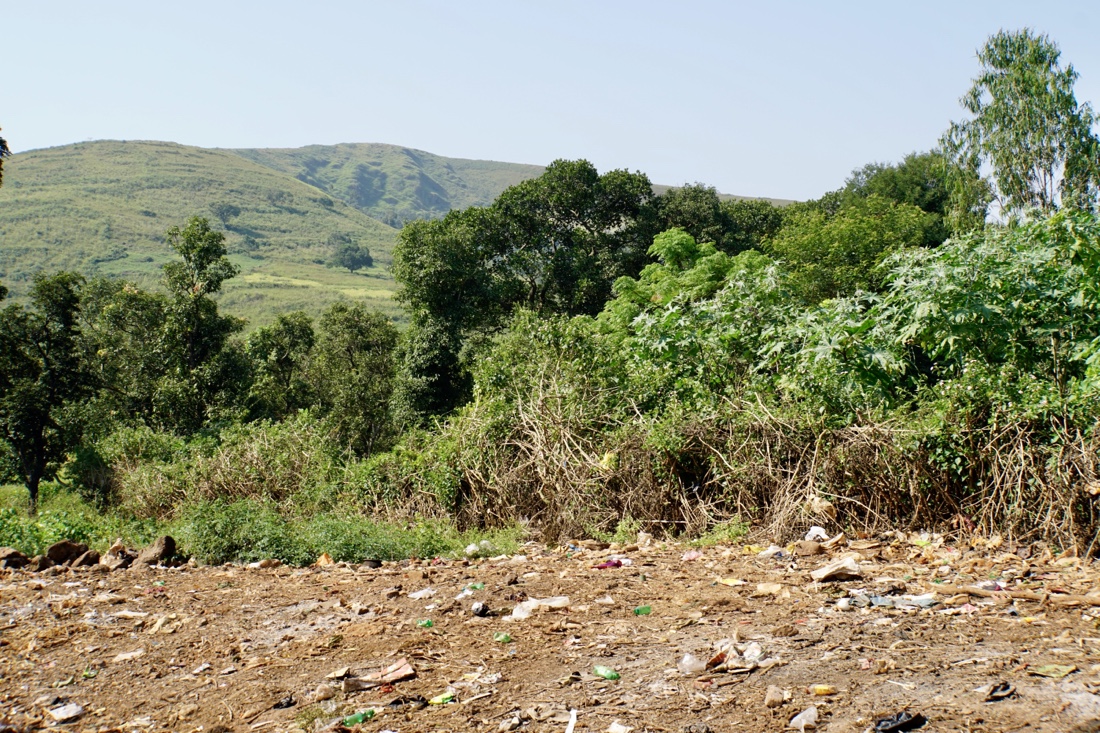 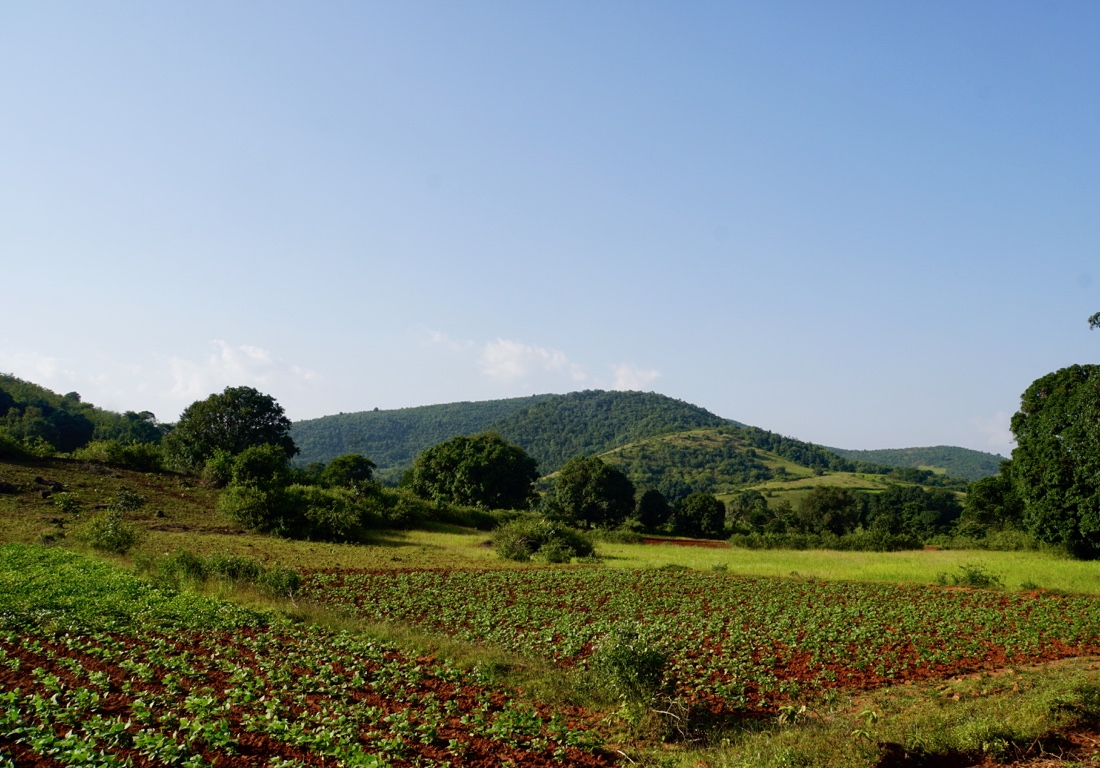
There is no road up to the hill tribes. They walk down to market once a week, which is the only place you can see them.
Our destination is the Kakiriguma Monday weekly tribal market of the Desia Kondh tribes with participation by the local community. The Kondhas are one of the well-known tribes of Orissa who were famous in history for their Meriah –Human Sacrifice. They are found almost in all the districts of Orissa but mostly concentrated in large numbers in Phulbani, Koraput and Ganjam districts.. We walked around the market and Prashant pointed out different tribes, which he could discern from the jewelry and clothing they were wearing. The number of different tribes, and variations on those tribes, is daunting.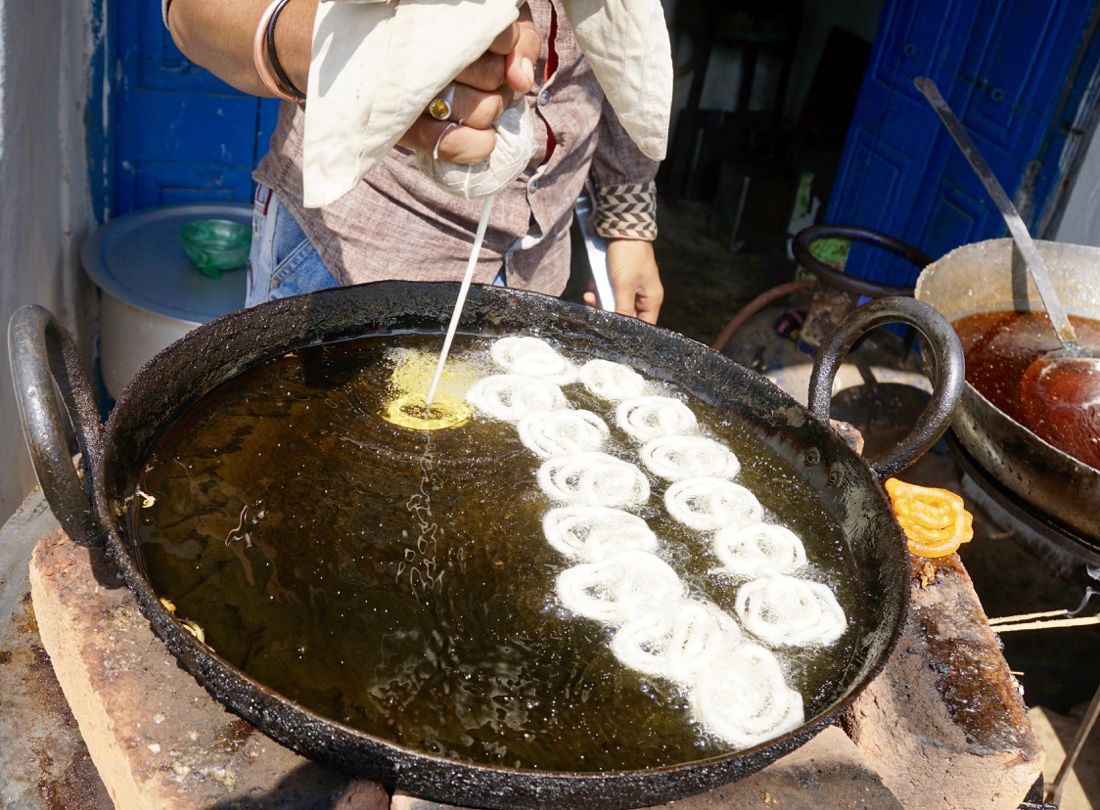 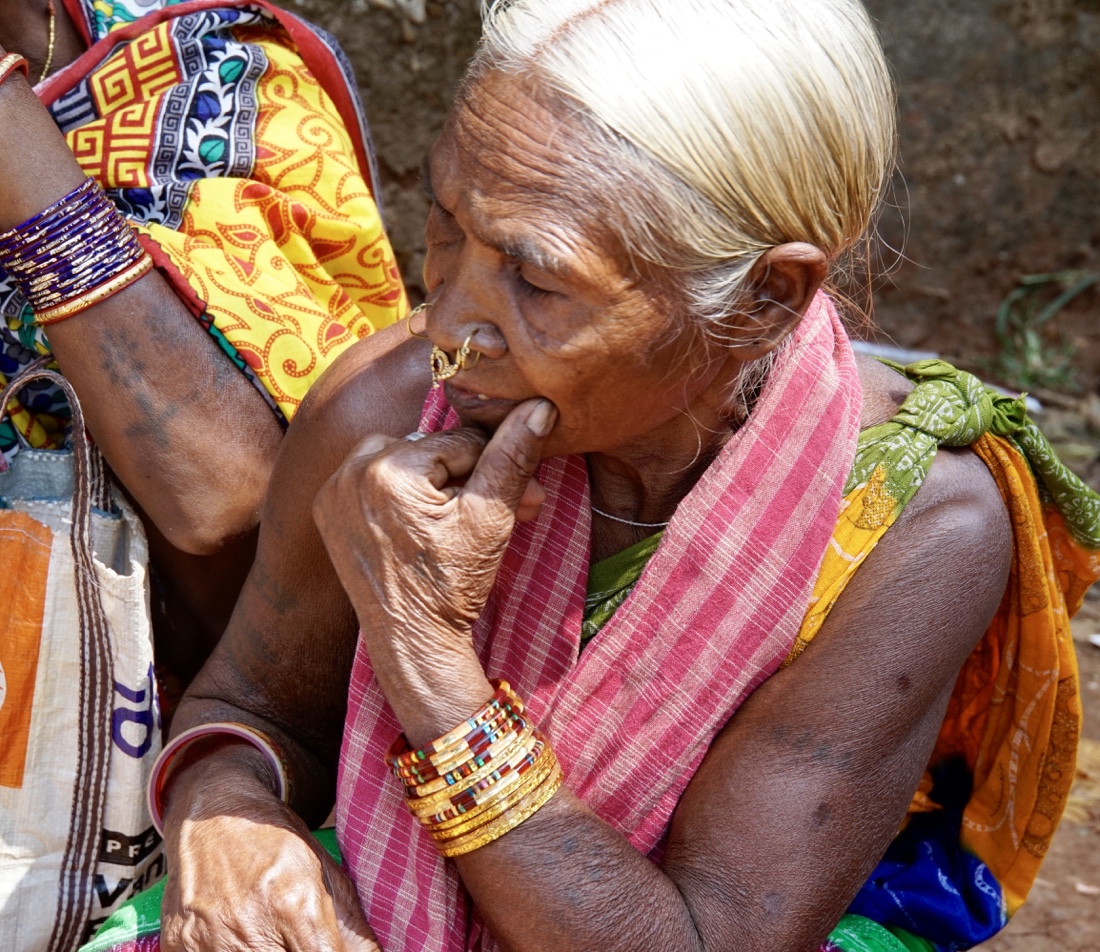 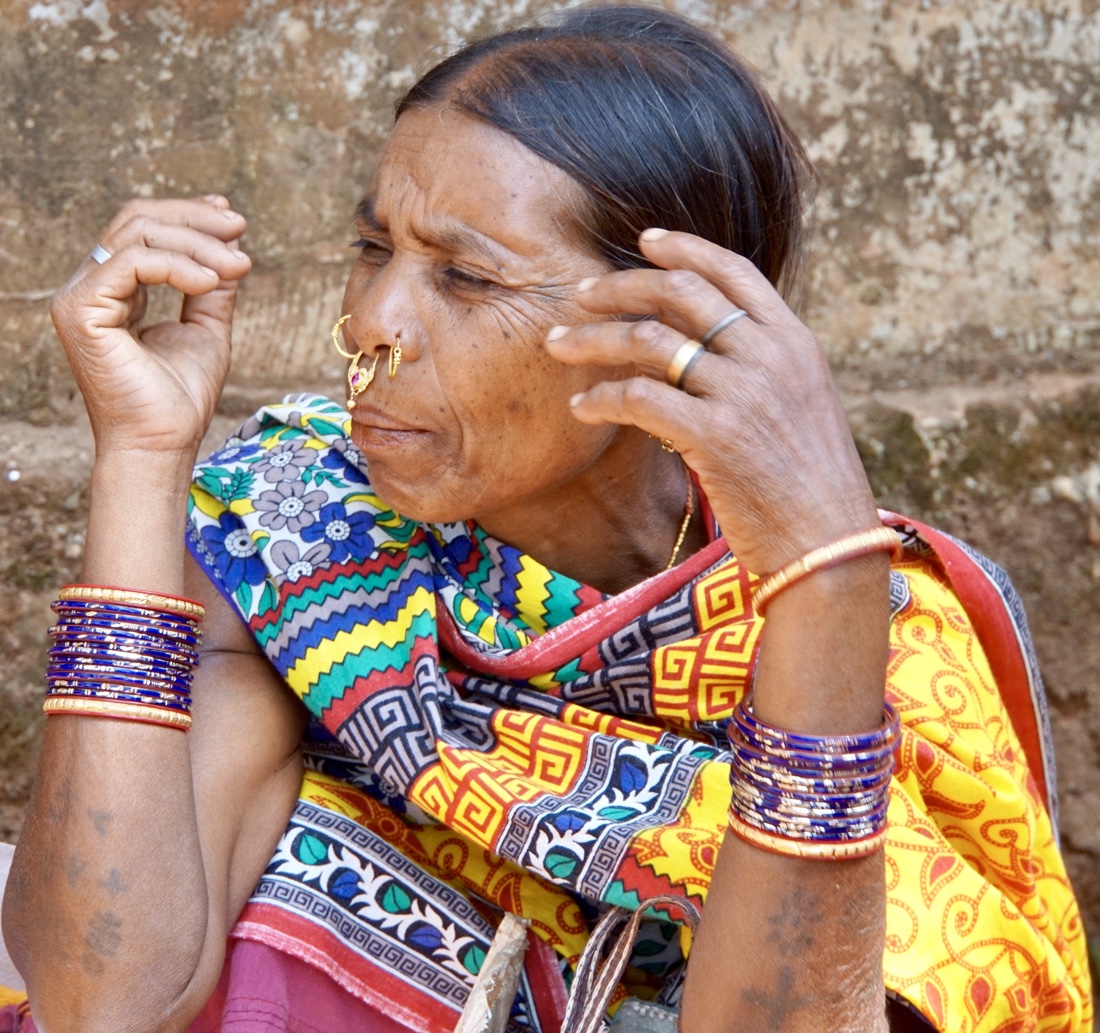 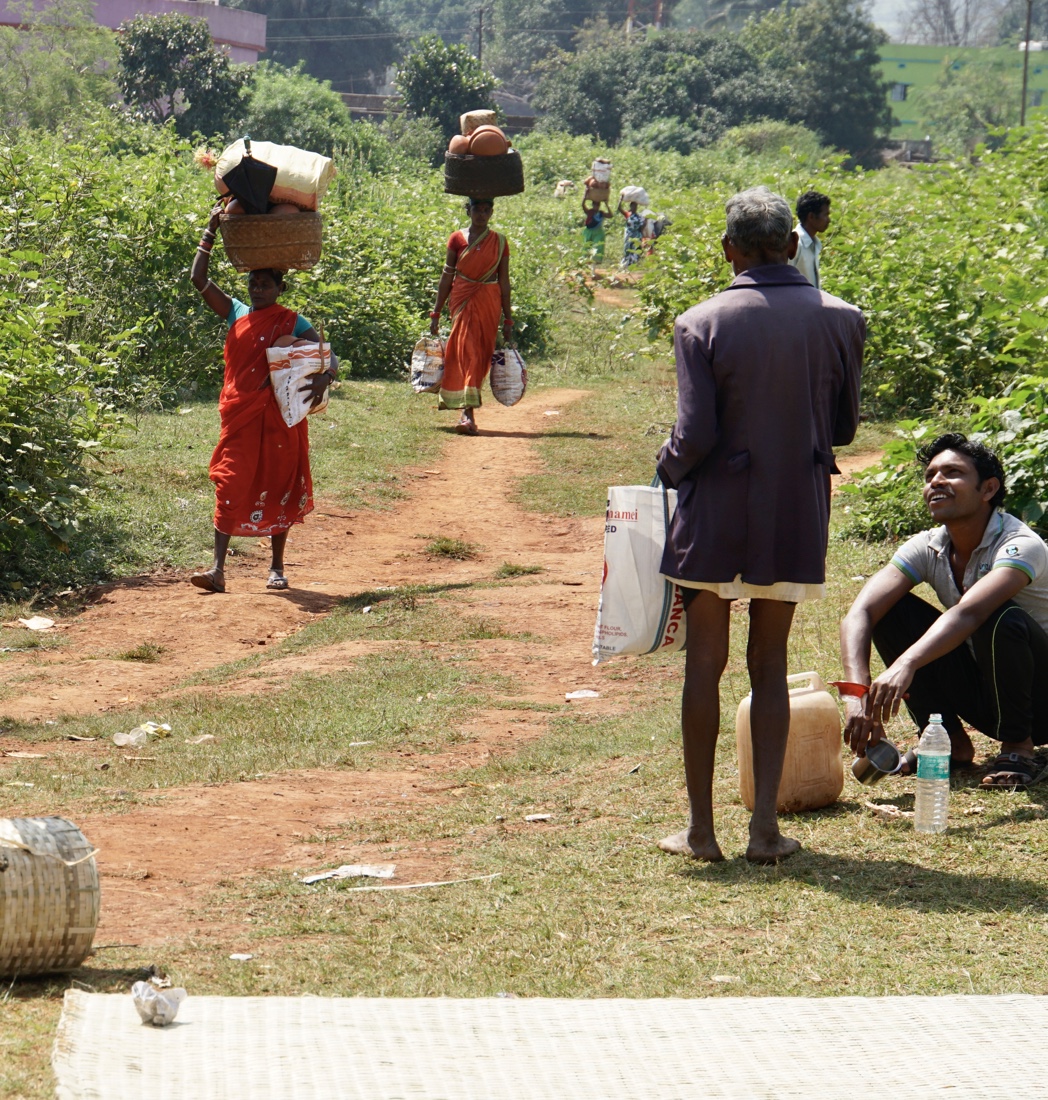 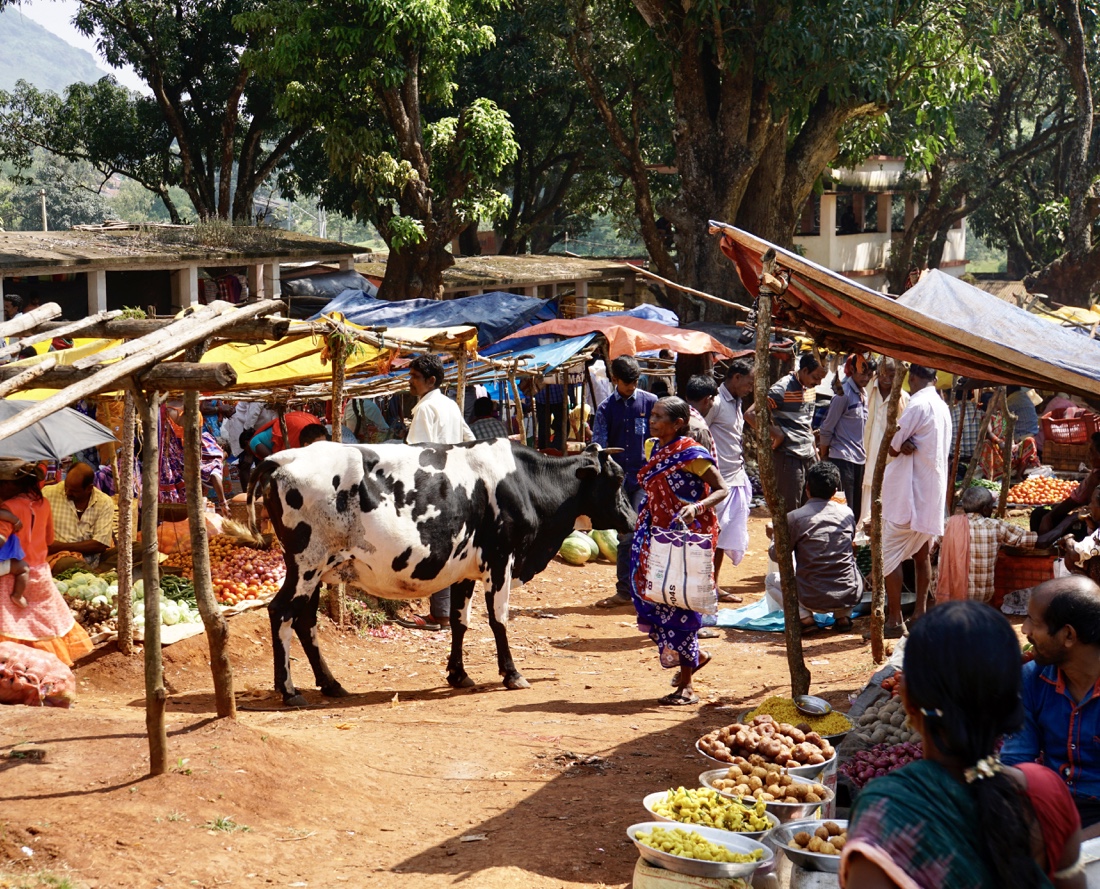 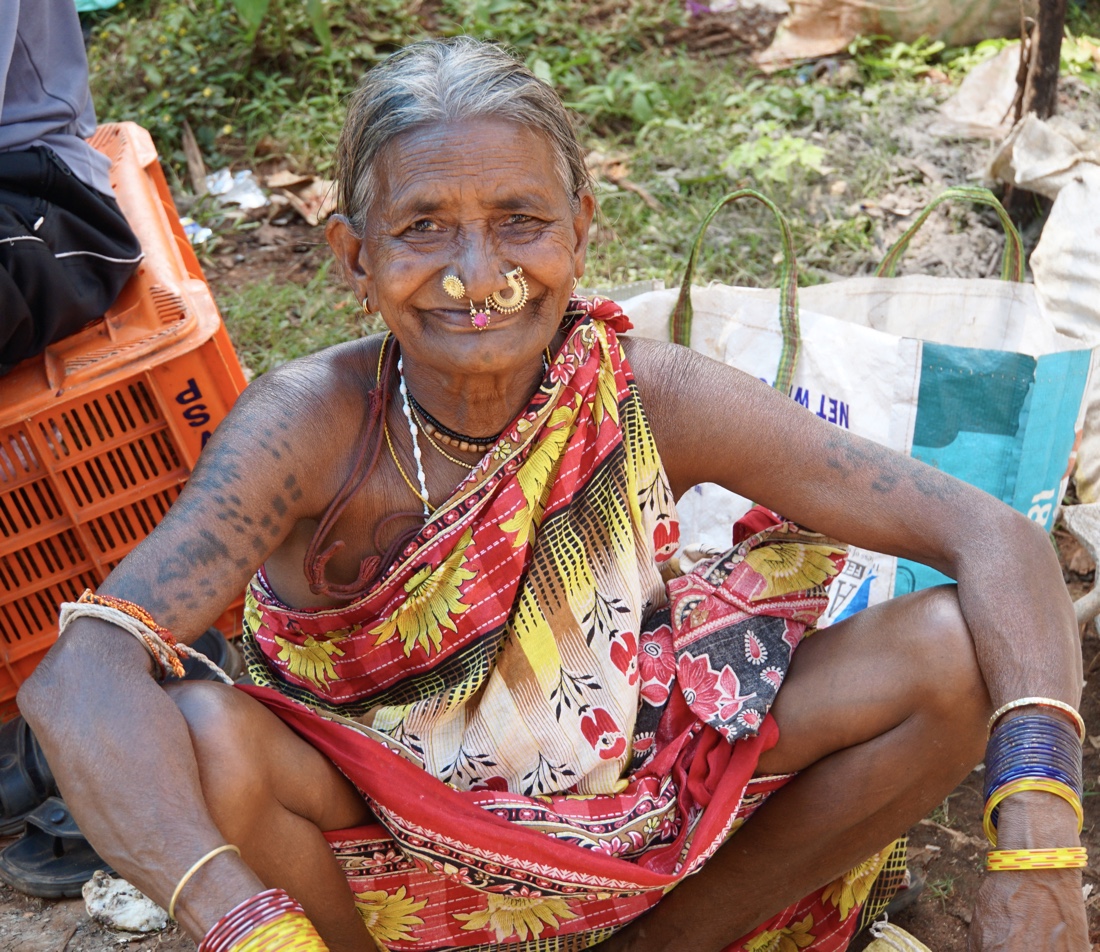 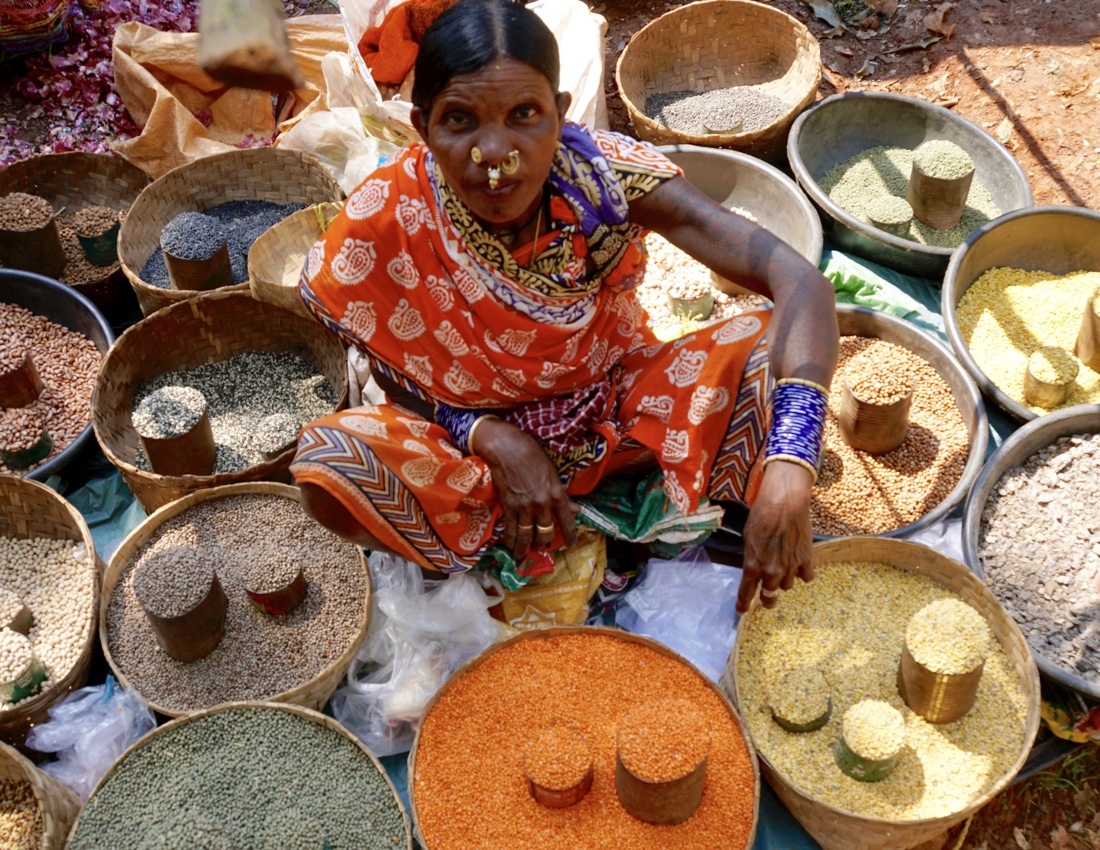 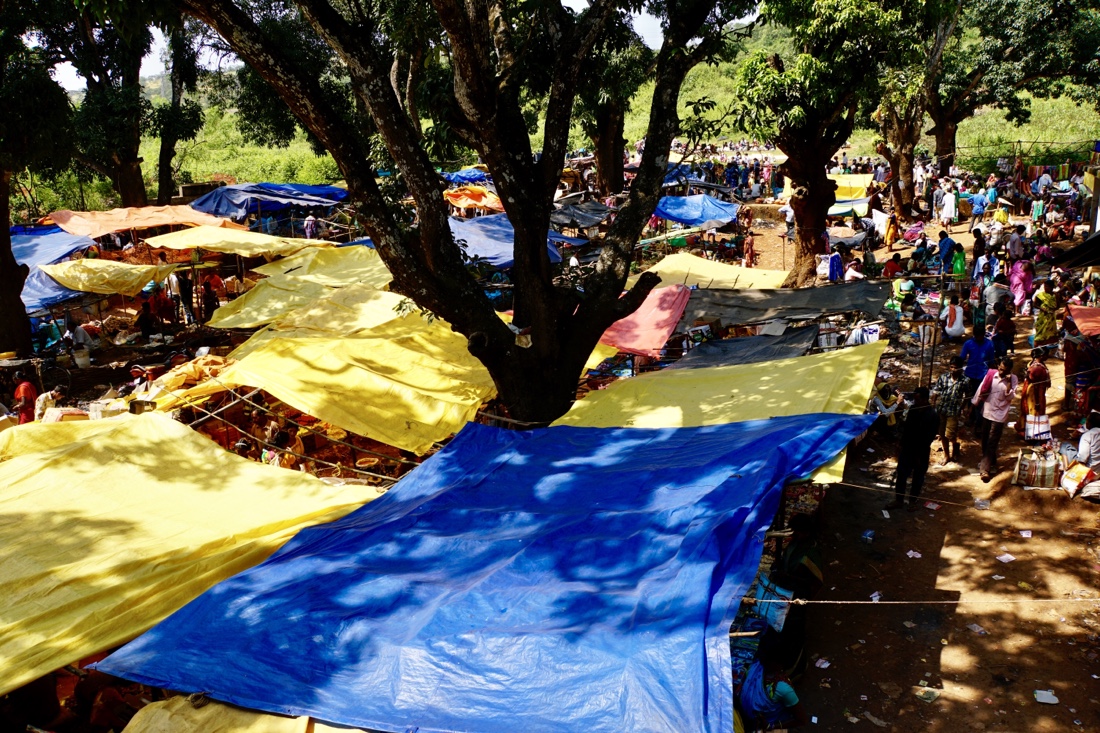 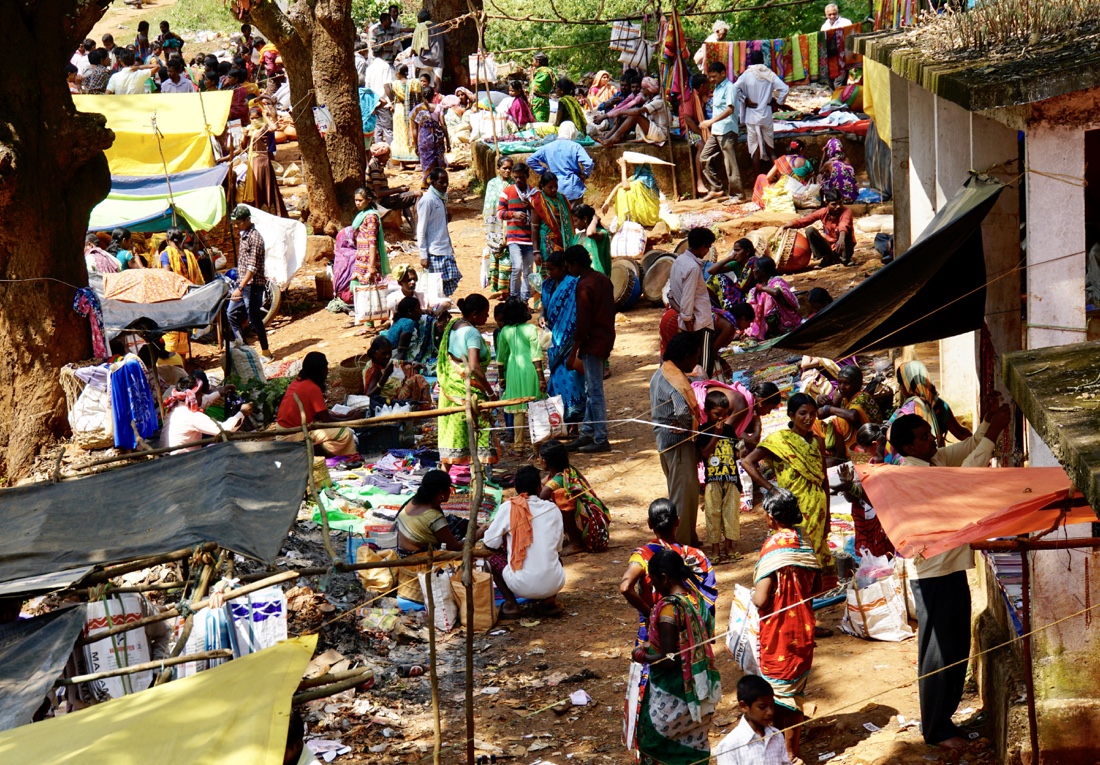
I spent the next several hours not moving. To explain, I was unhappy with my accommodations and wrote to my travel agent to complain about it. The travel agent succeeded in finding an alternative place, which I visited and rather liked. So I decided I would move there. We went back to my original hotel and found that Leon, the owner, had convinced two of the French people to move in together thus freeing a room for me. After some fairly unpleasant exchanges, I decided, after inspecting the new room, that I would stay in my original hotel, after all. This was something of a case study of poor communication. Leon and I have buried the hatchet, and I think the decision to remain where I am is the right one. Throughout all of this, Prashant was terrific, focusing on what was best for me, being very patient and, ultimately handled it.
I spent the rest of the afternoon relaxing in my new room, working on photos and blogging. Dinner was very good, as has every meal here, including today’s lunch, which happened in the midst of the not moving period
|
|



 We spend our time in the goat and sheep area, and it is very interesting and fun to watch the negotiations as they take place. It’s a far more active and lively market than the more staid fruit and vegetable markets. Both the seller and the buyer hold their money out in their hands to make offers, and bicker back and forth, sometimes heatedly.
We spend our time in the goat and sheep area, and it is very interesting and fun to watch the negotiations as they take place. It’s a far more active and lively market than the more staid fruit and vegetable markets. Both the seller and the buyer hold their money out in their hands to make offers, and bicker back and forth, sometimes heatedly. 


 In many cases, there is a middleman present who speaks the local dialect of the seller as well as the general language. He attempts to get the parties to reach agreement. Many men wear colorful lungi that look like pajama bottoms.
In many cases, there is a middleman present who speaks the local dialect of the seller as well as the general language. He attempts to get the parties to reach agreement. Many men wear colorful lungi that look like pajama bottoms. 
 Though the goat prices seem quite reasonable to me, I resist the temptation. So, I guess you could say that I let somebody else get my goat.
Though the goat prices seem quite reasonable to me, I resist the temptation. So, I guess you could say that I let somebody else get my goat.






 Since Bonda women hunt and forage for food in the forest, it is thought that these ornaments have a function of protecting them from injuries and attacks by wild animals. Necklaces made of beads are also worn, these are called Mali. Due to the culture surrounding their ringa cloth which covers the waist down, the khagla and Mali act as a sort of clothing for the upper body of the women.
Since Bonda women hunt and forage for food in the forest, it is thought that these ornaments have a function of protecting them from injuries and attacks by wild animals. Necklaces made of beads are also worn, these are called Mali. Due to the culture surrounding their ringa cloth which covers the waist down, the khagla and Mali act as a sort of clothing for the upper body of the women.

 It is fascinating to see the Bonda women, who are very friendly and quite willing to pose, especially whe Prasant slips them a few rupees. Best is to see them walking down to the market from the hills.
It is fascinating to see the Bonda women, who are very friendly and quite willing to pose, especially whe Prasant slips them a few rupees. Best is to see them walking down to the market from the hills. 


 The market itself is, well, a market, and not markedly different from many other markets I’ve seen.
The market itself is, well, a market, and not markedly different from many other markets I’ve seen.

 From the market we go a village of the boro gaddaba tribe in bahiripada. At the entrance to the village is a shrine to the goddess, represented by rocks in keeping with their animist beliefs.
From the market we go a village of the boro gaddaba tribe in bahiripada. At the entrance to the village is a shrine to the goddess, represented by rocks in keeping with their animist beliefs. Even in the smallest villages, color abounds.
Even in the smallest villages, color abounds. Though I’ve now been to many of these villages, I still love to walk through them, observe the lifestyle and photograph people.
Though I’ve now been to many of these villages, I still love to walk through them, observe the lifestyle and photograph people.














 Before we got to the market, Prasant told me that the members of the tribe were aggressive and that I should not show people photographs that I take and be careful. He said sometimes they threw things at people trying to take pictures. I did not experience any aggressive behavior, but the Konds were noticeably less friendly than other people we’ve encountered and almost never smiled. Happily, though, they did not try to sacrifice me.
Before we got to the market, Prasant told me that the members of the tribe were aggressive and that I should not show people photographs that I take and be careful. He said sometimes they threw things at people trying to take pictures. I did not experience any aggressive behavior, but the Konds were noticeably less friendly than other people we’ve encountered and almost never smiled. Happily, though, they did not try to sacrifice me.
 Prasant is something of a pied piper, as he buys packages of cookies and hands out cookies to the children. After visiting the third village, Prasant asked whether I’d like to go to another one. I demur, though, saying that I am marketed out. It’s been a tiring day. We started out very early and I didn’t sleep very well because of the cough. Though we did not do a lot of walking, we were on our feet for significant periods of time and when we were in the sun, it got pretty hot. And, oh yes, I’m old.
Prasant is something of a pied piper, as he buys packages of cookies and hands out cookies to the children. After visiting the third village, Prasant asked whether I’d like to go to another one. I demur, though, saying that I am marketed out. It’s been a tiring day. We started out very early and I didn’t sleep very well because of the cough. Though we did not do a lot of walking, we were on our feet for significant periods of time and when we were in the sun, it got pretty hot. And, oh yes, I’m old.























 And the head of the second village poses with the goddess.
And the head of the second village poses with the goddess.














 Head back to the hotel for a light lunch on the patio outside my room at 1PM. Relax and blog until 3:30, when Prasant comes by, and we walk to a nearby pottery village. It’s very cool that our hotel is essentially part of the village.
Head back to the hotel for a light lunch on the patio outside my room at 1PM. Relax and blog until 3:30, when Prasant comes by, and we walk to a nearby pottery village. It’s very cool that our hotel is essentially part of the village.

 then I walk the short distance back to the hotel and rest, blog and shower before dinner with the French group. My would-be roommates from Spain join us, but since we’re at different tables I have only a brief opportunity to exchange a few words with them, utilizing my high school Spanish, as revived by a number of trips to Spanish-speaking countries.
then I walk the short distance back to the hotel and rest, blog and shower before dinner with the French group. My would-be roommates from Spain join us, but since we’re at different tables I have only a brief opportunity to exchange a few words with them, utilizing my high school Spanish, as revived by a number of trips to Spanish-speaking countries.
 .
. 


























